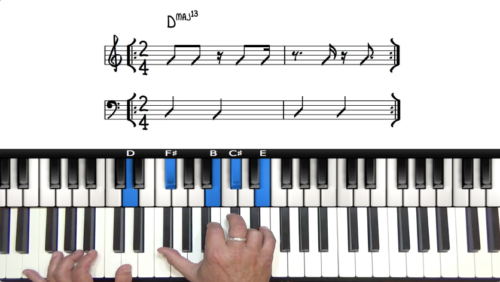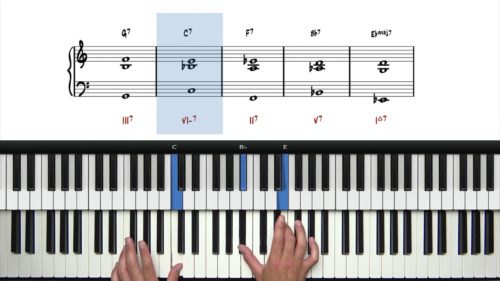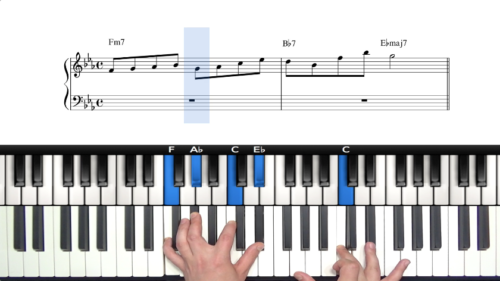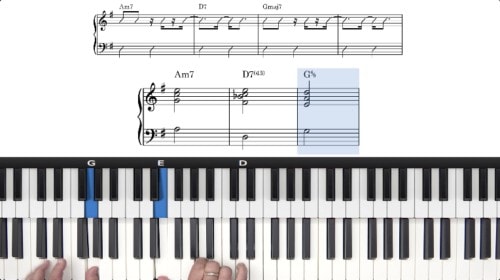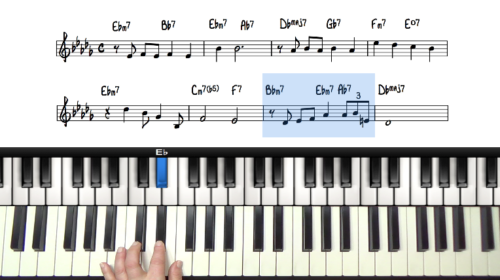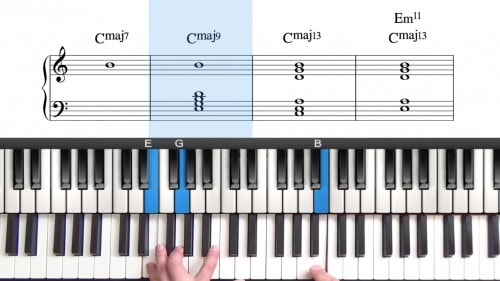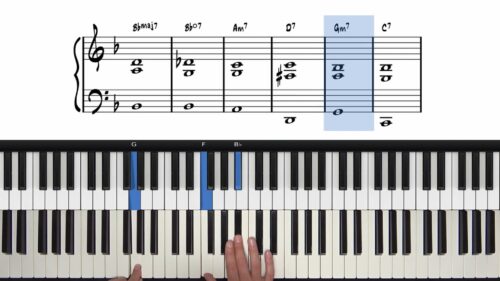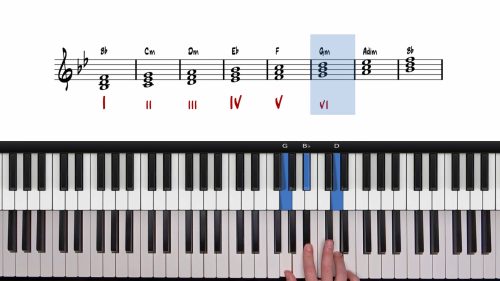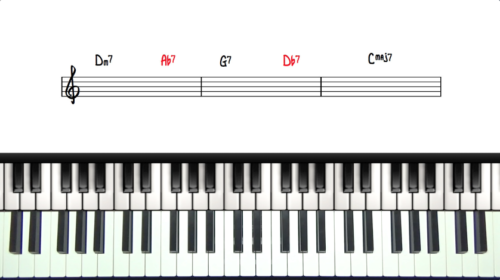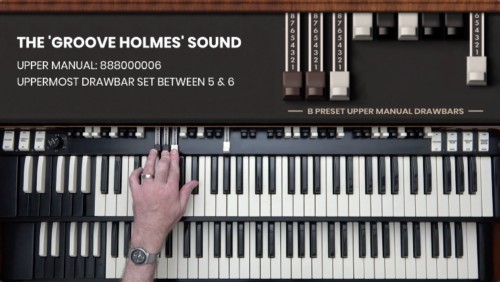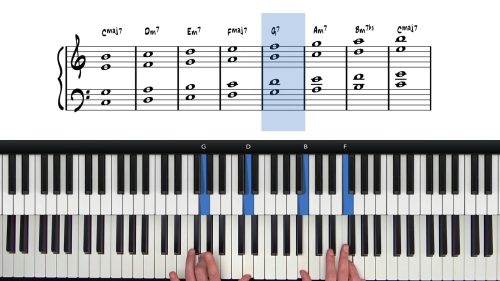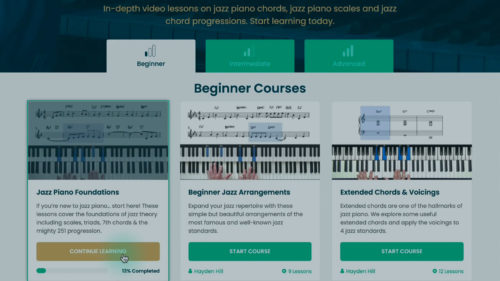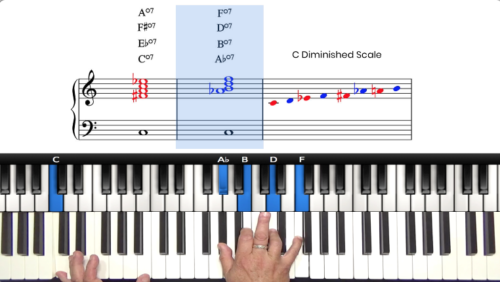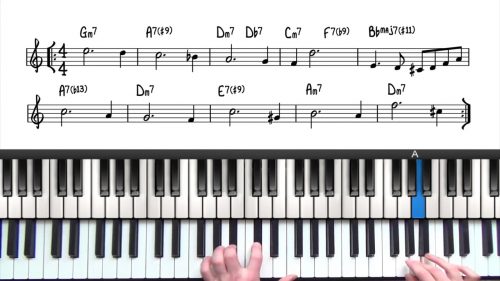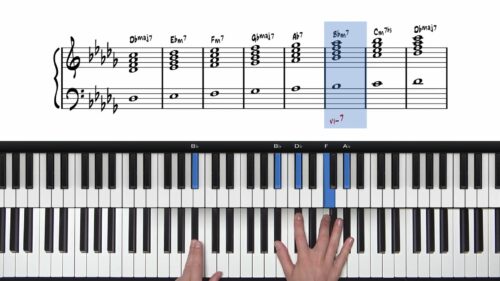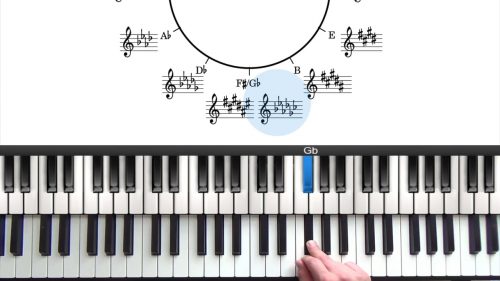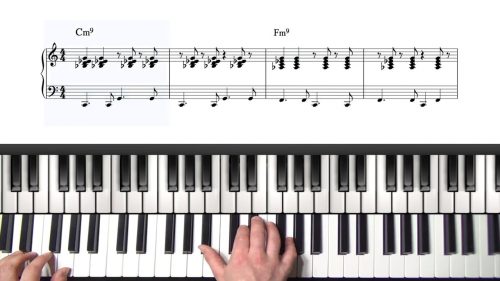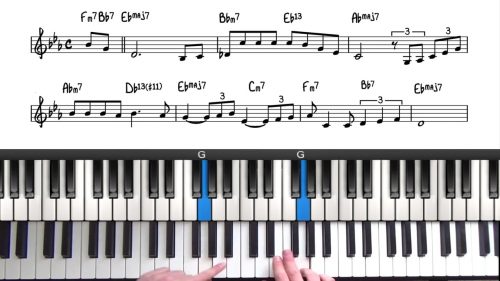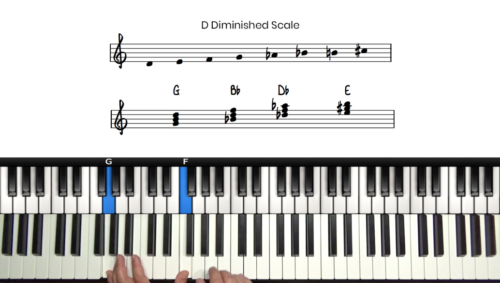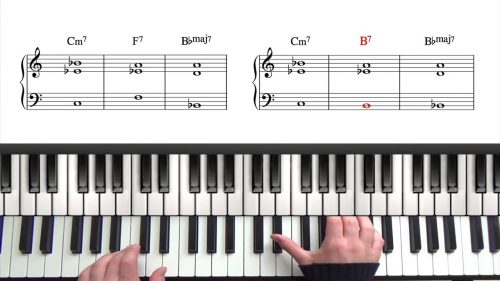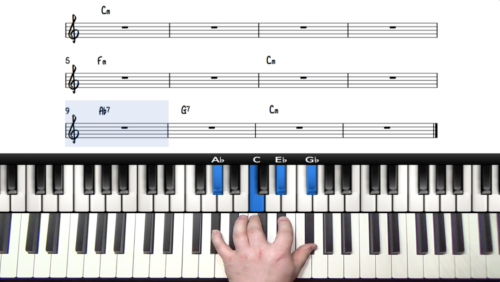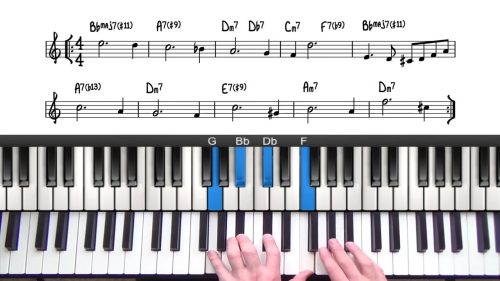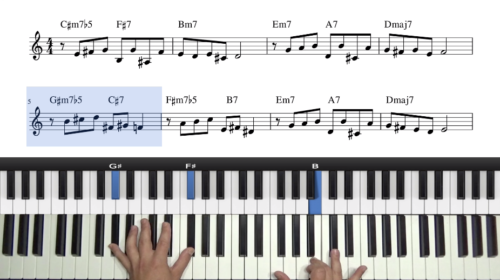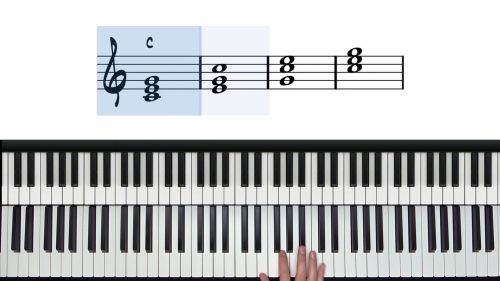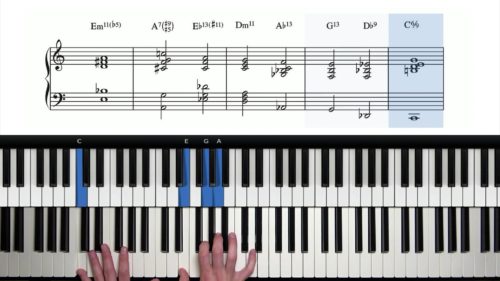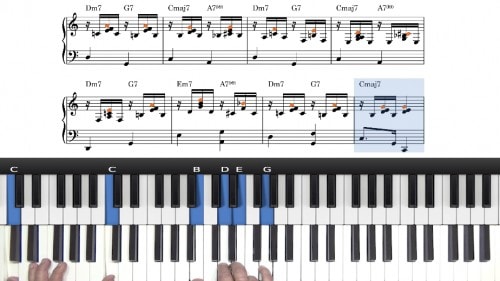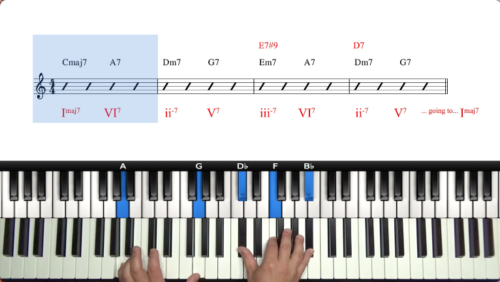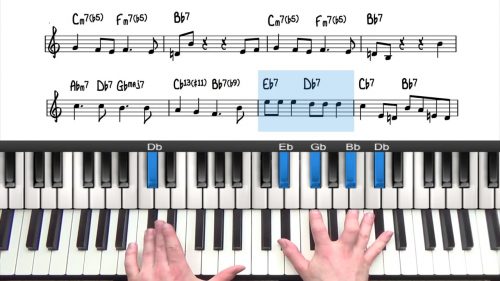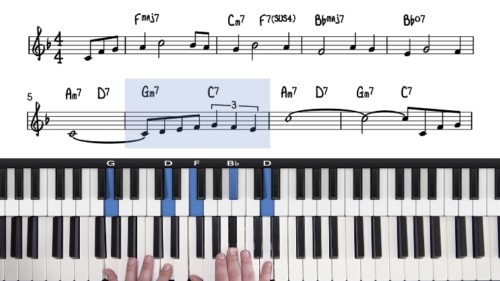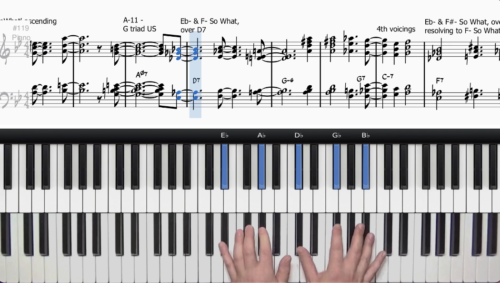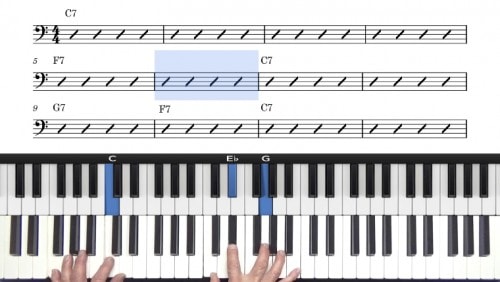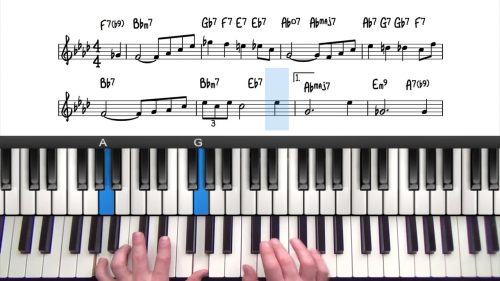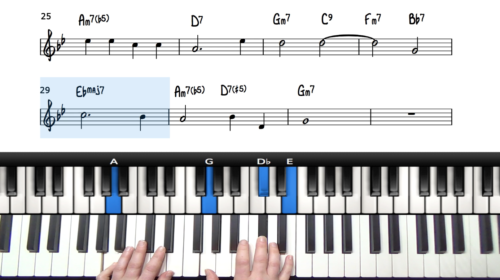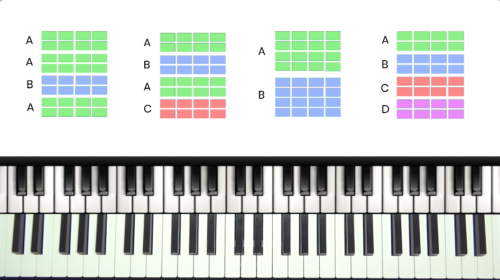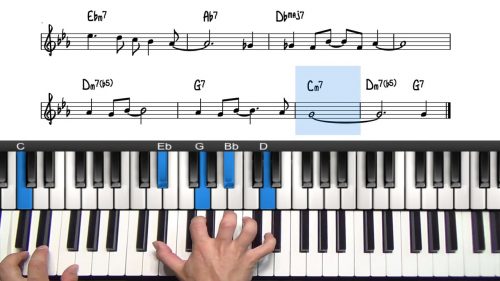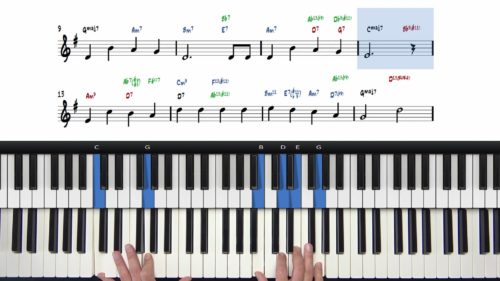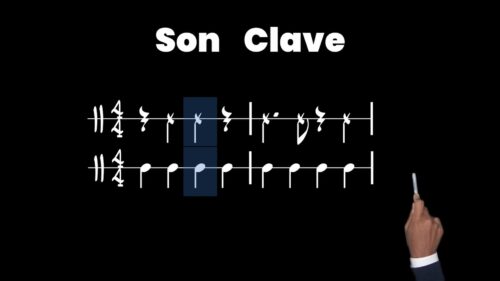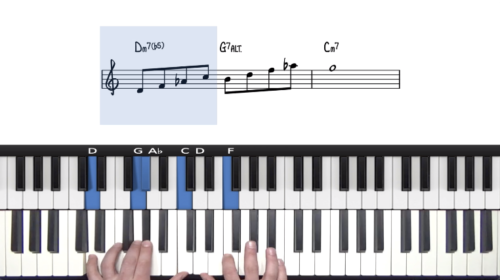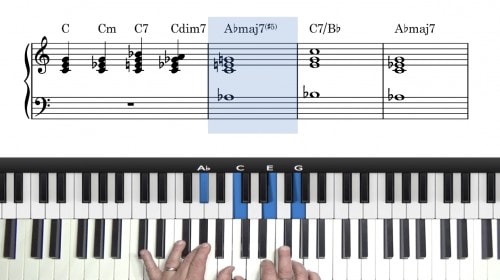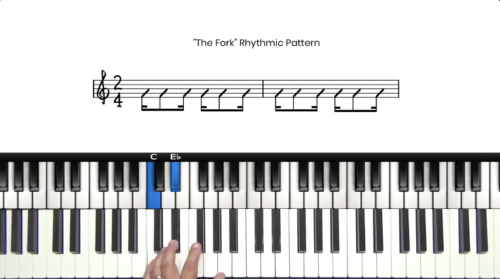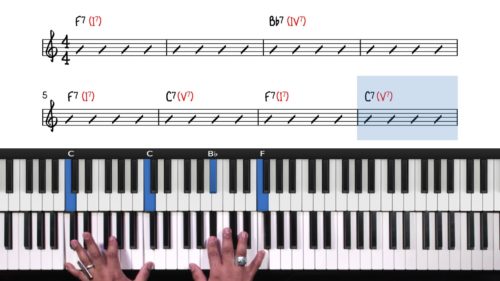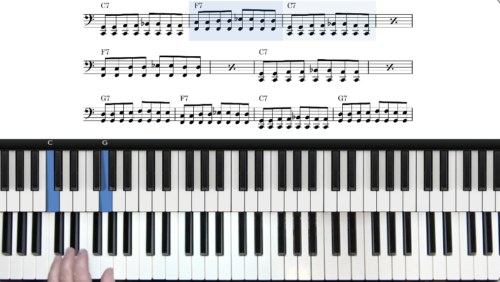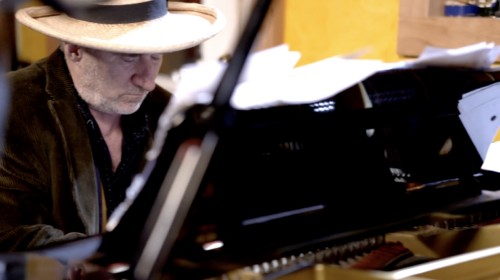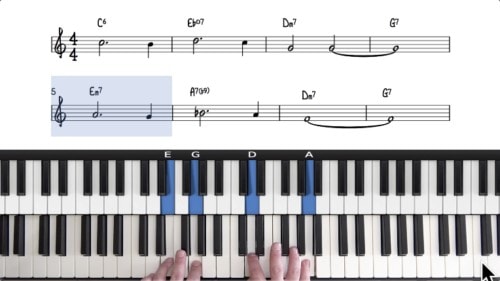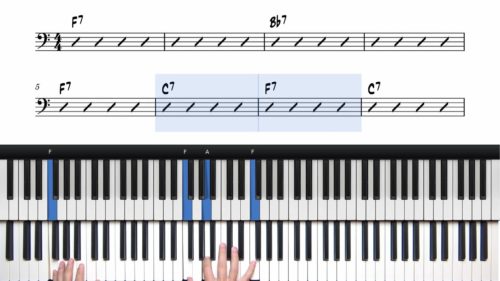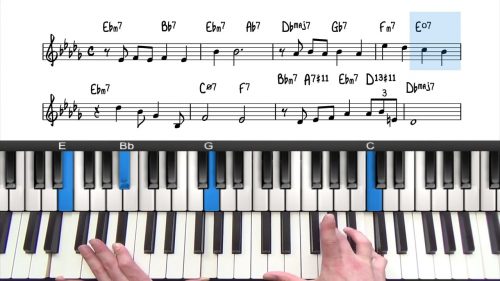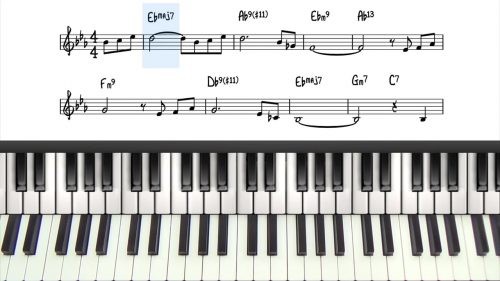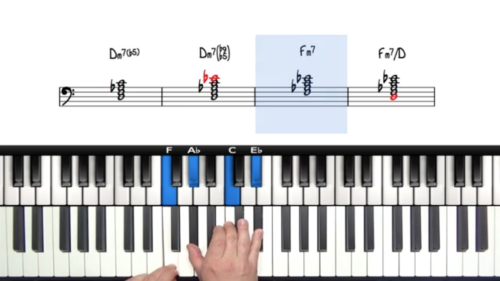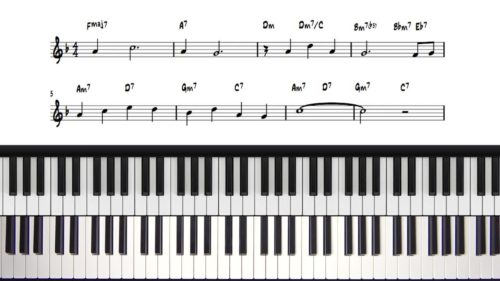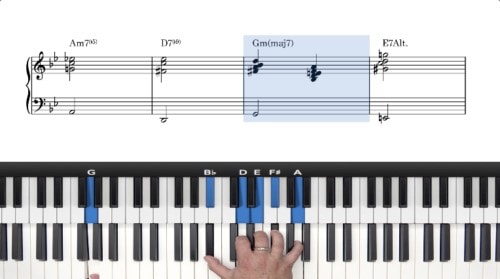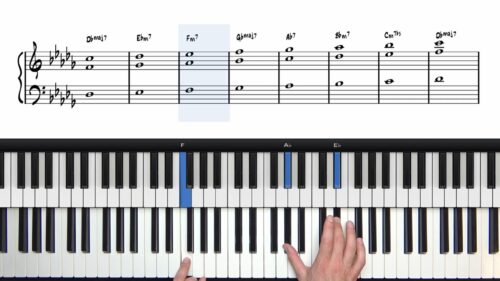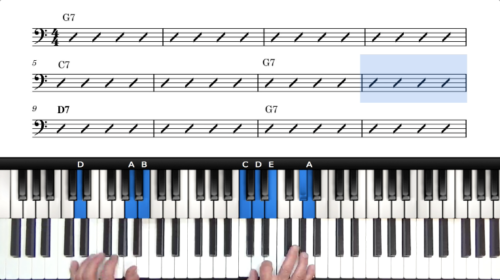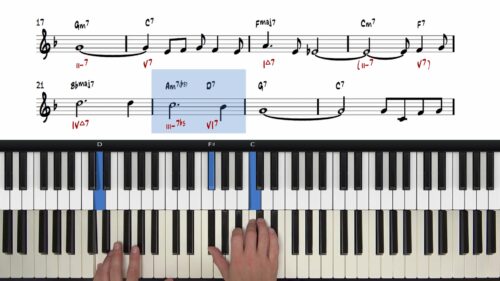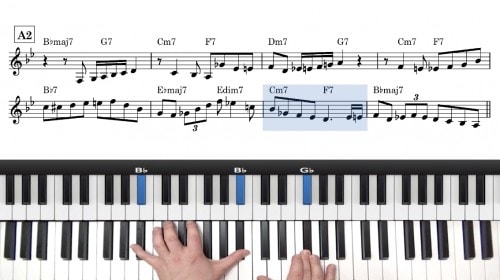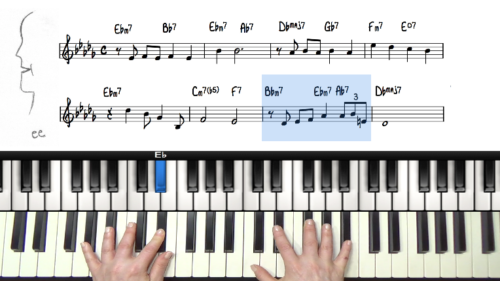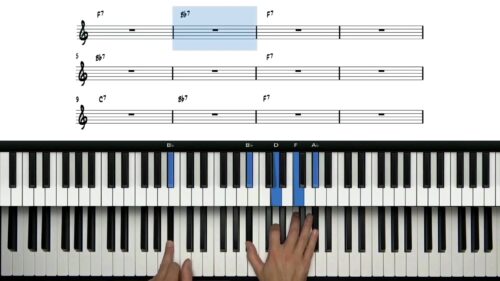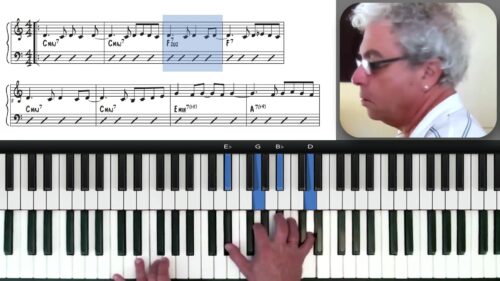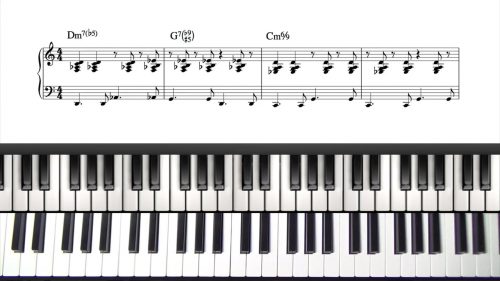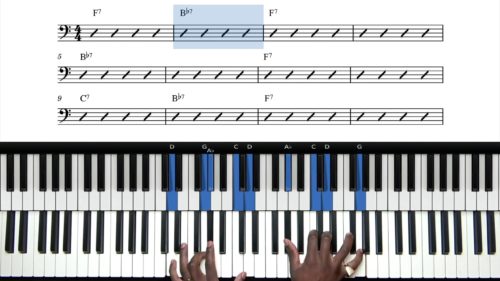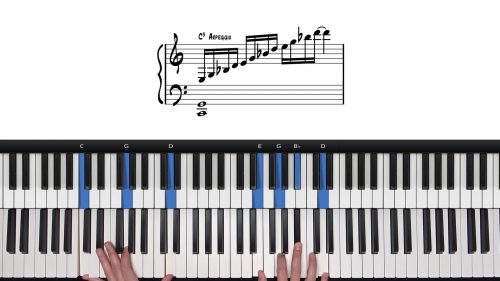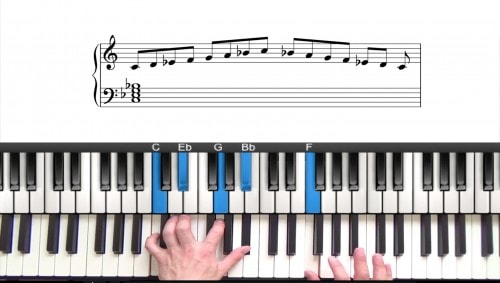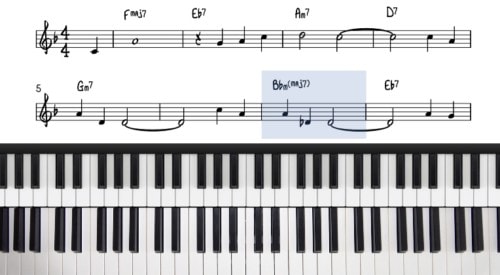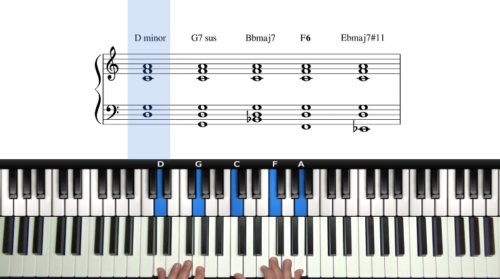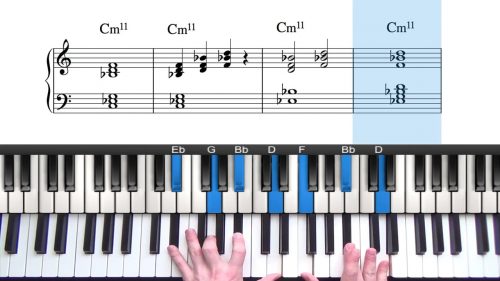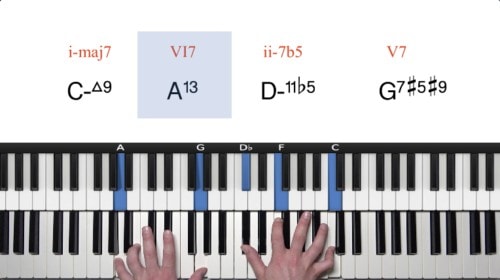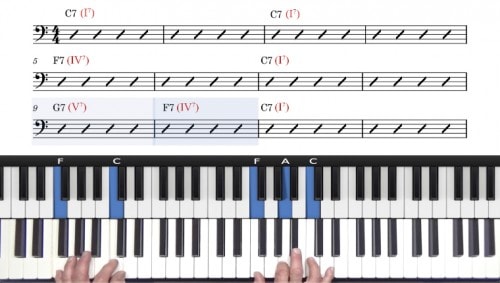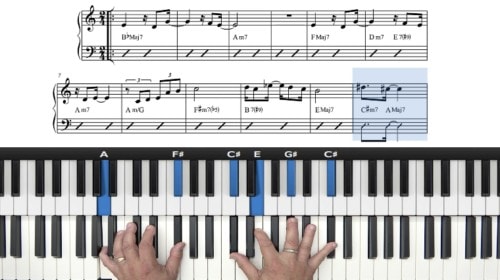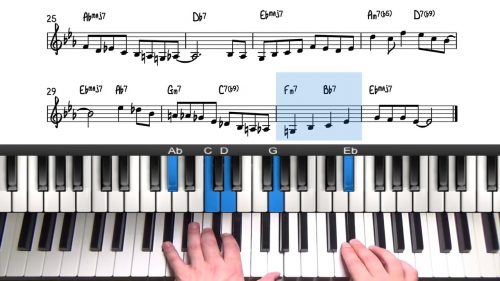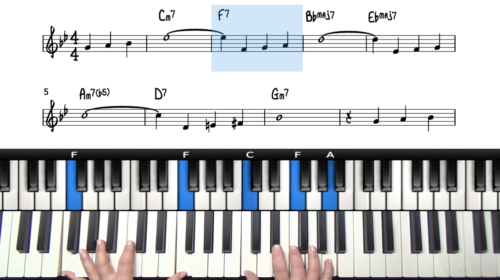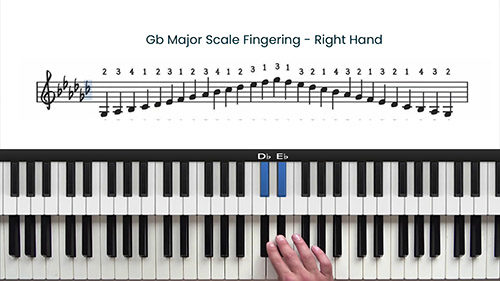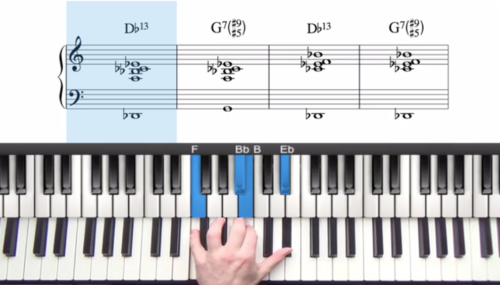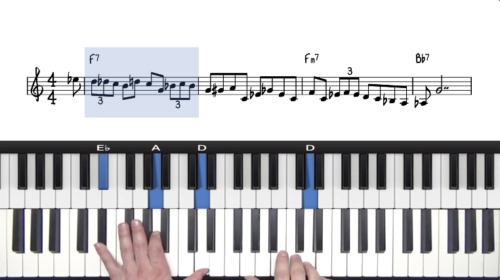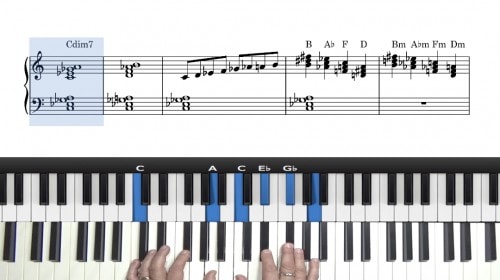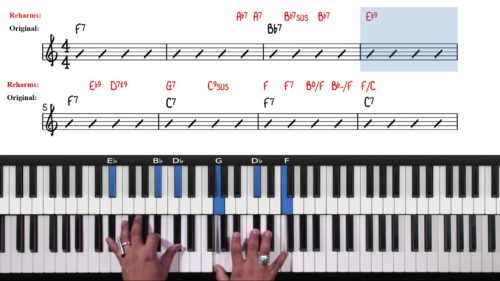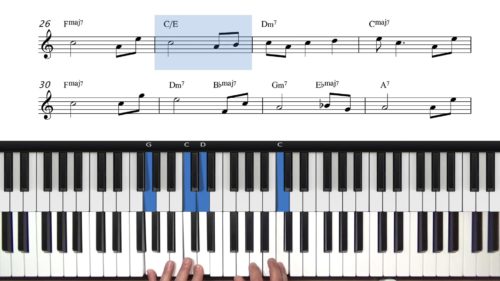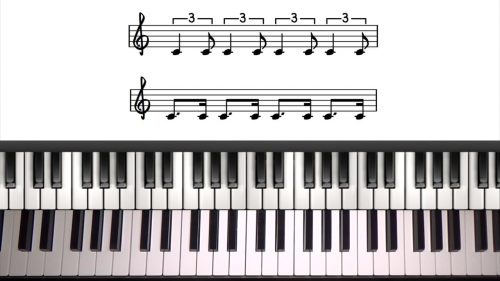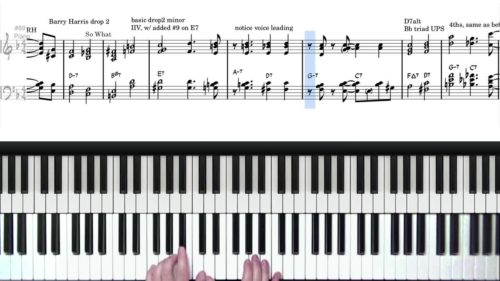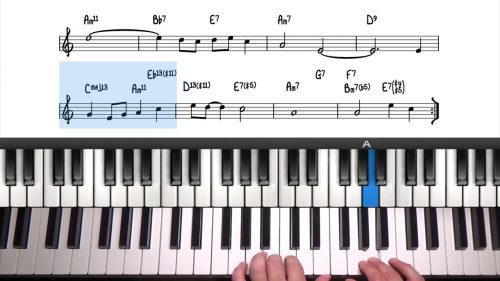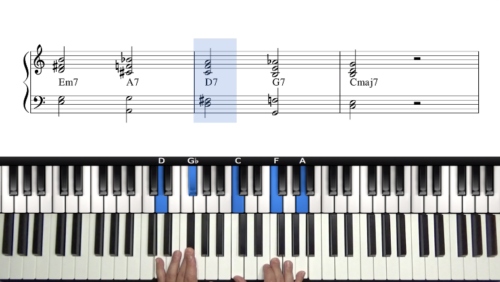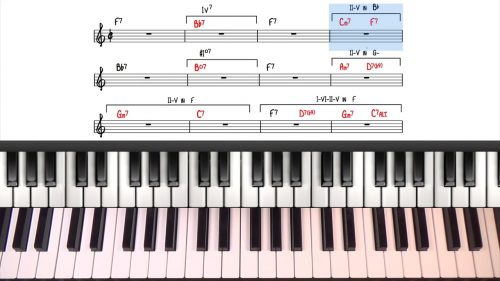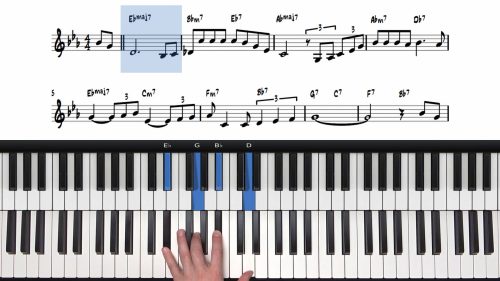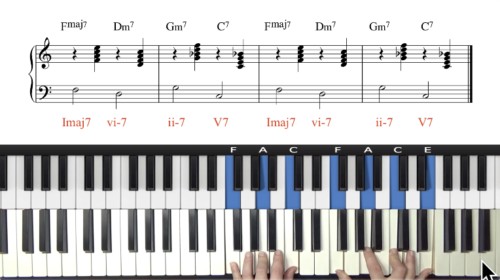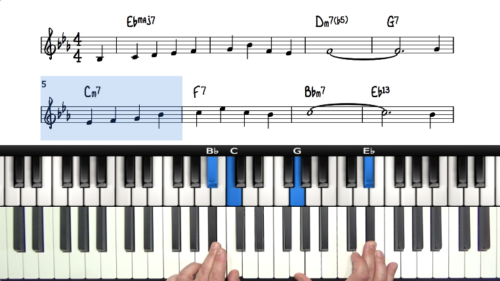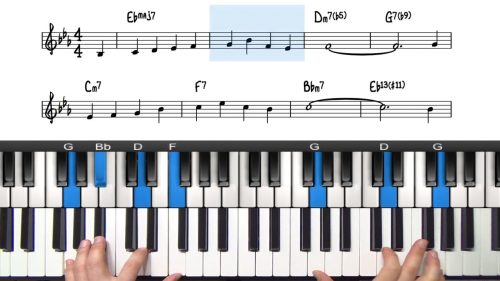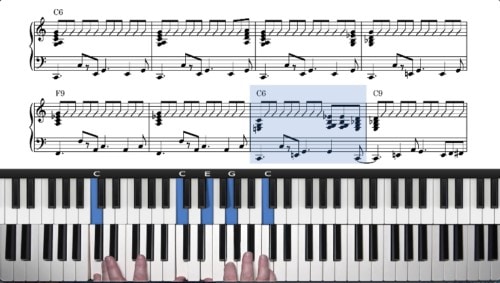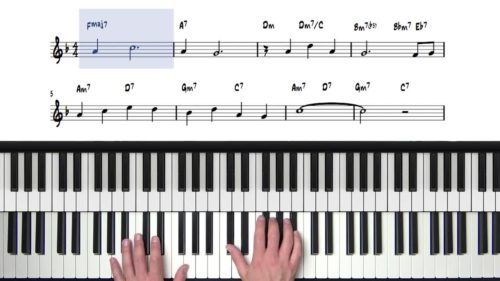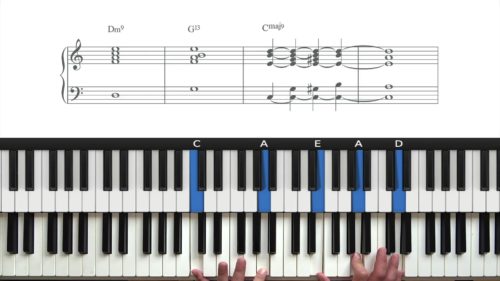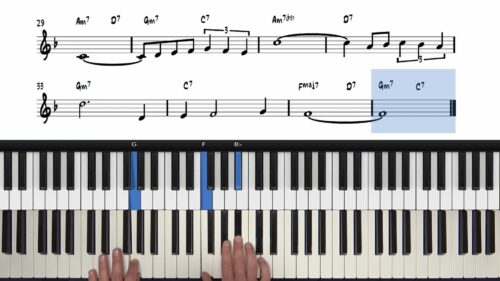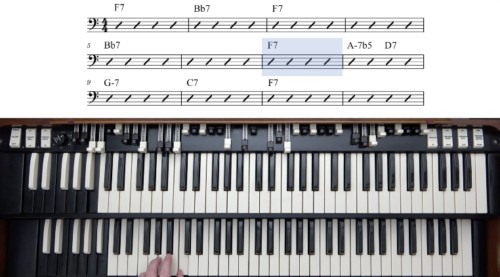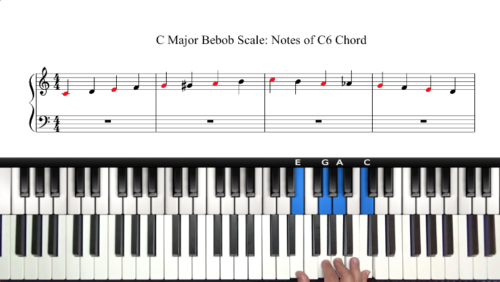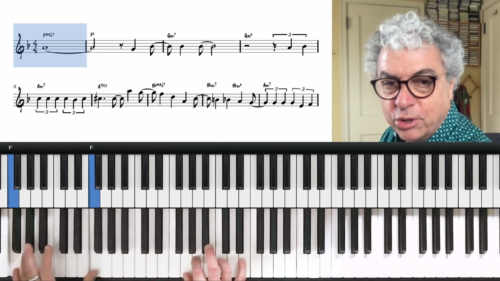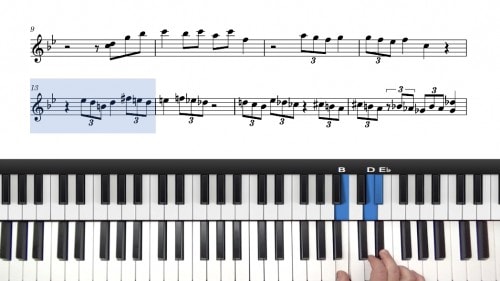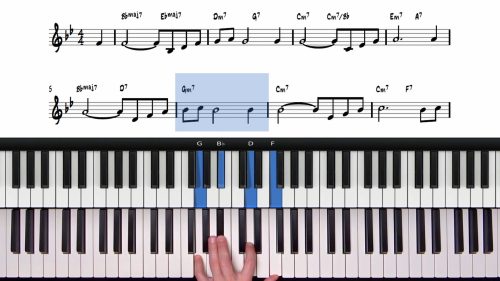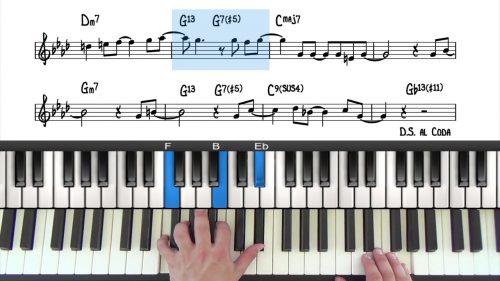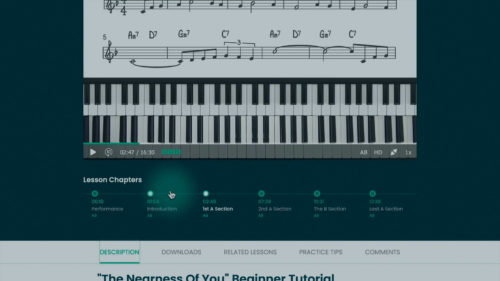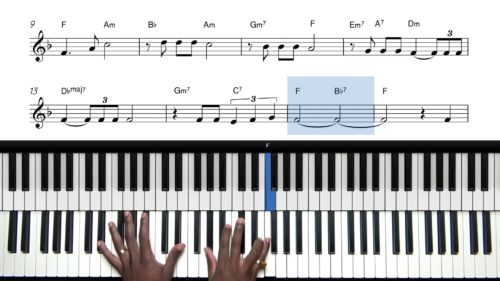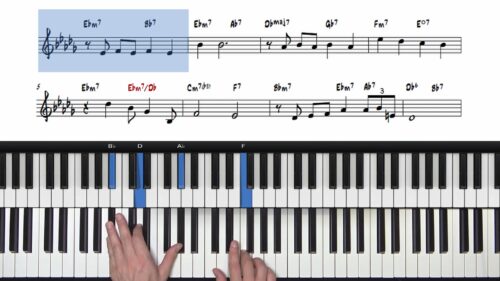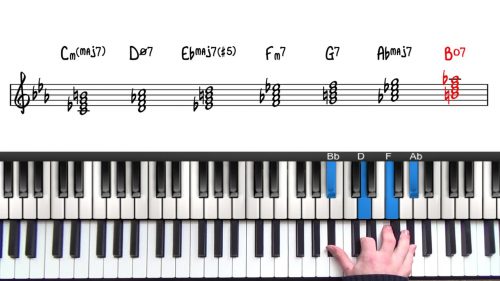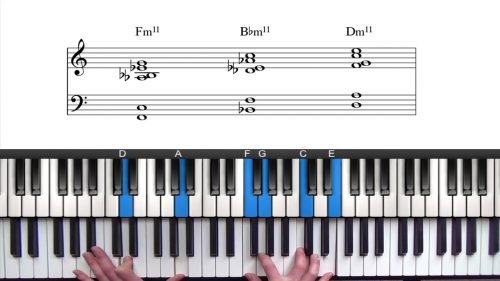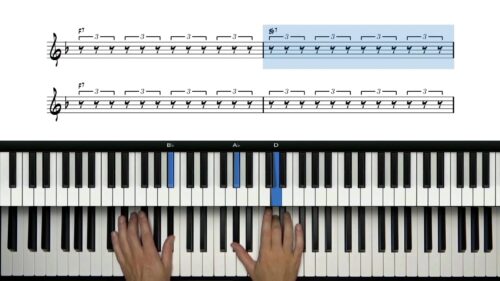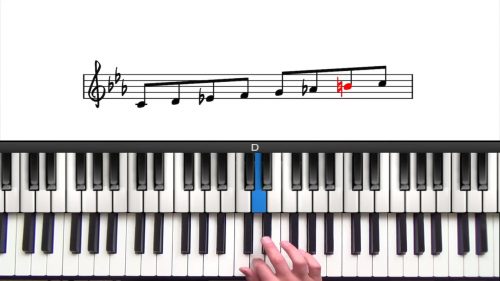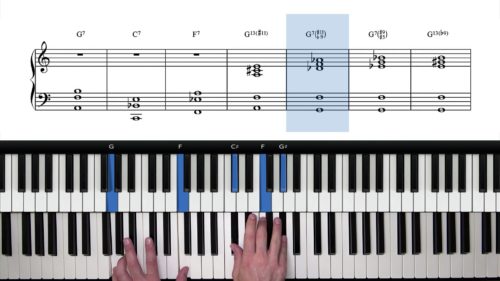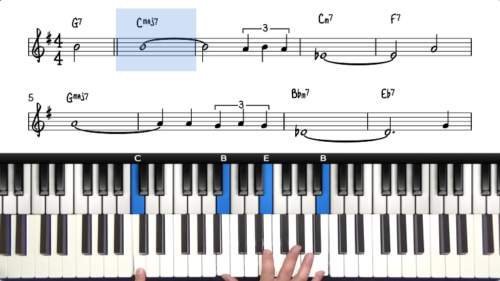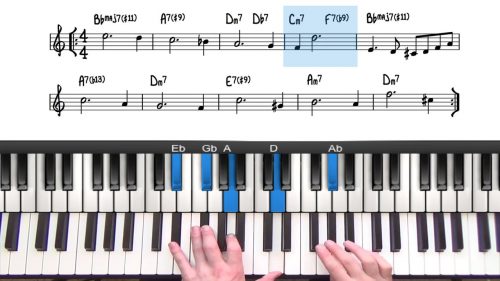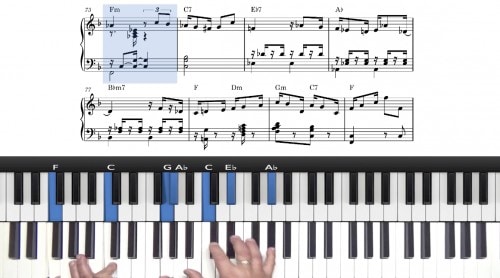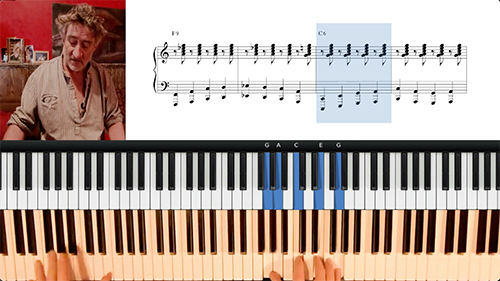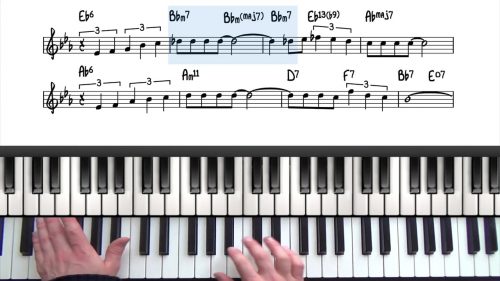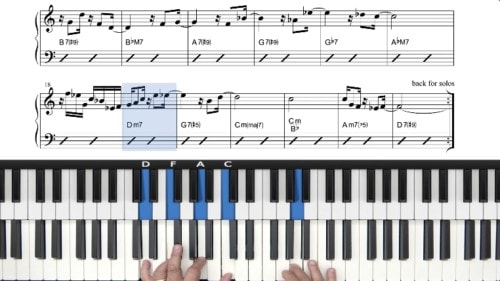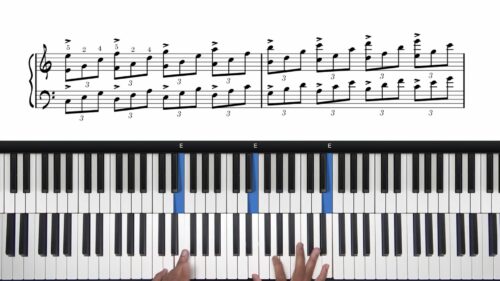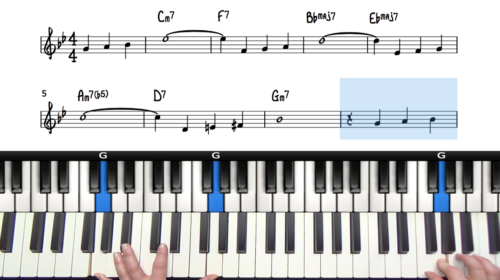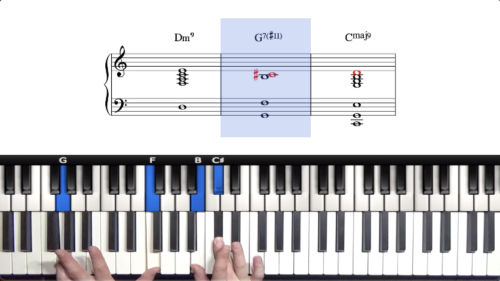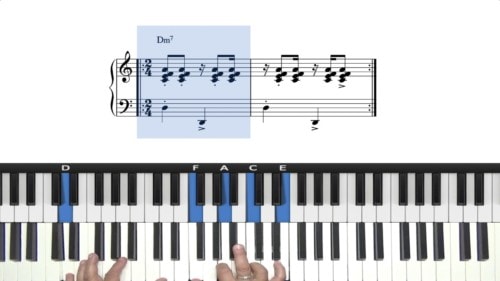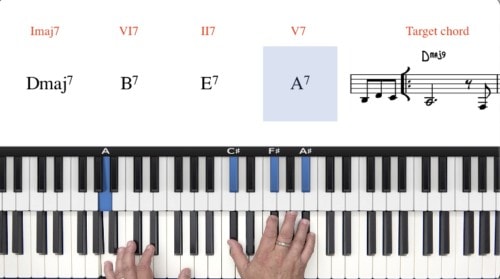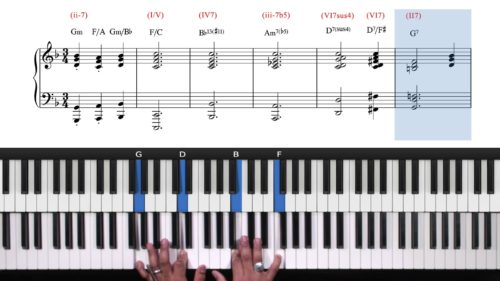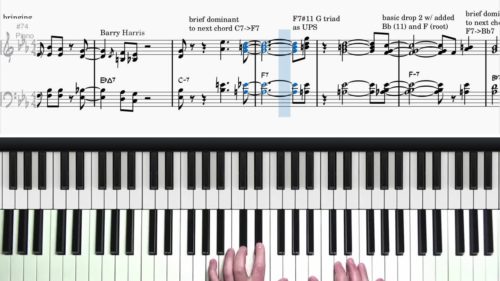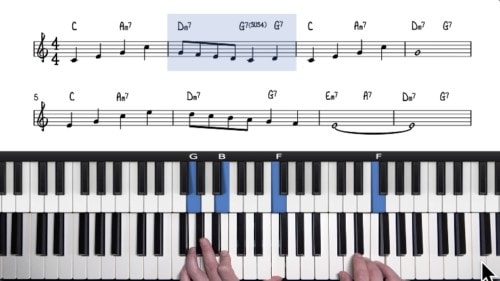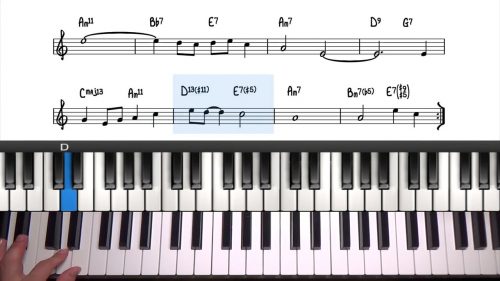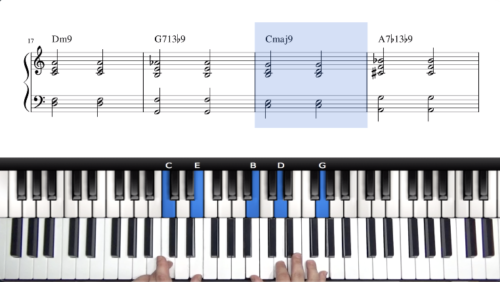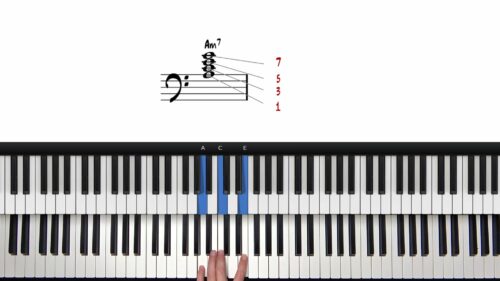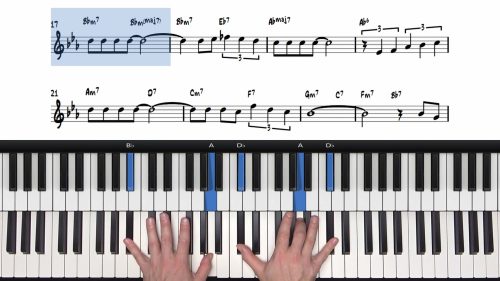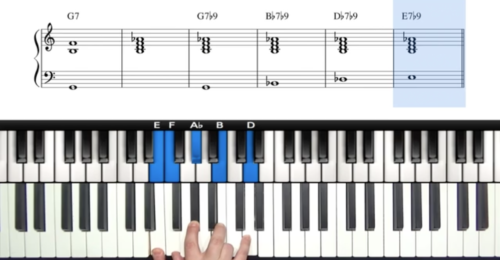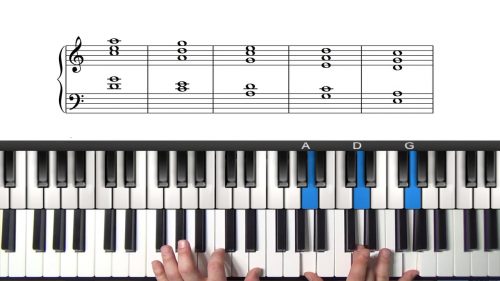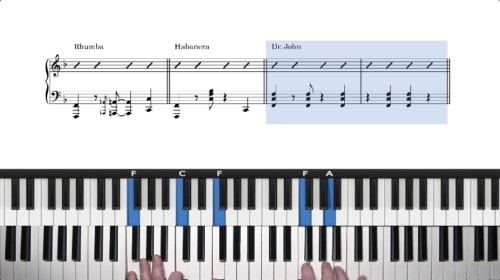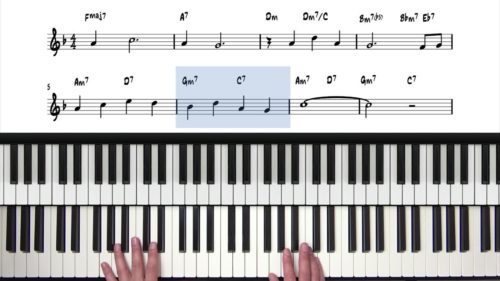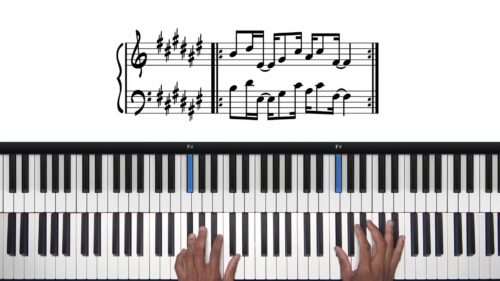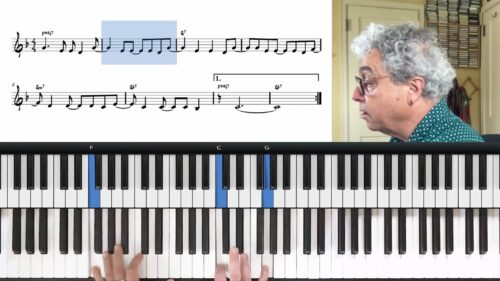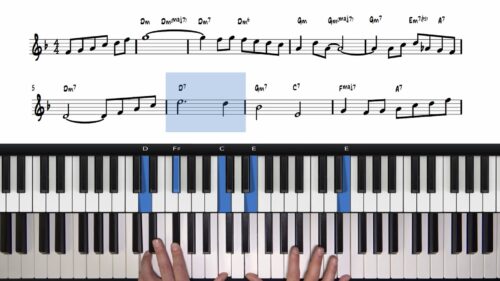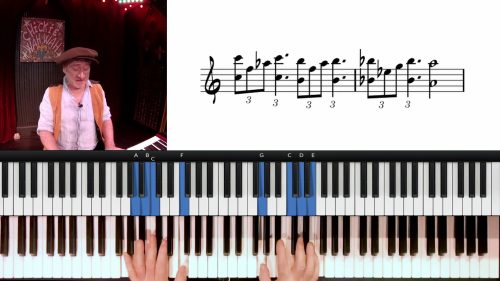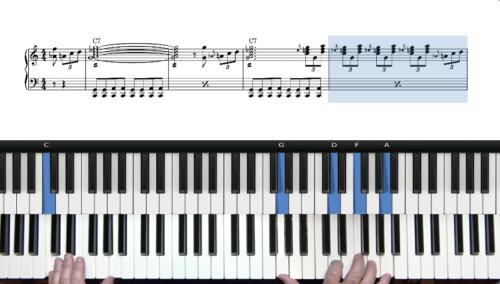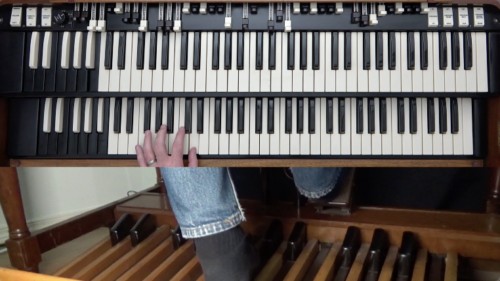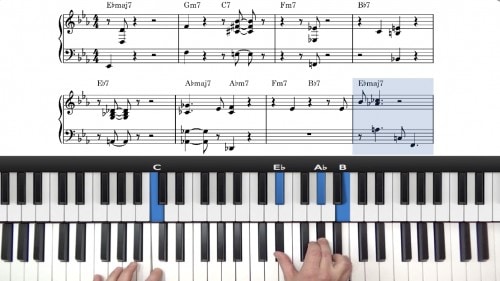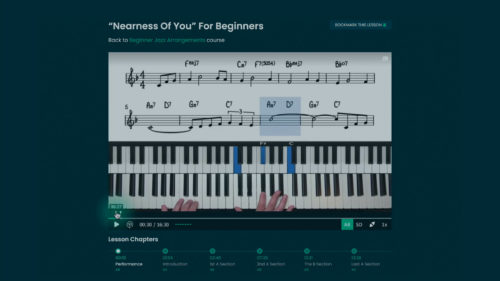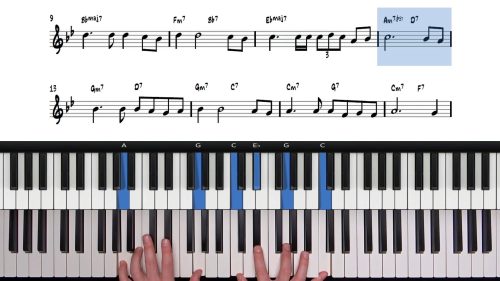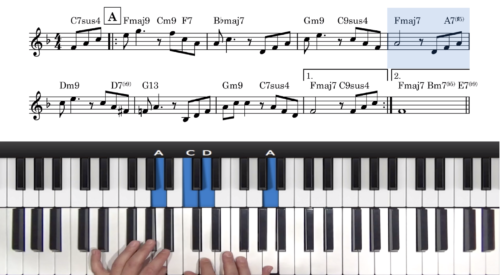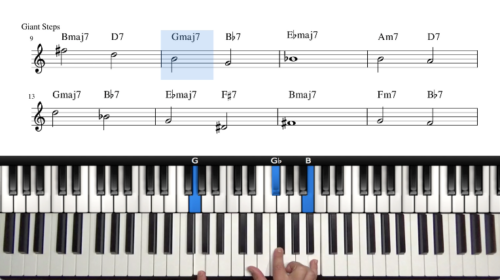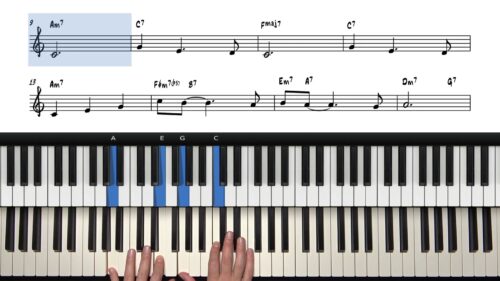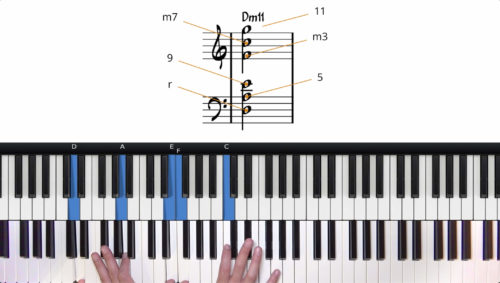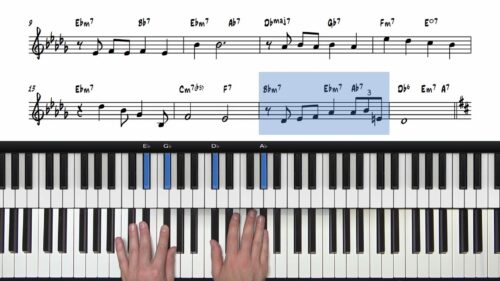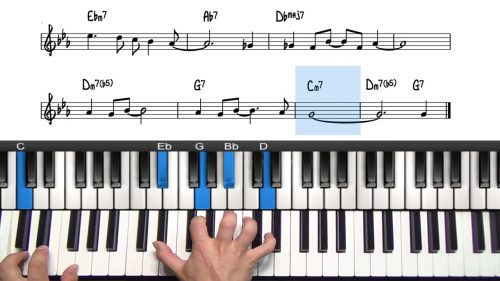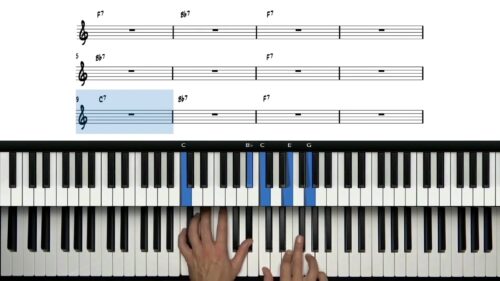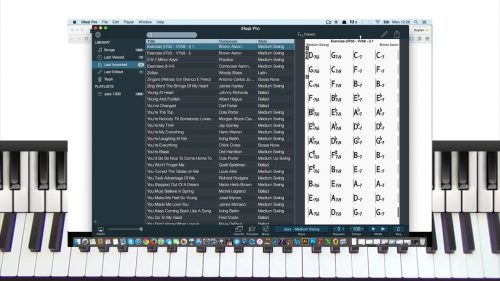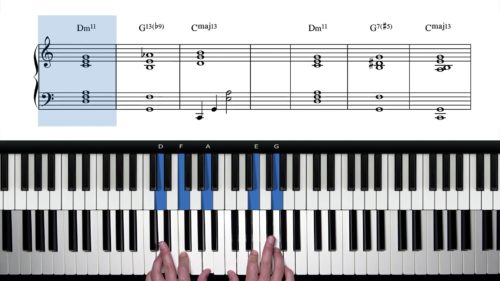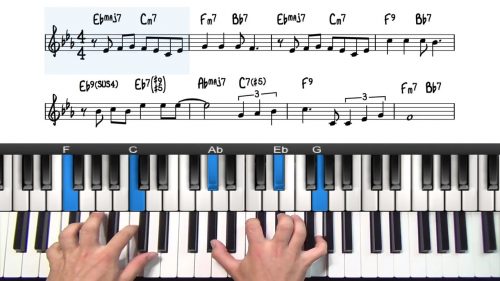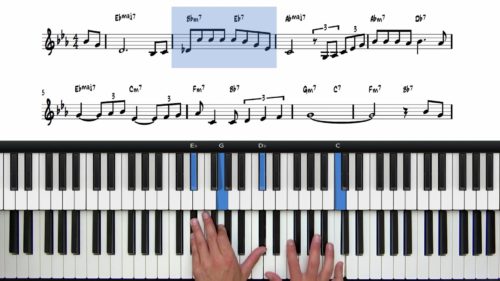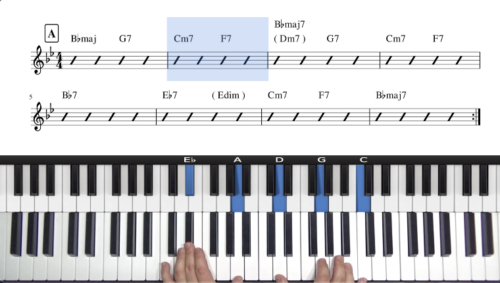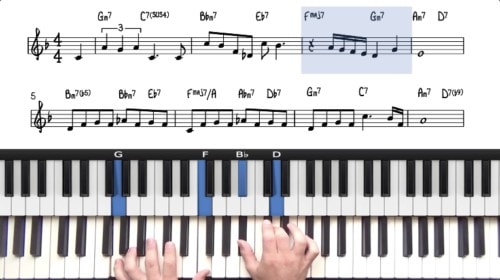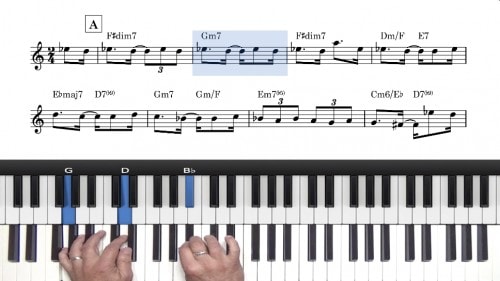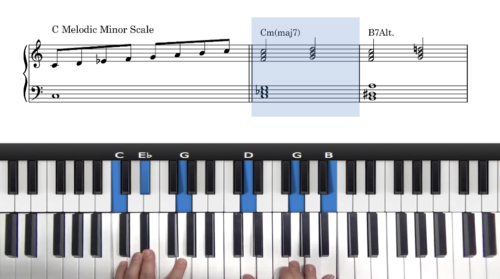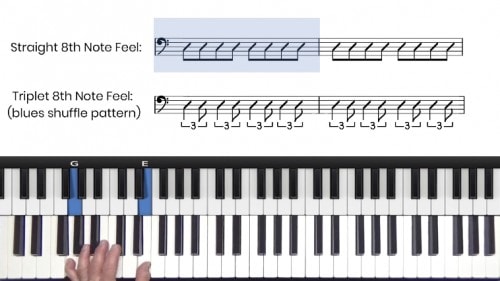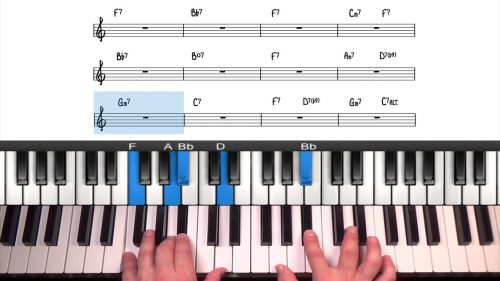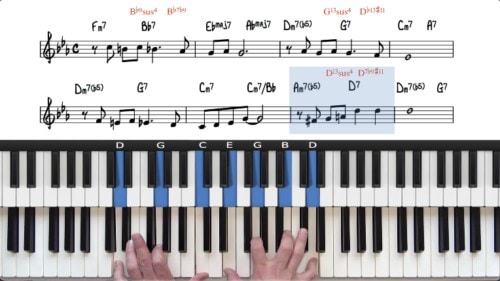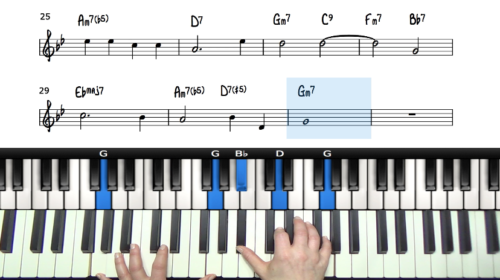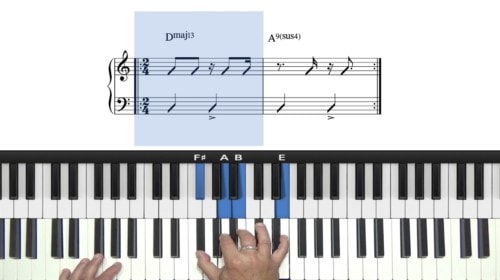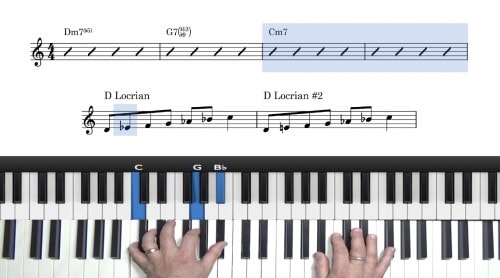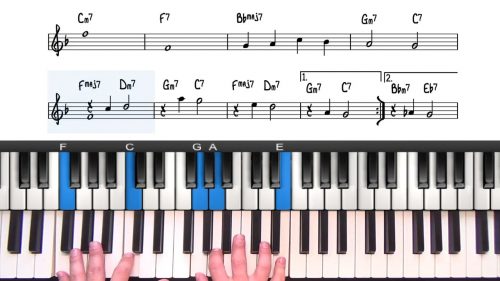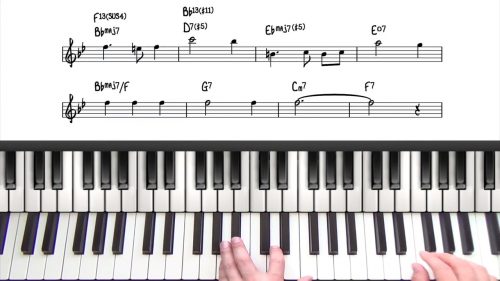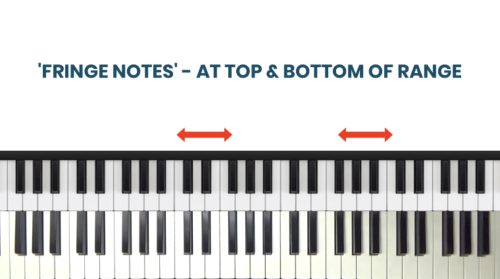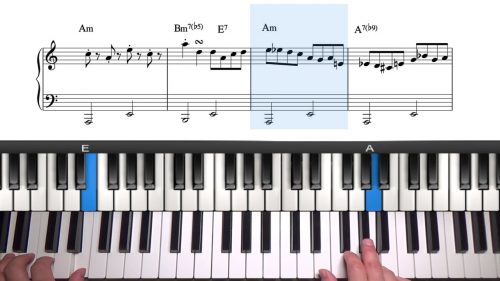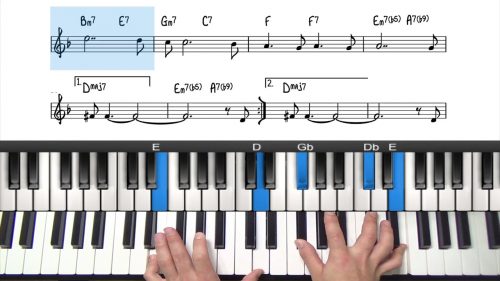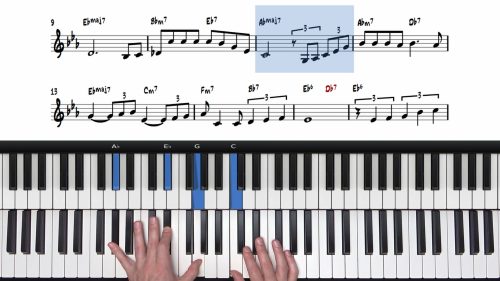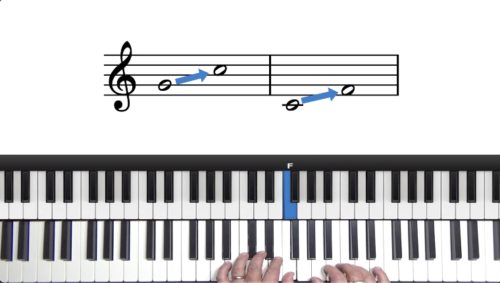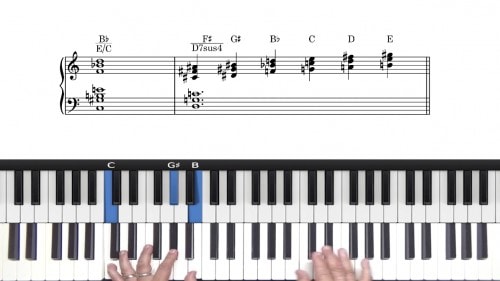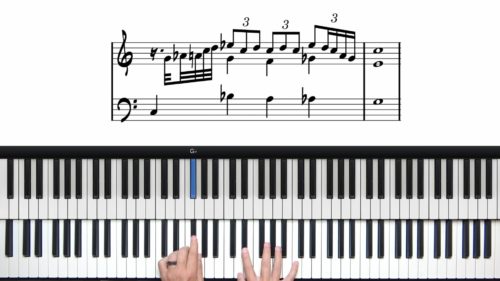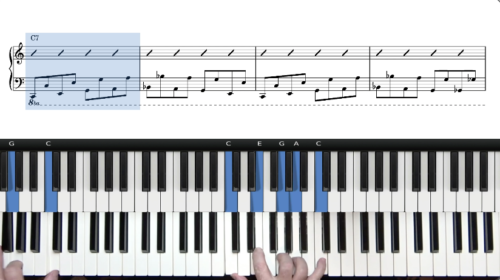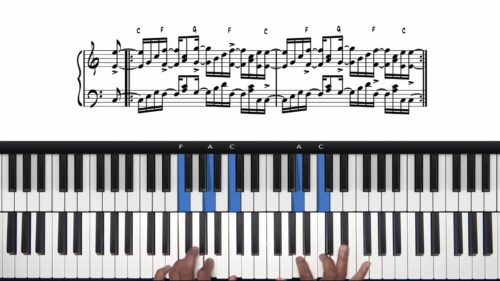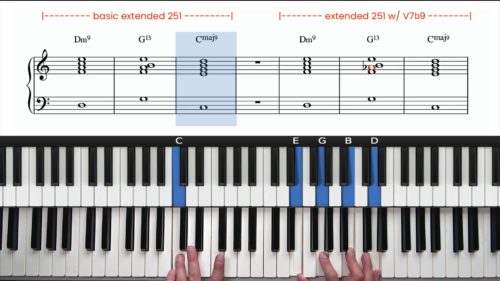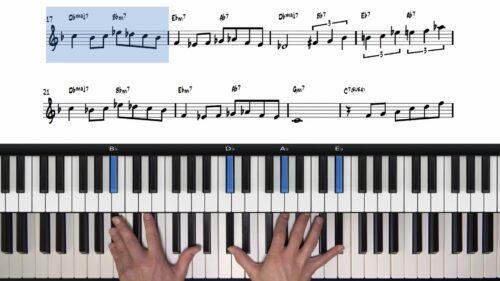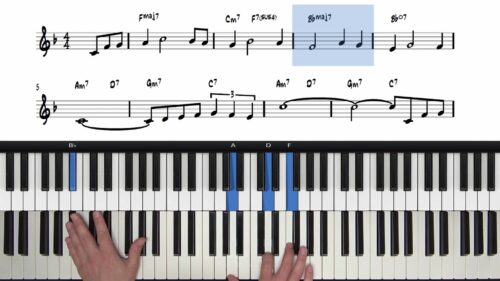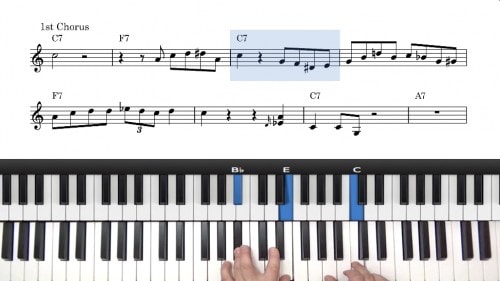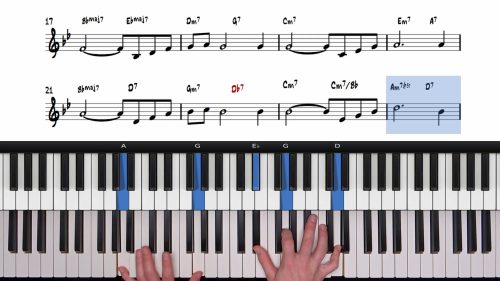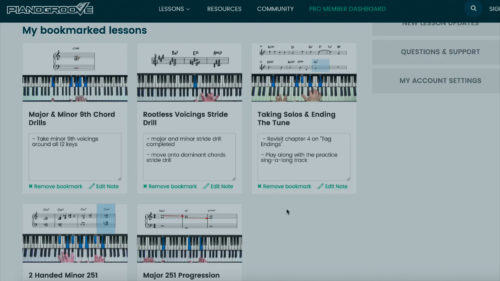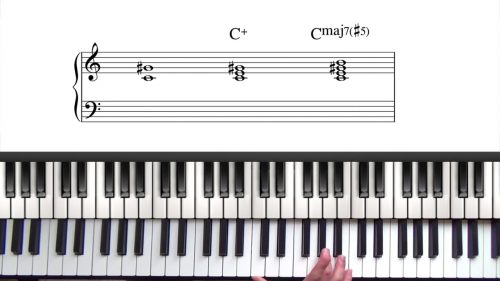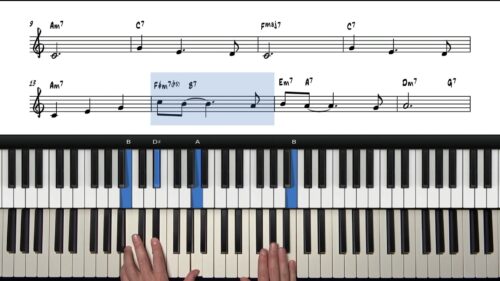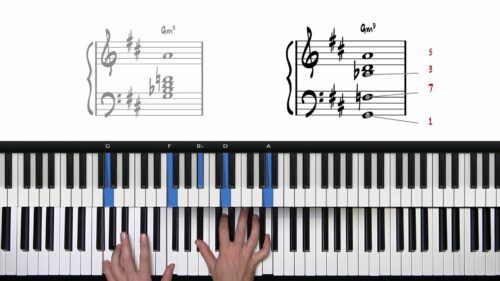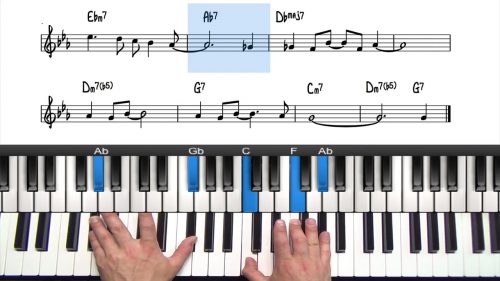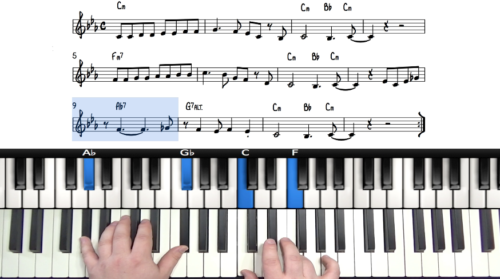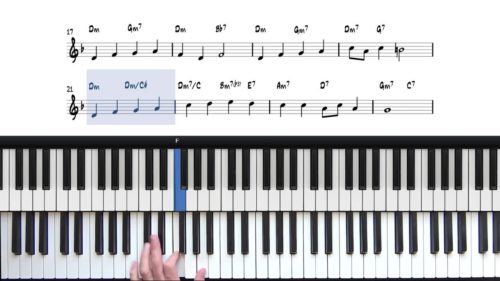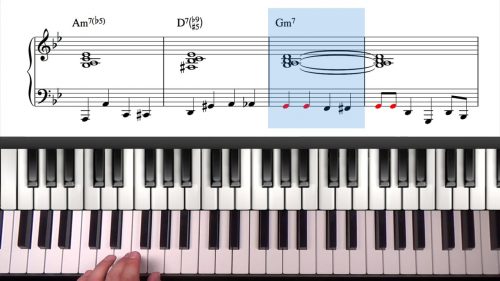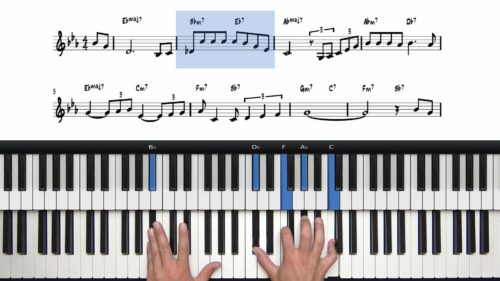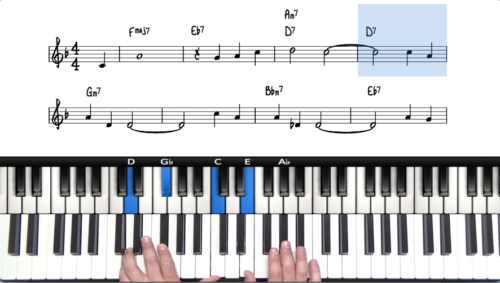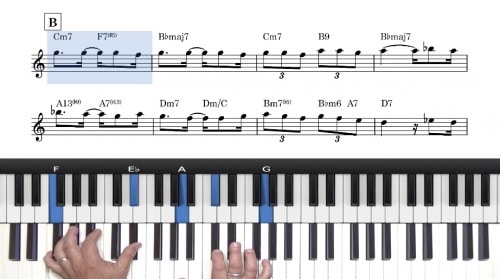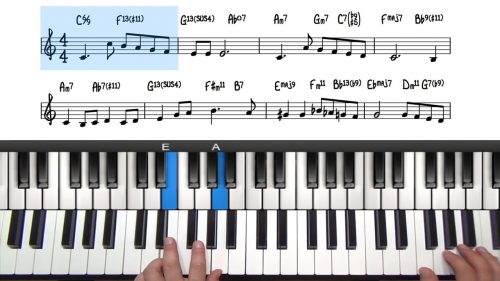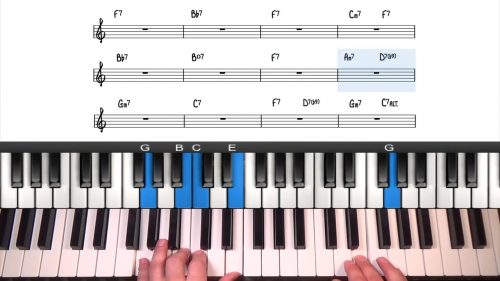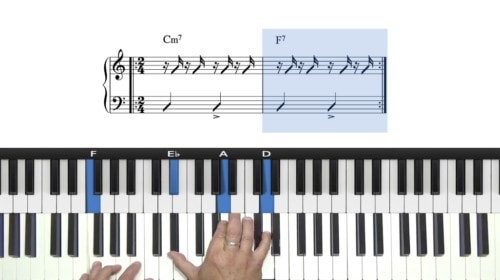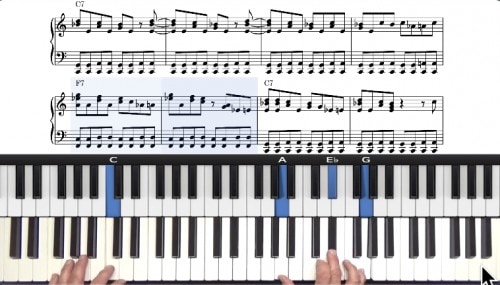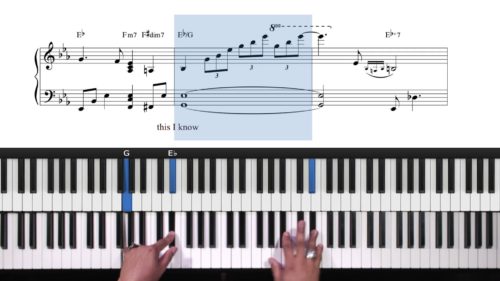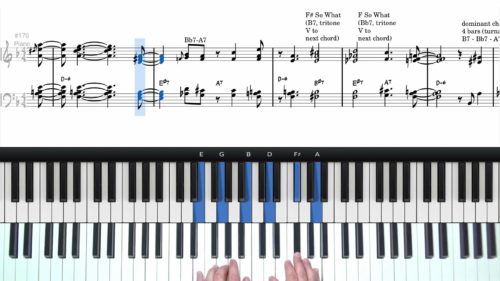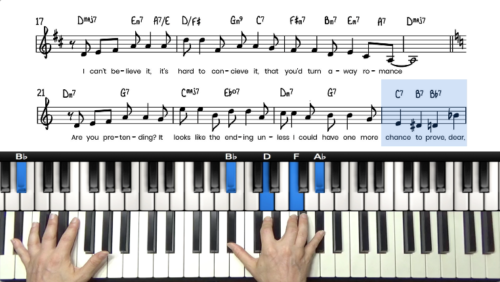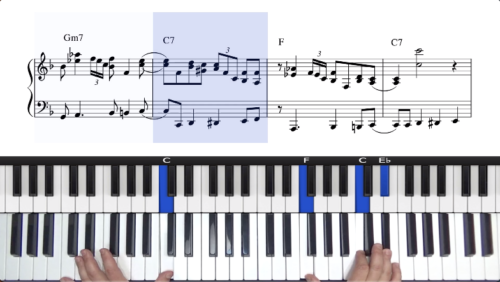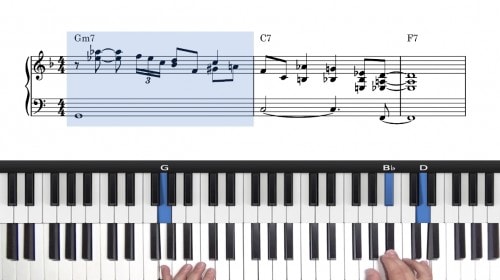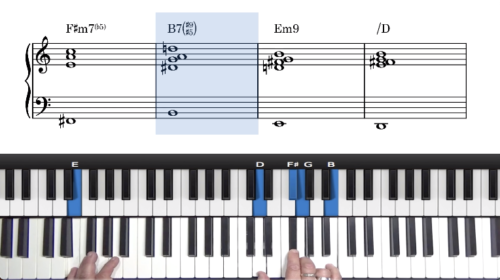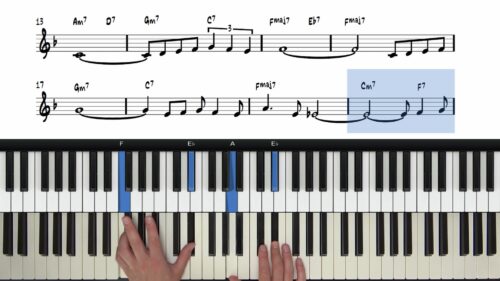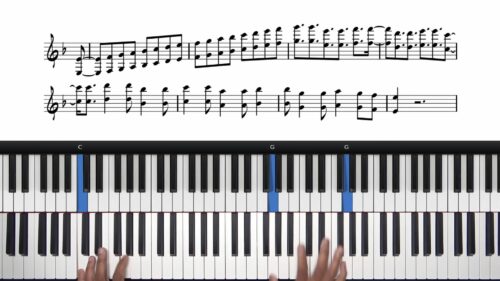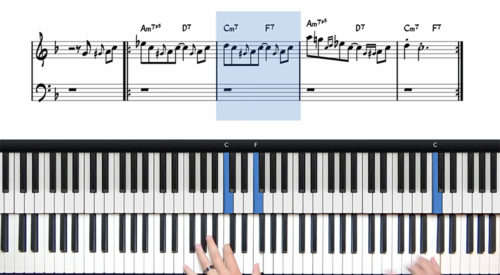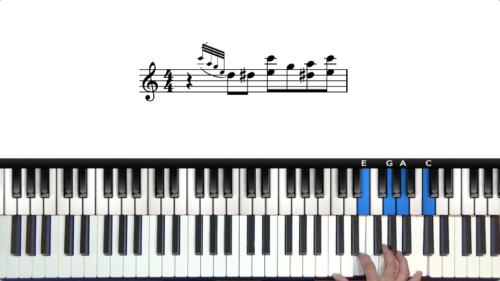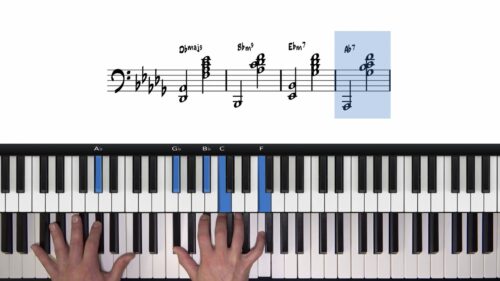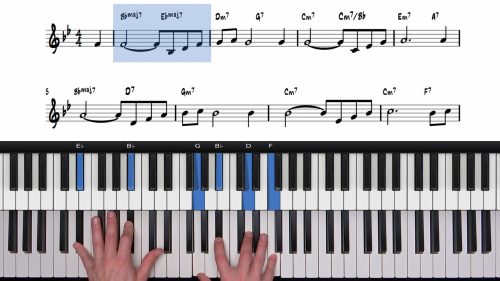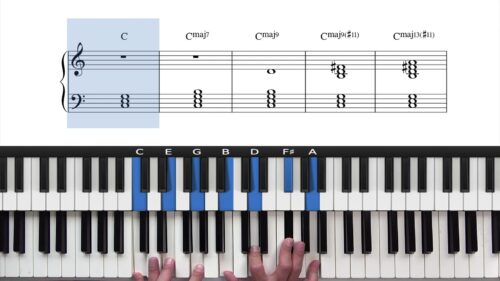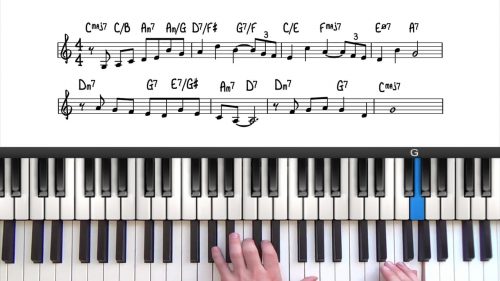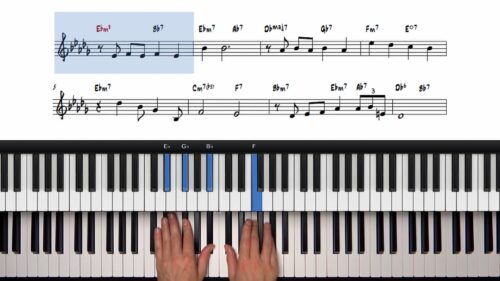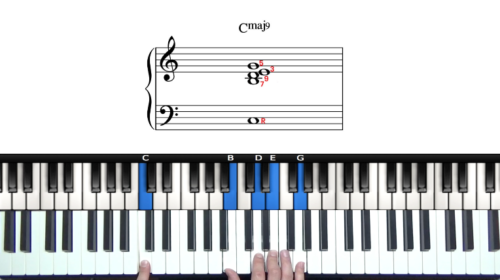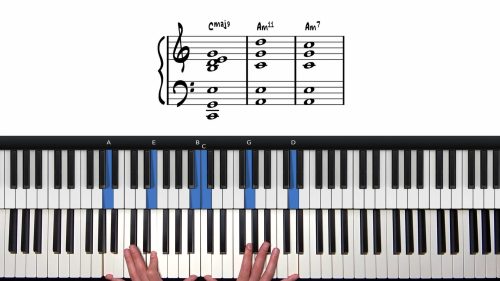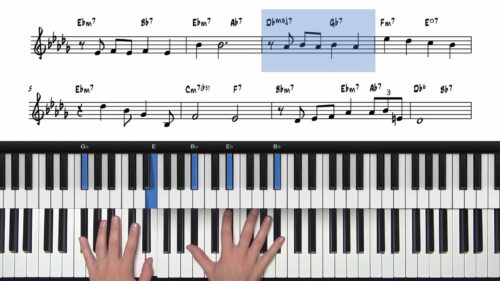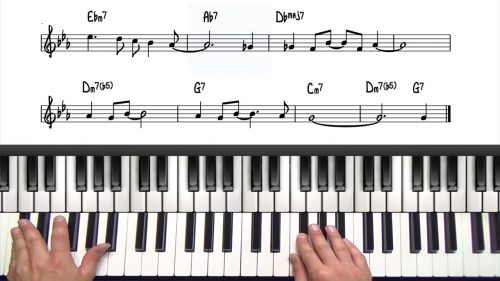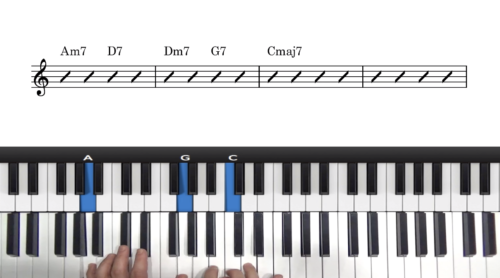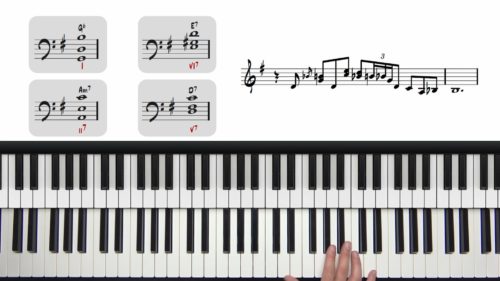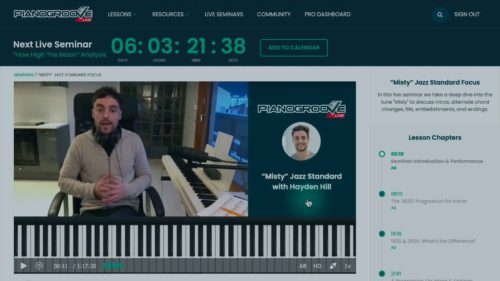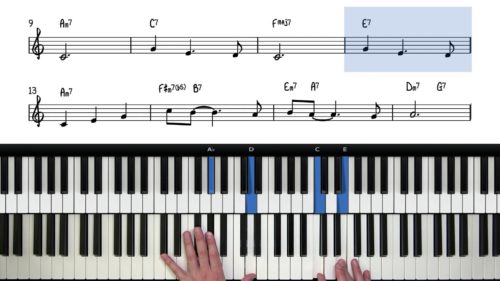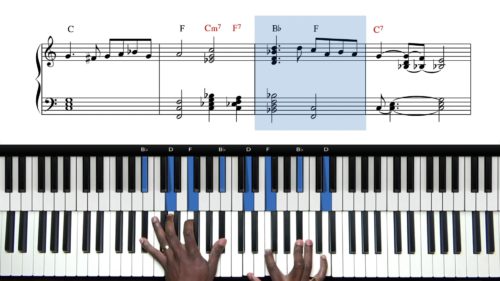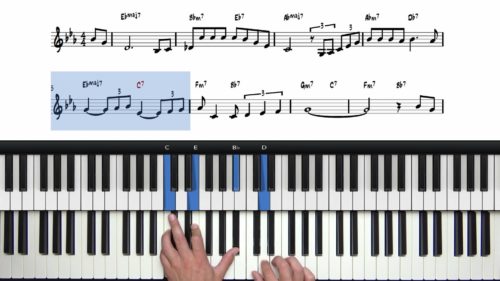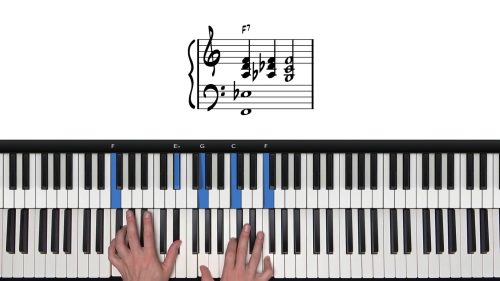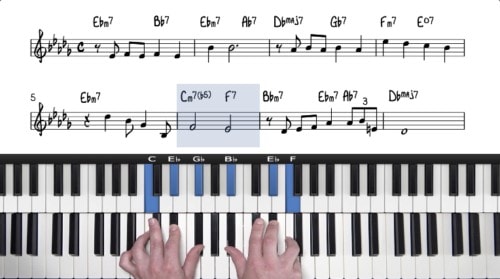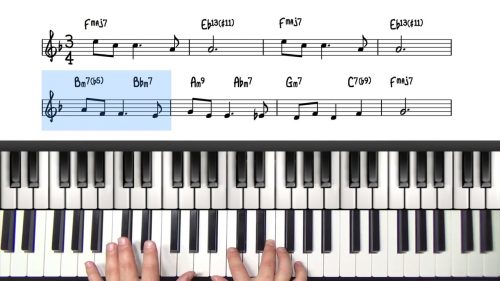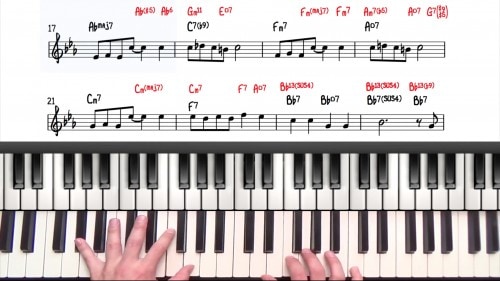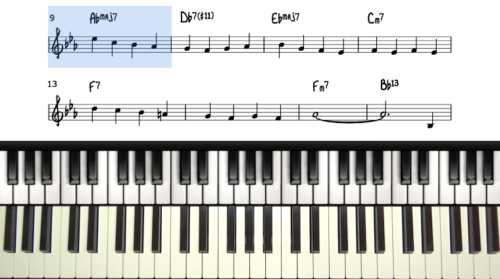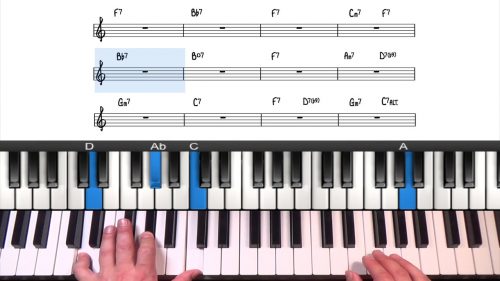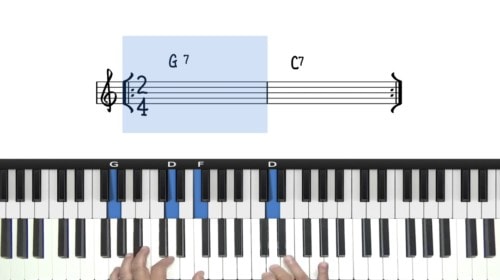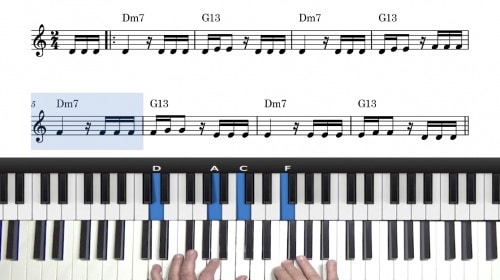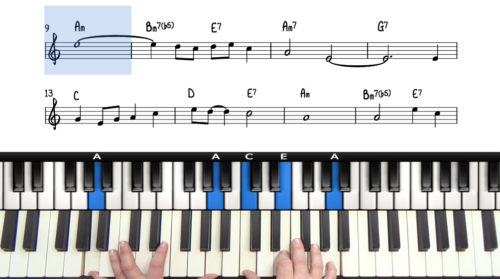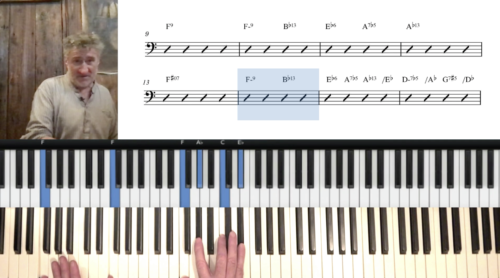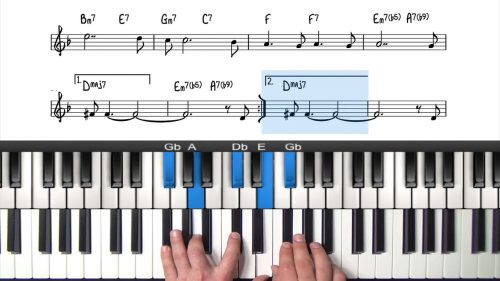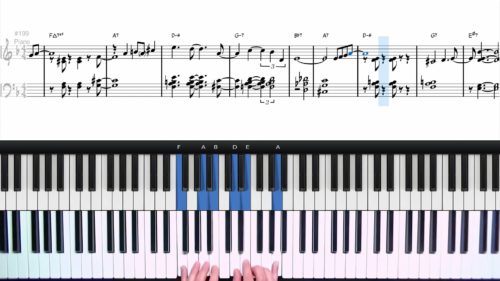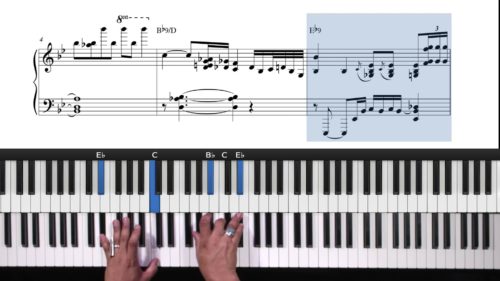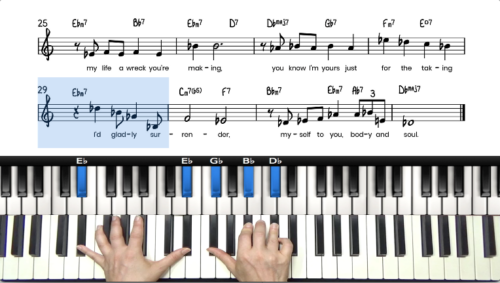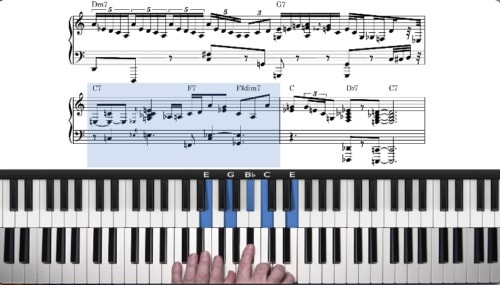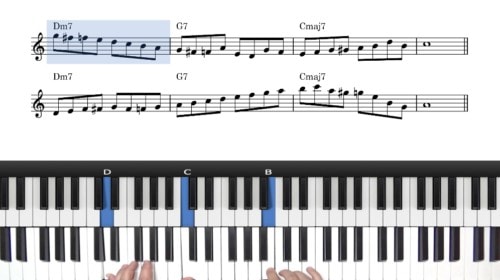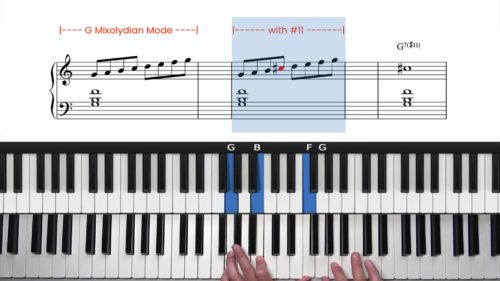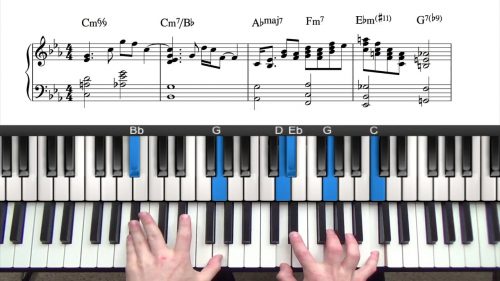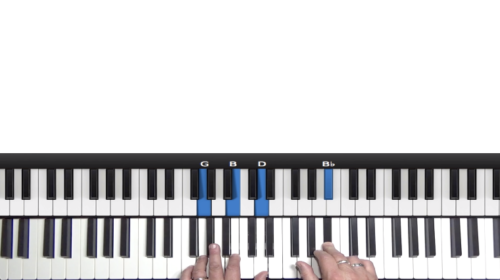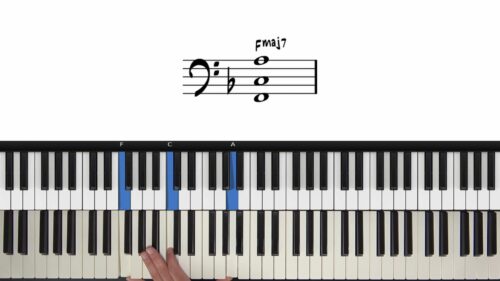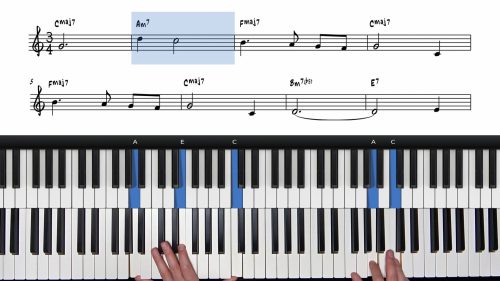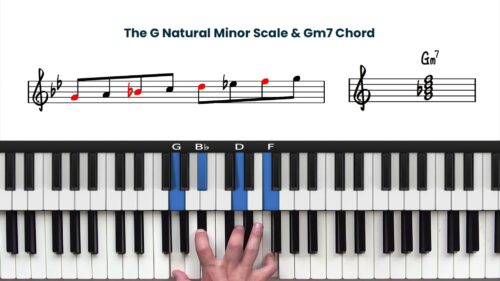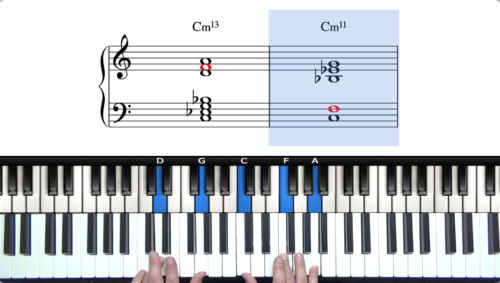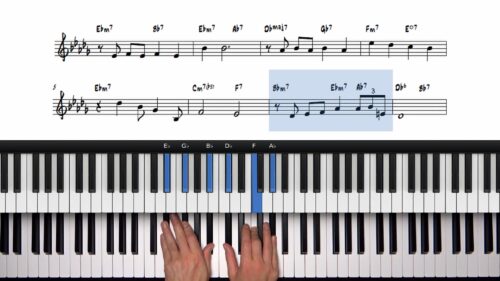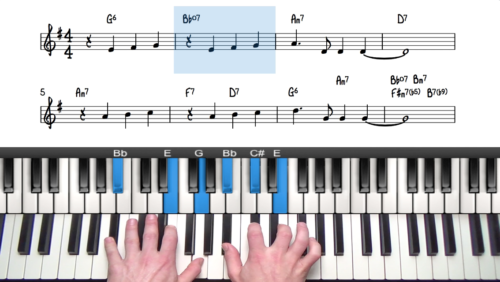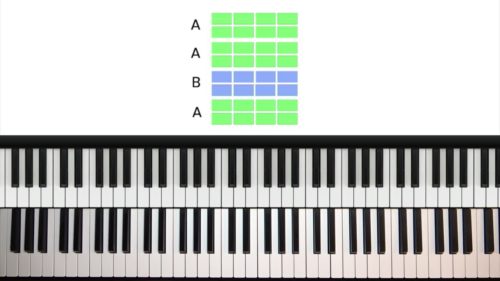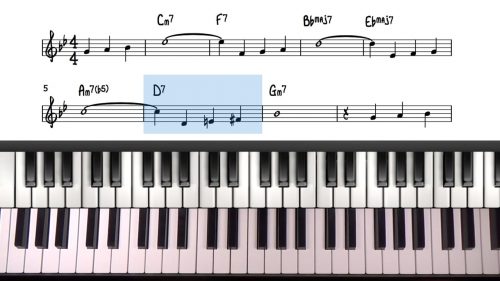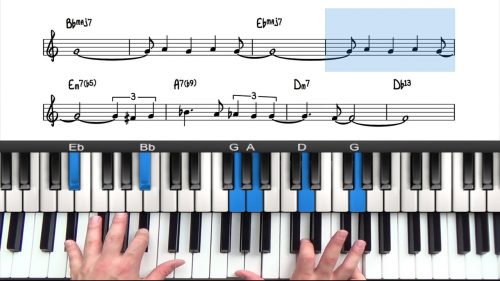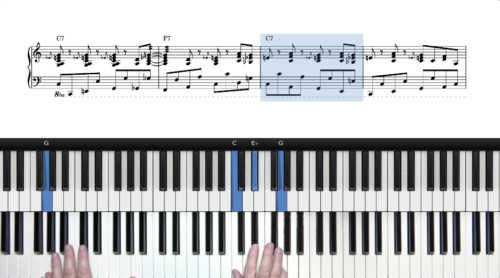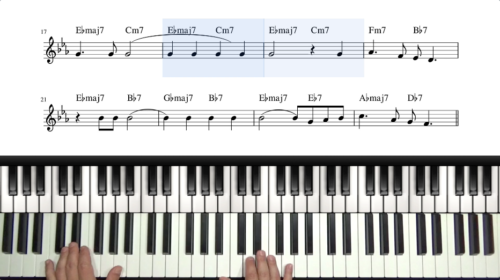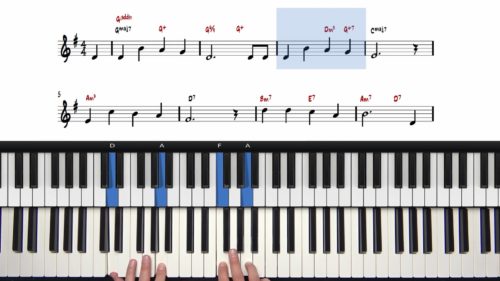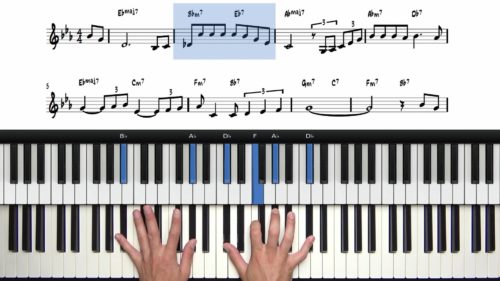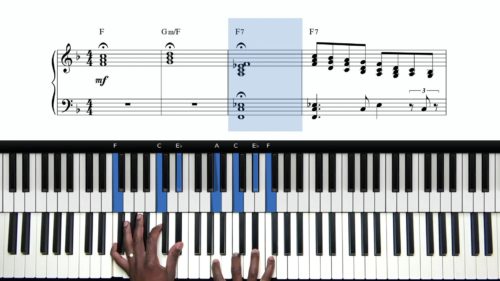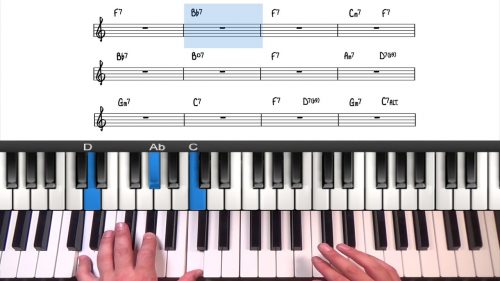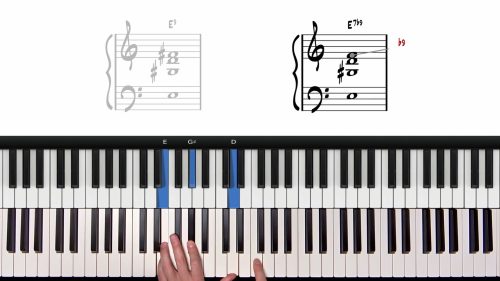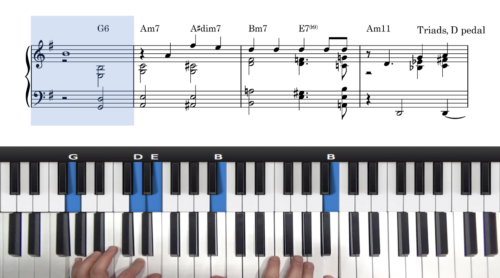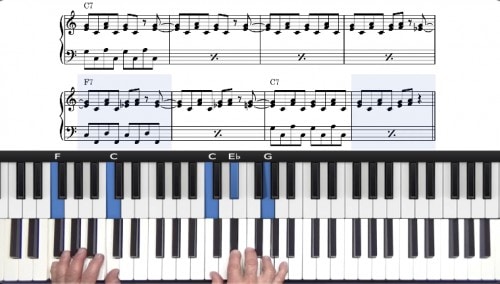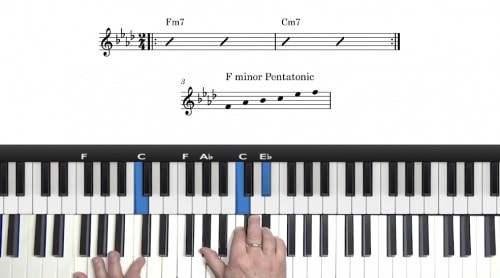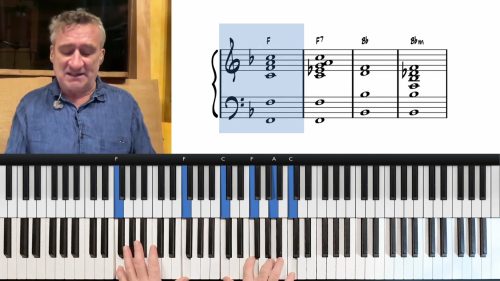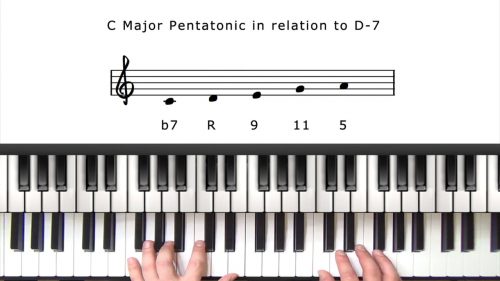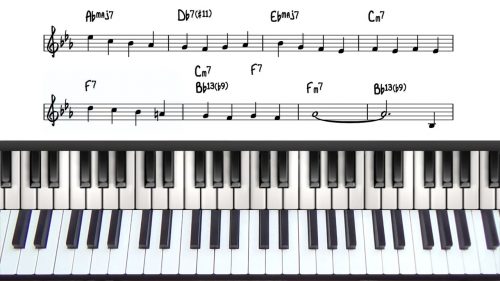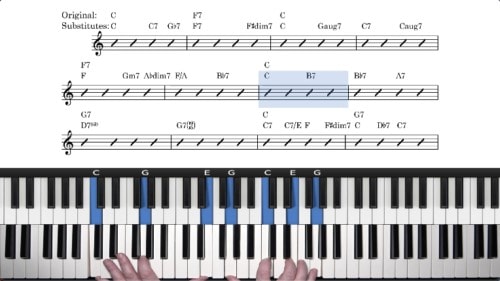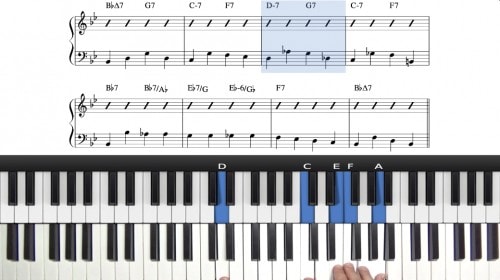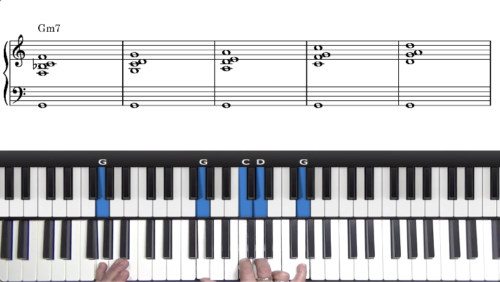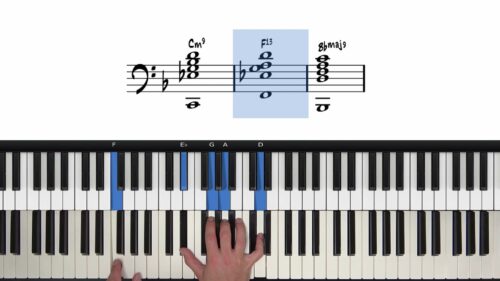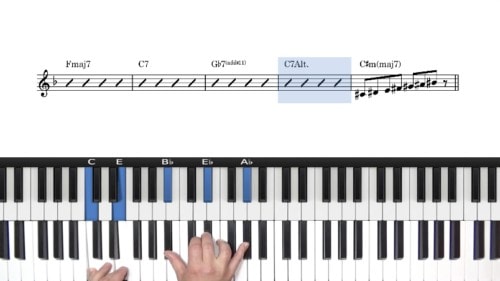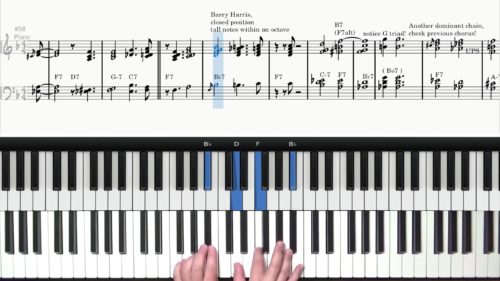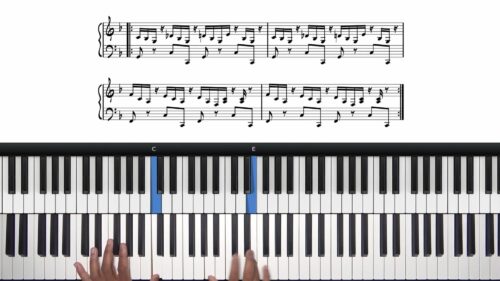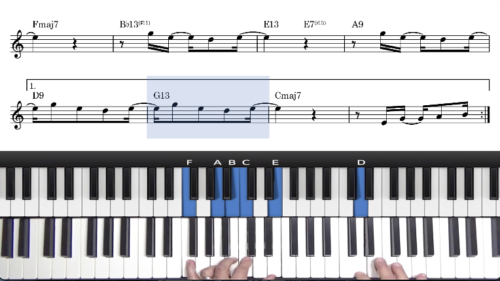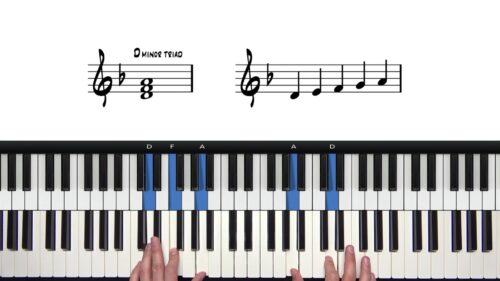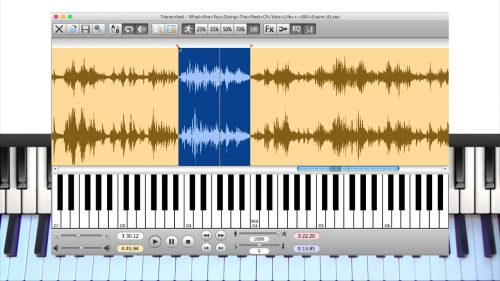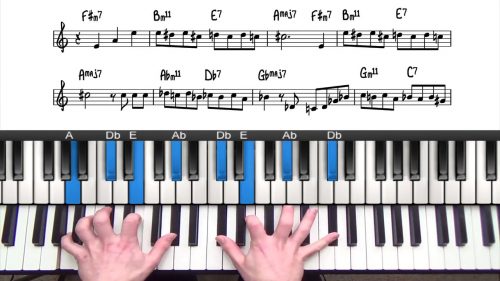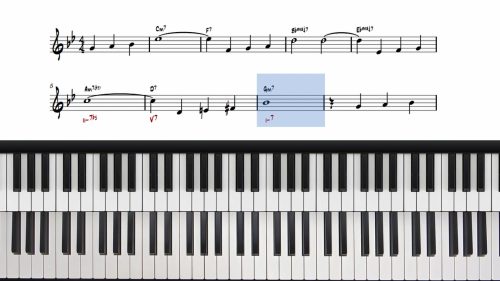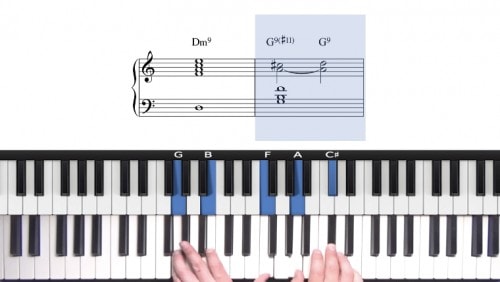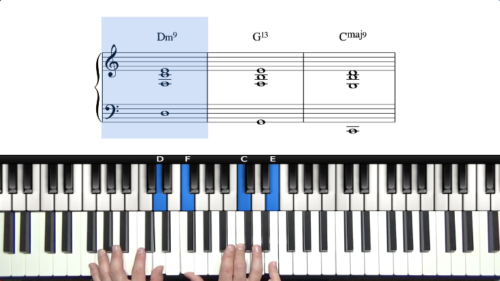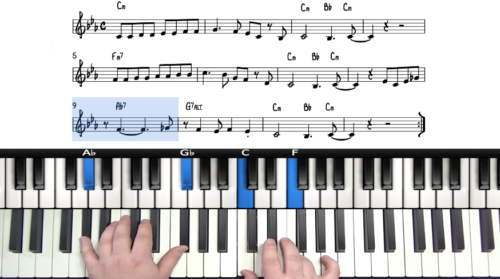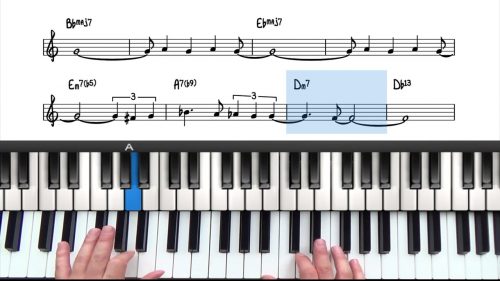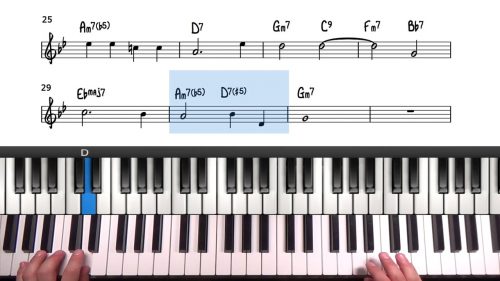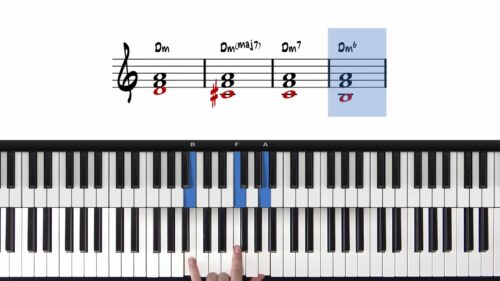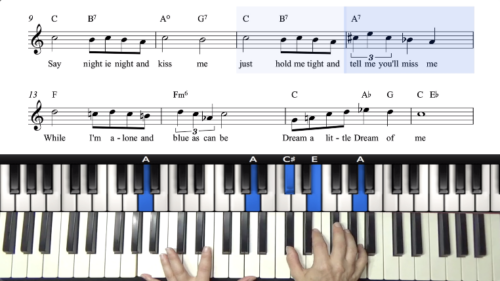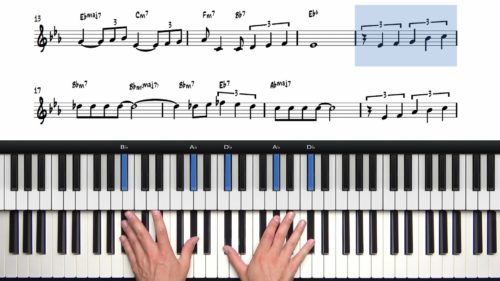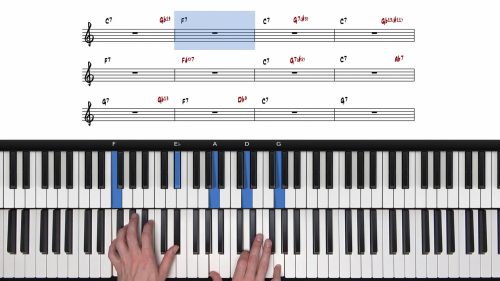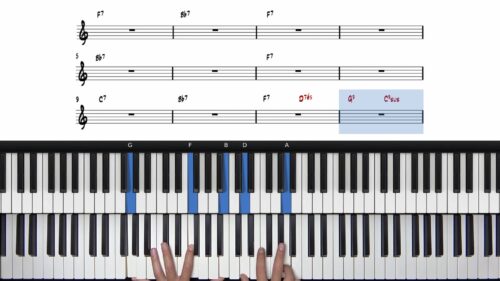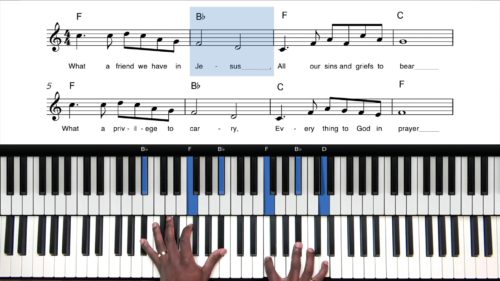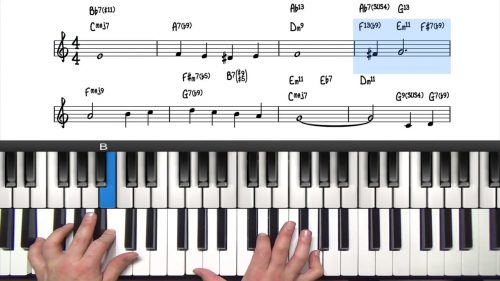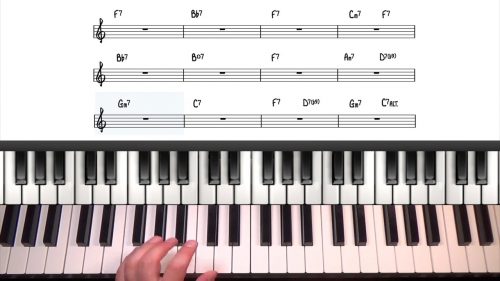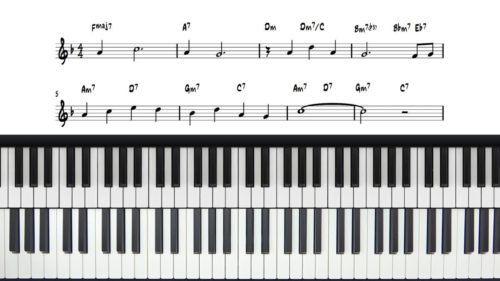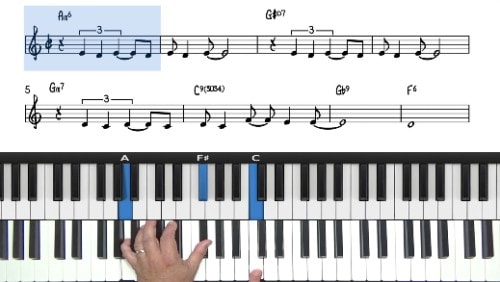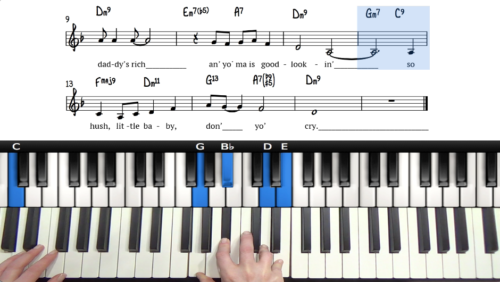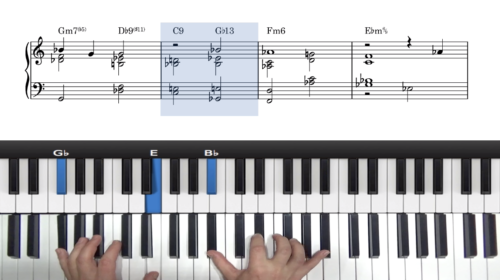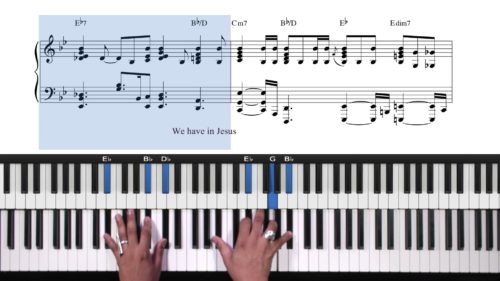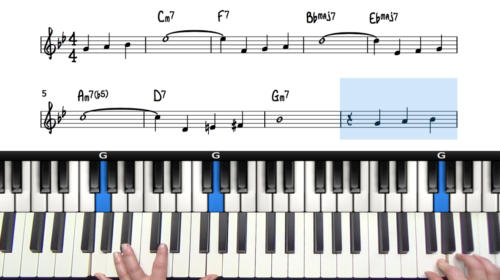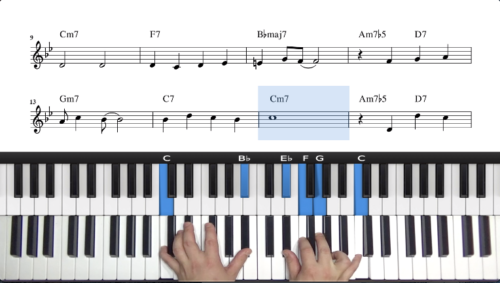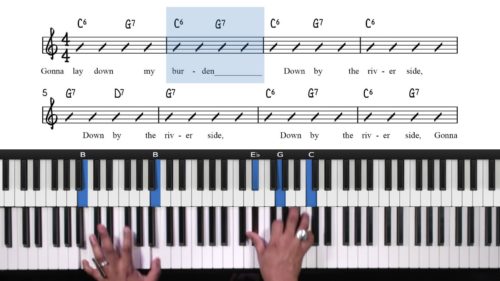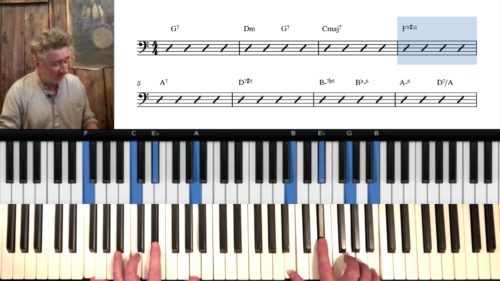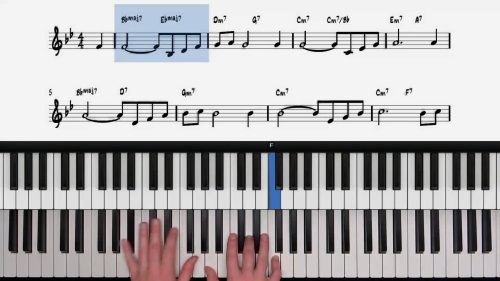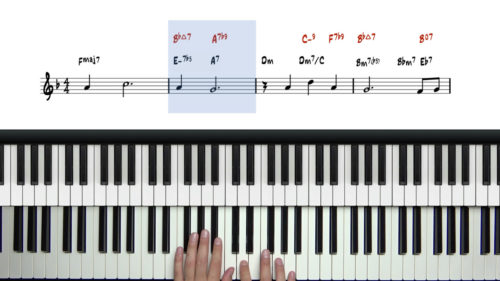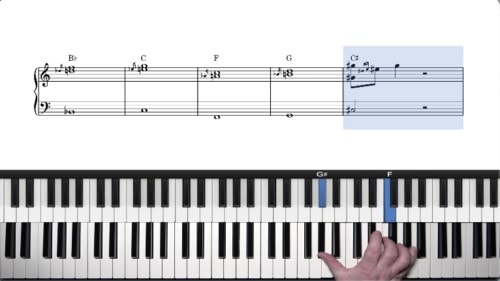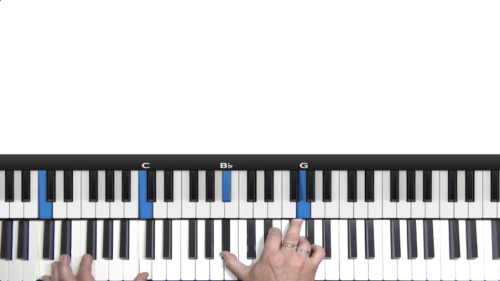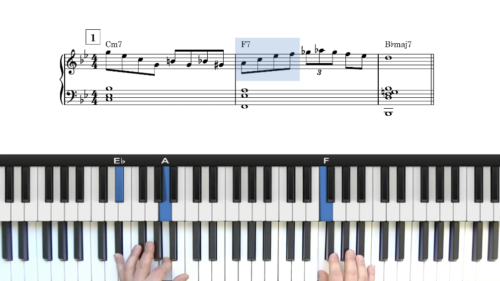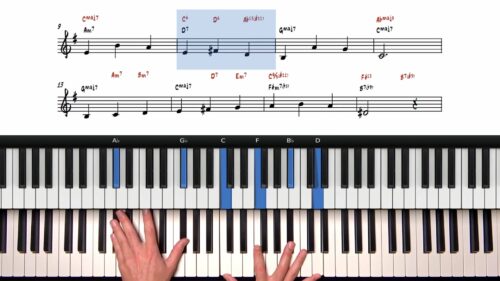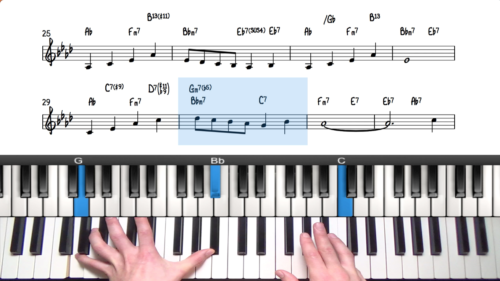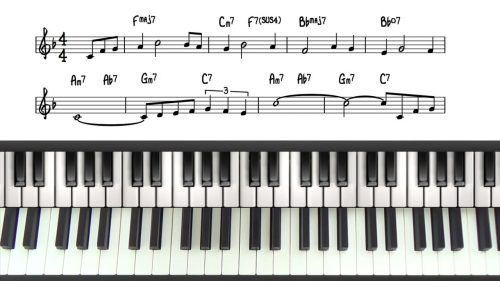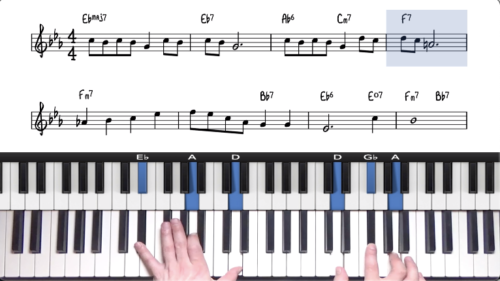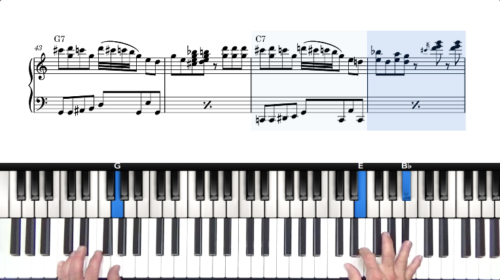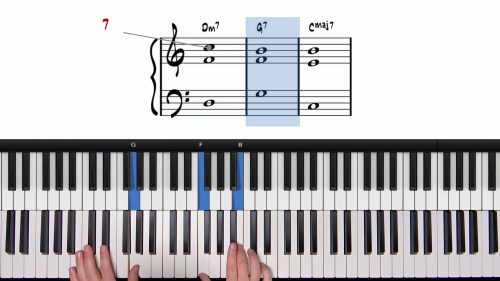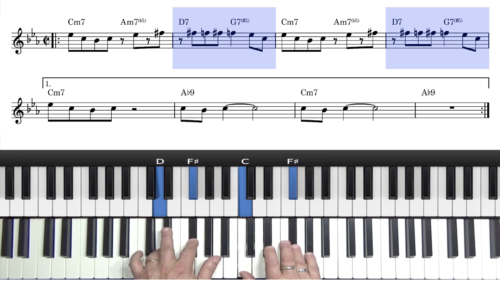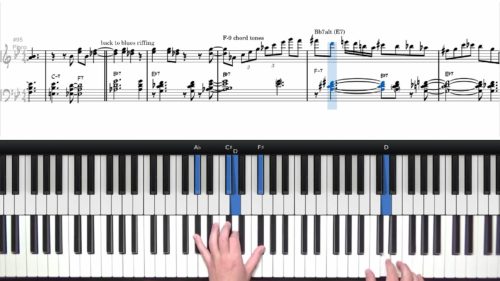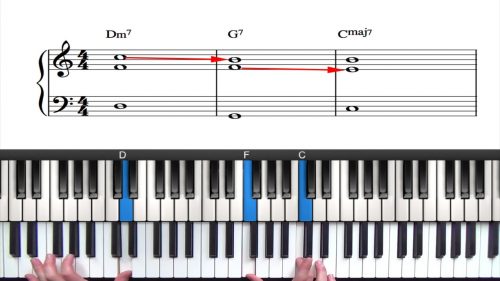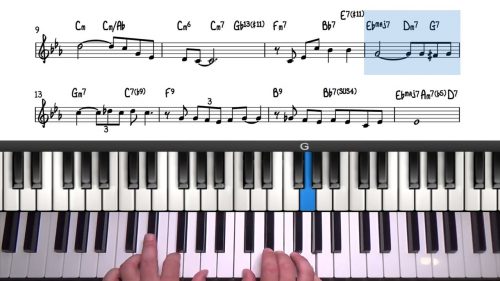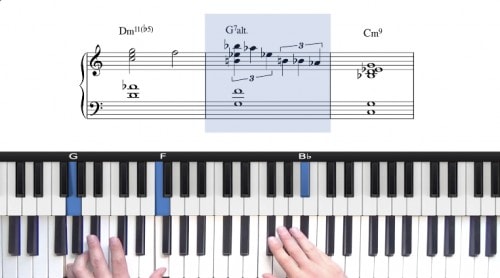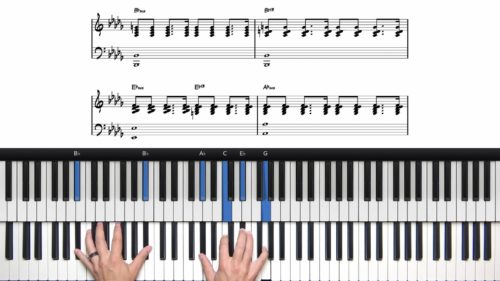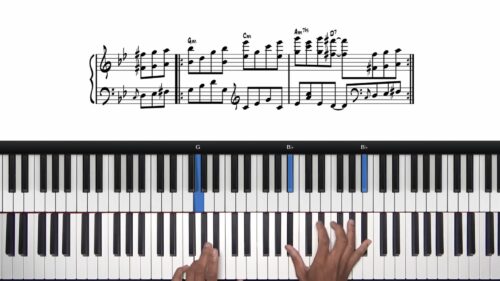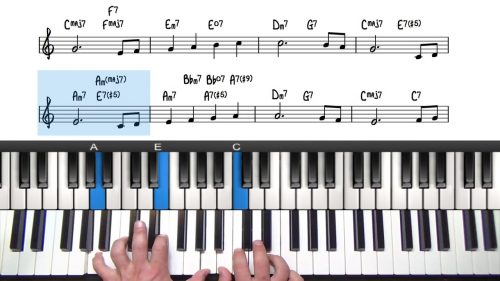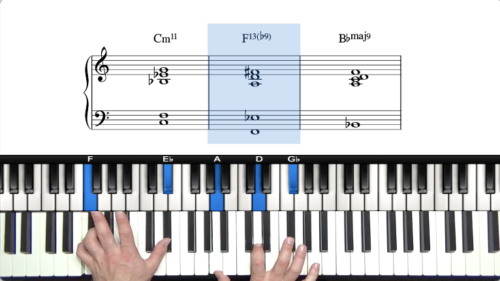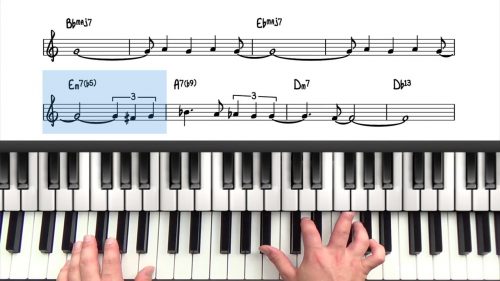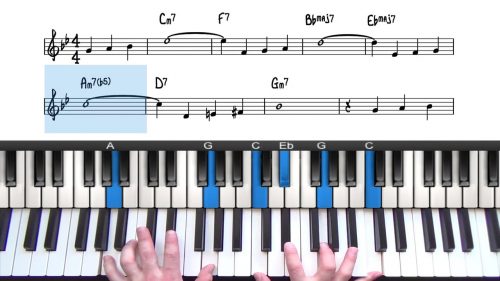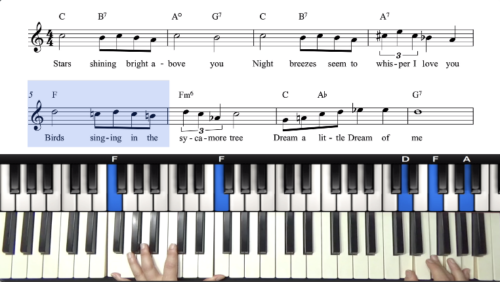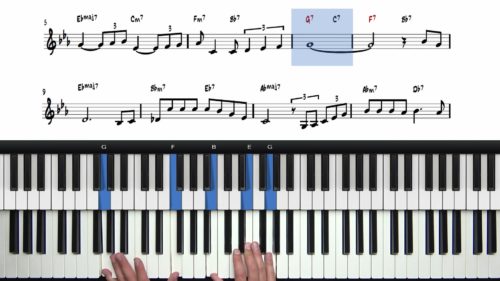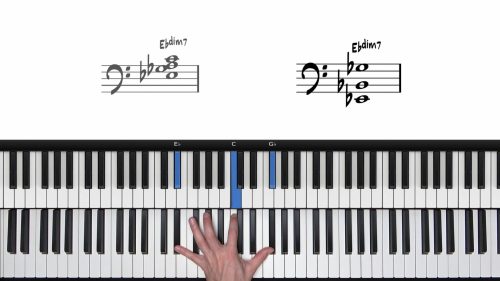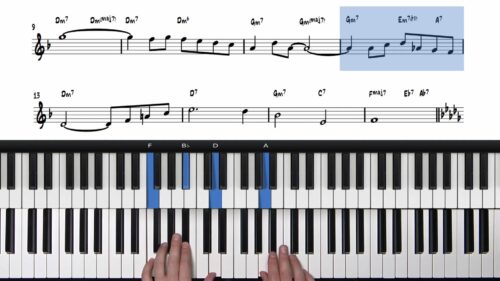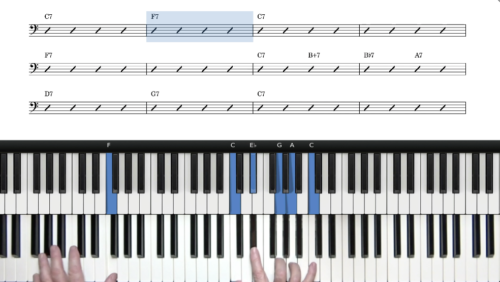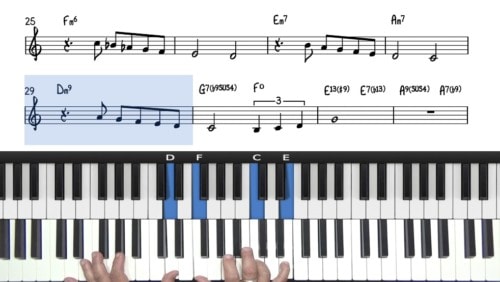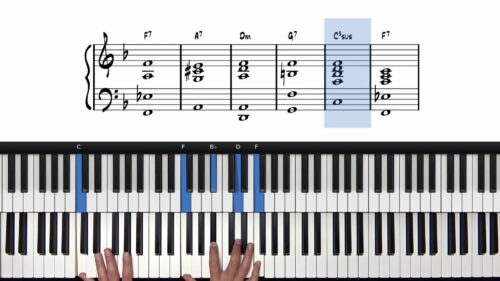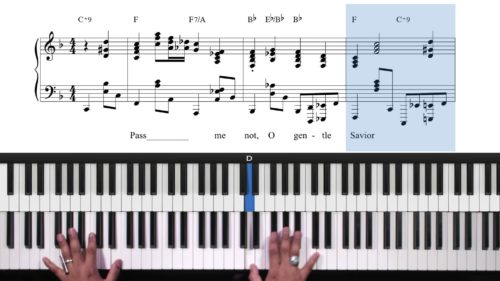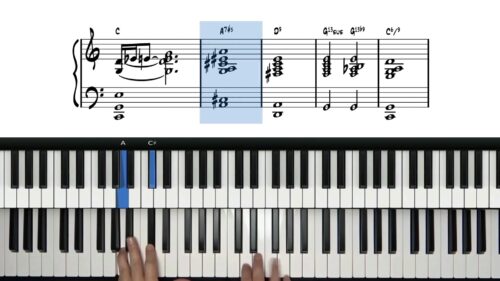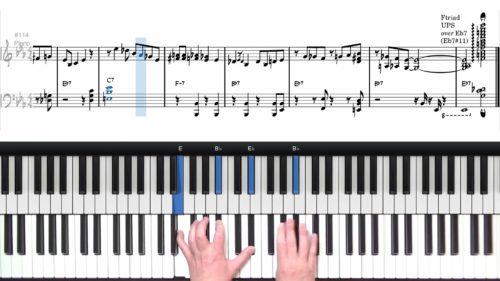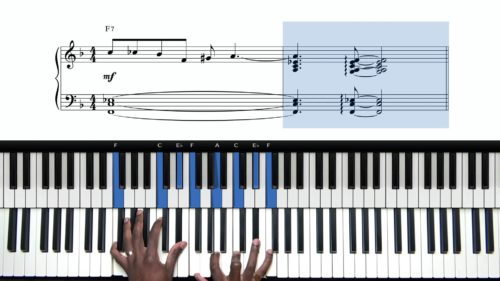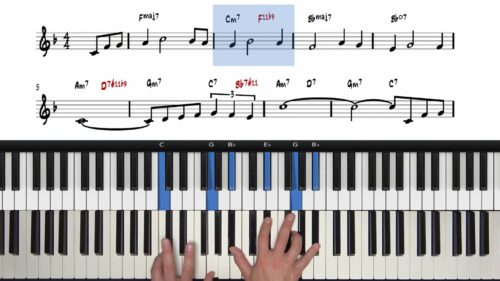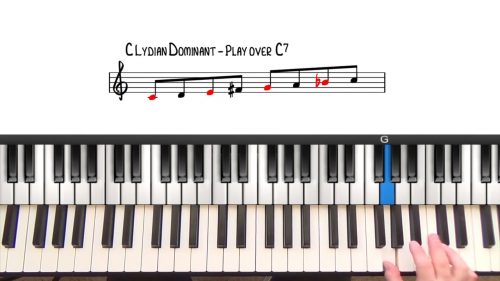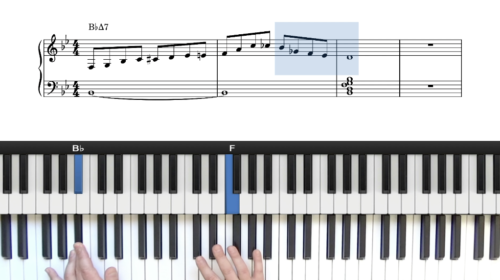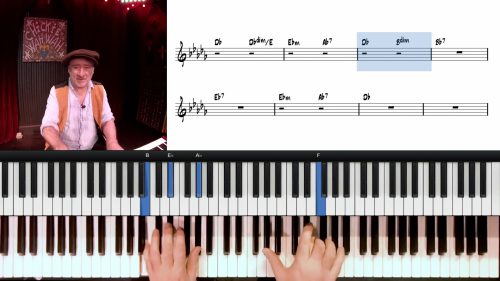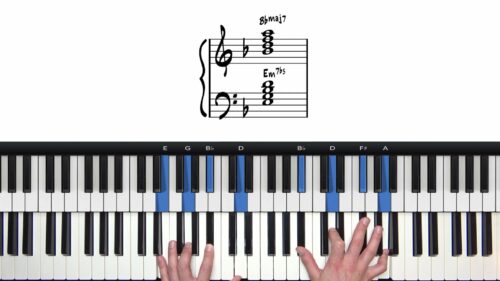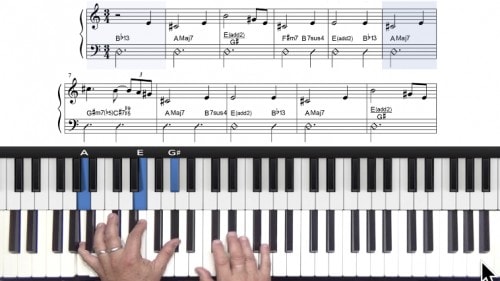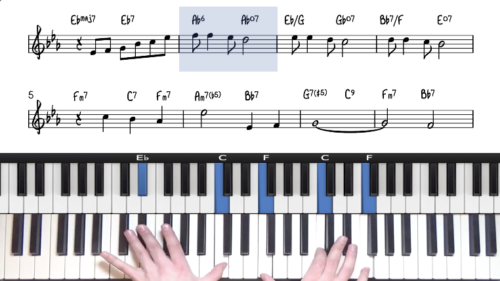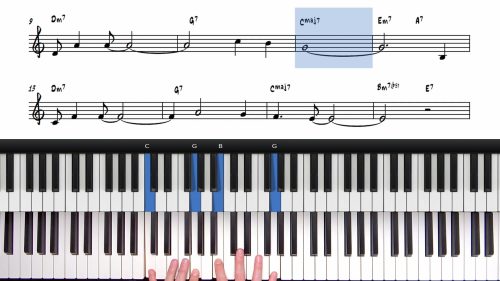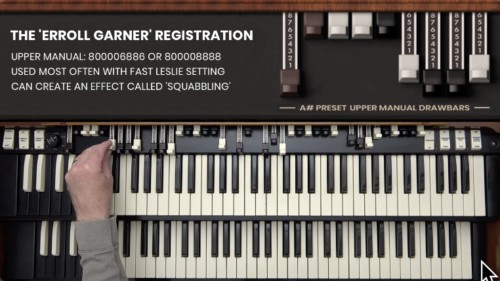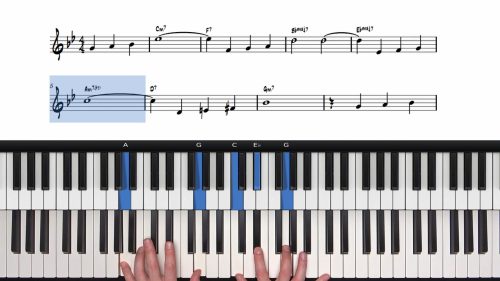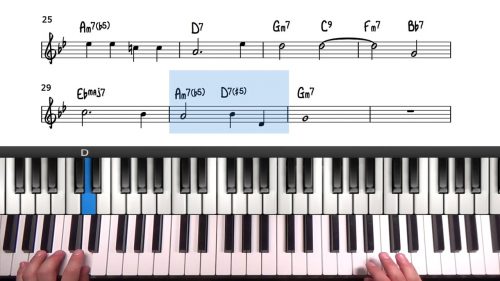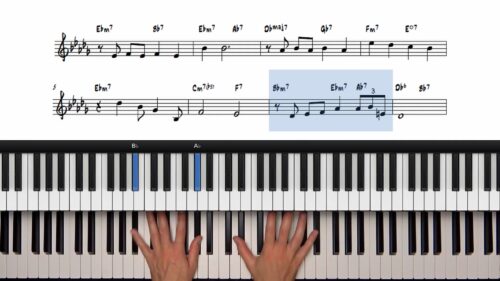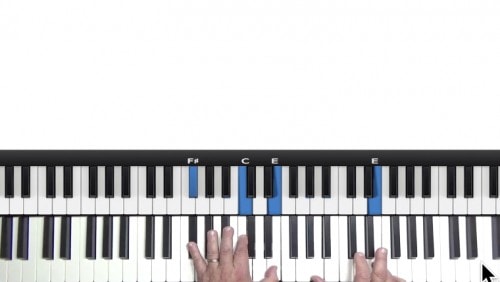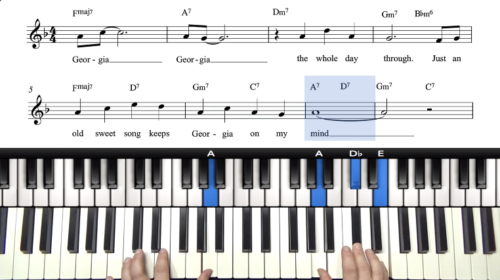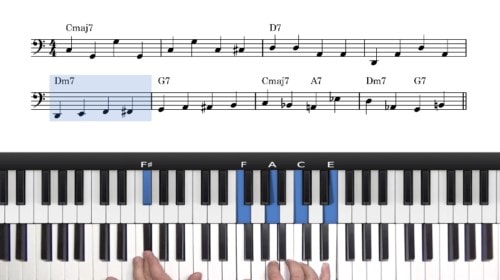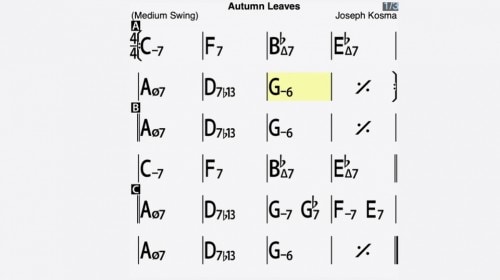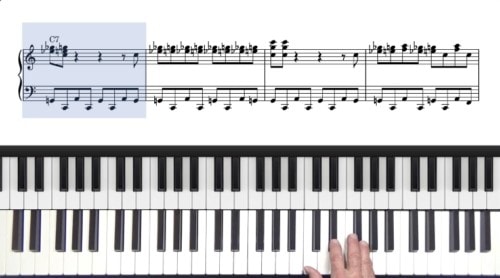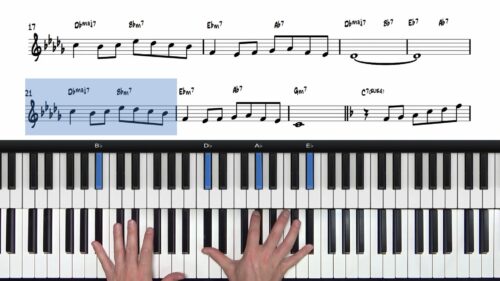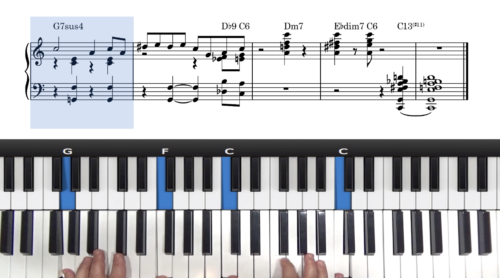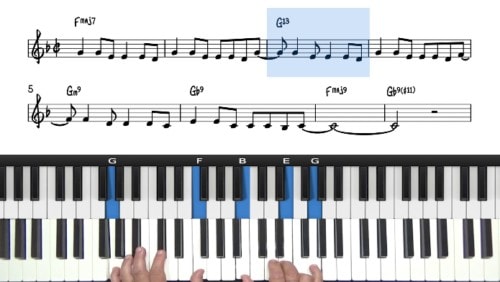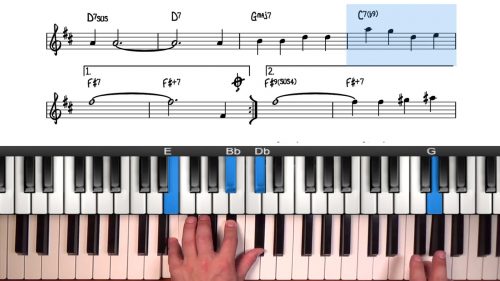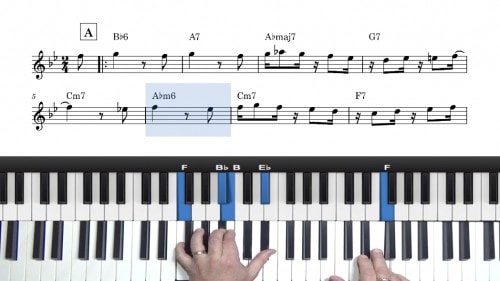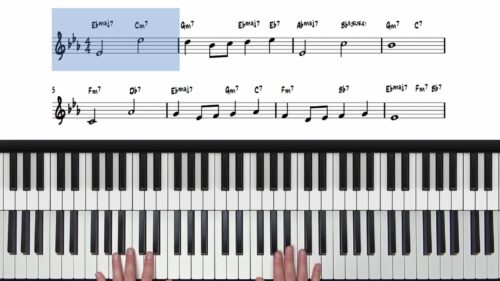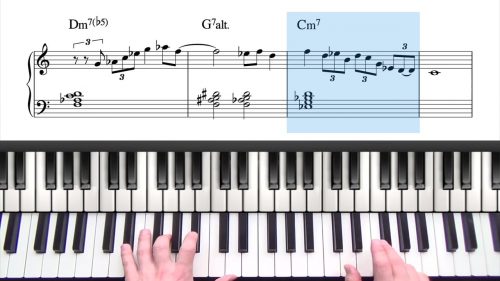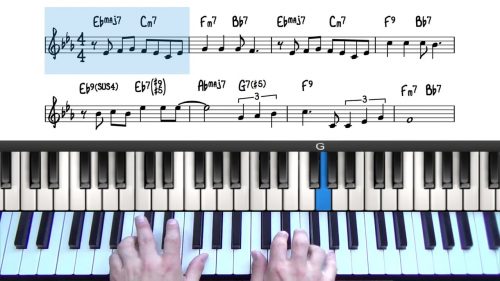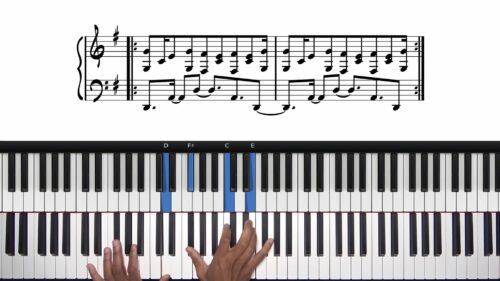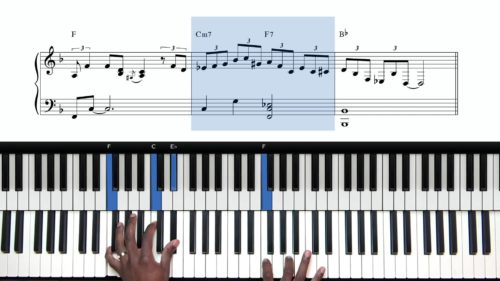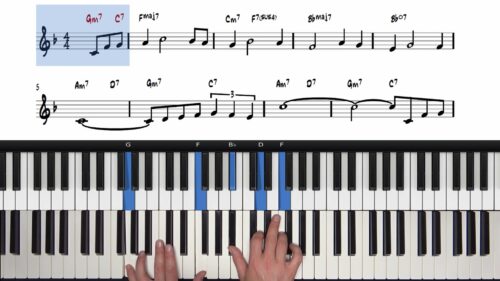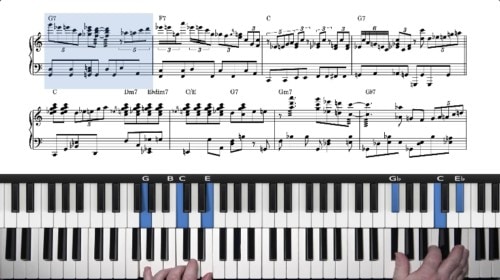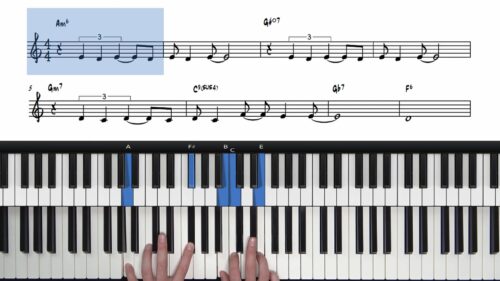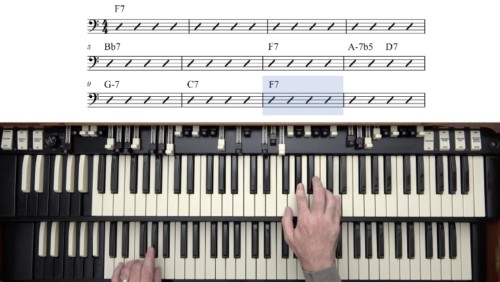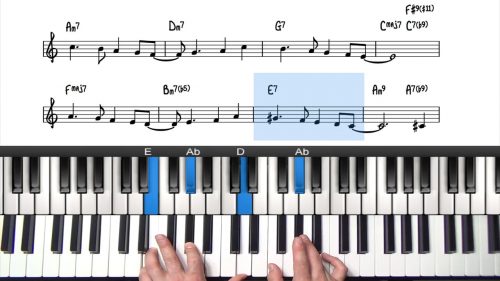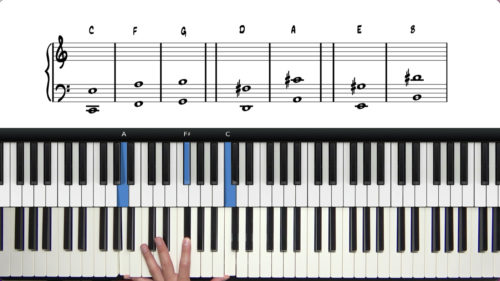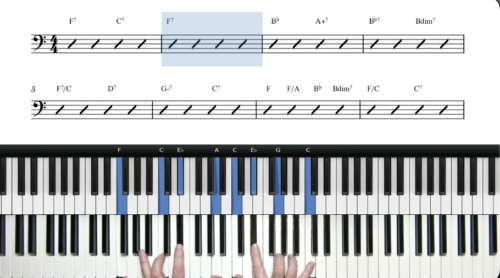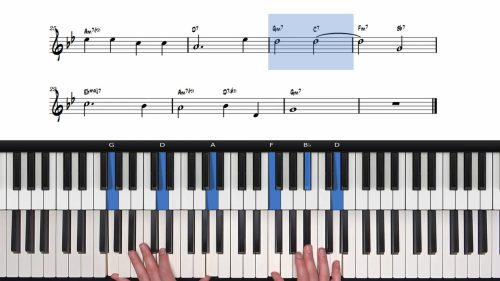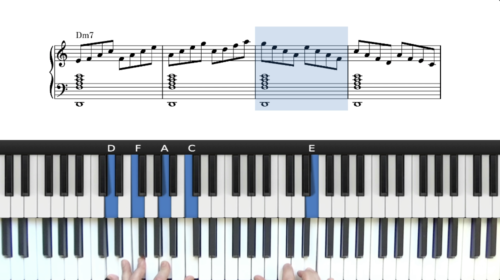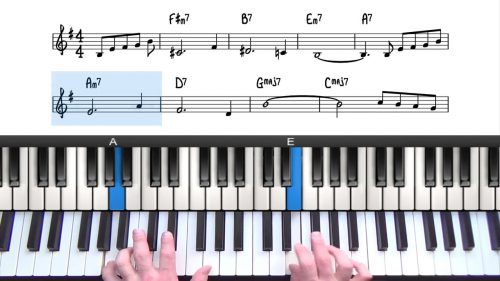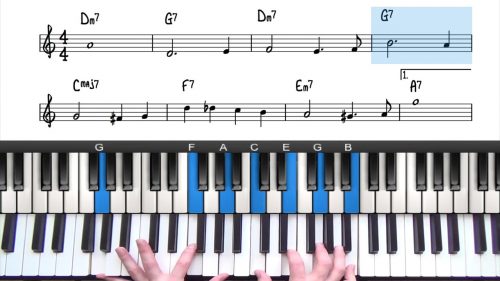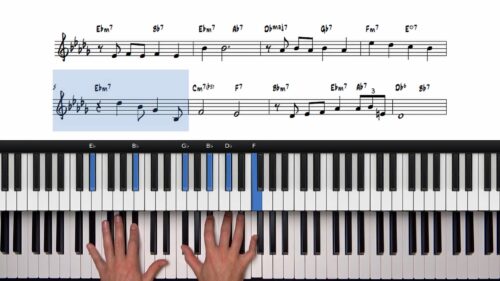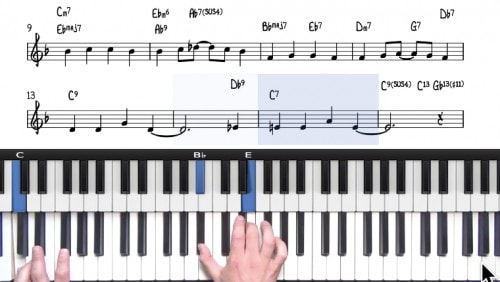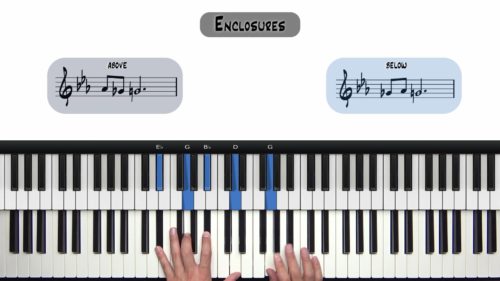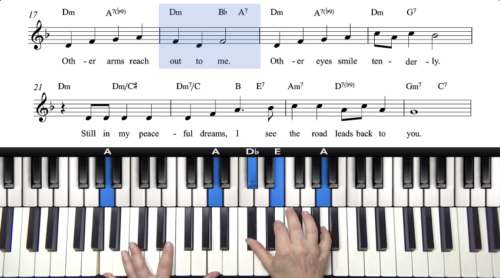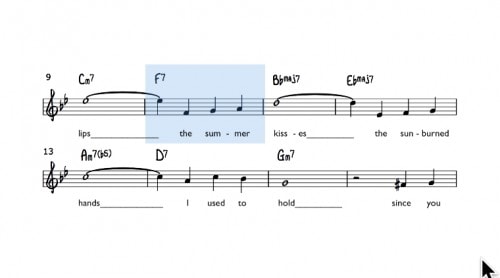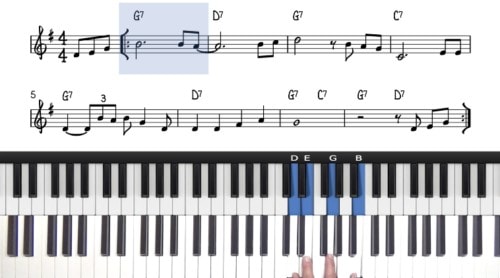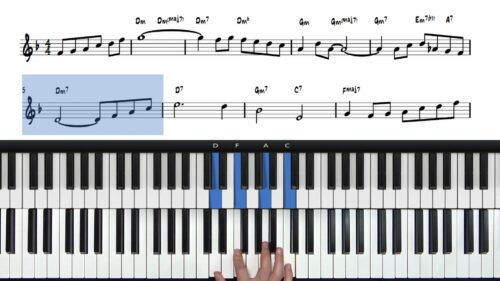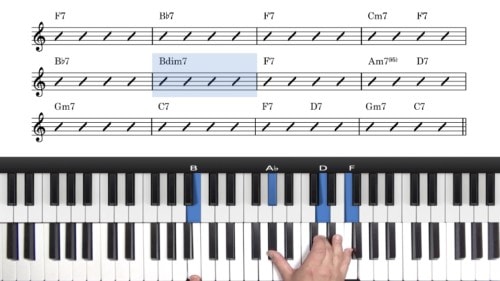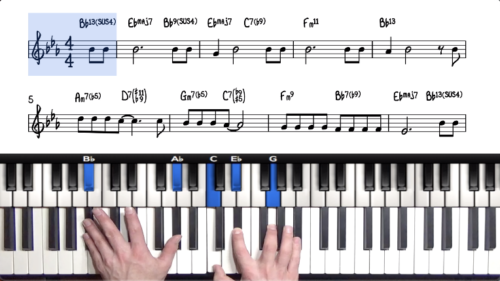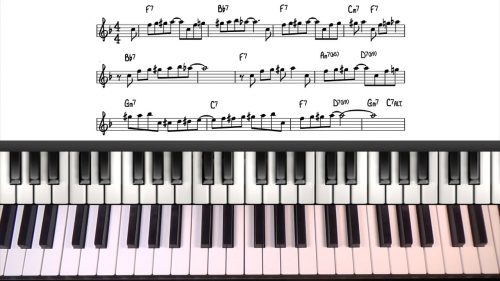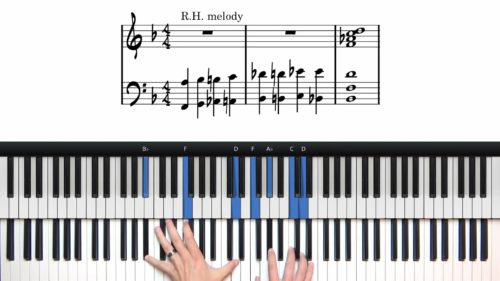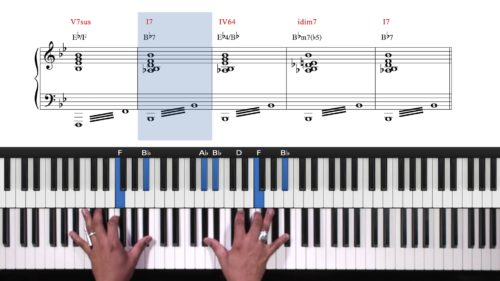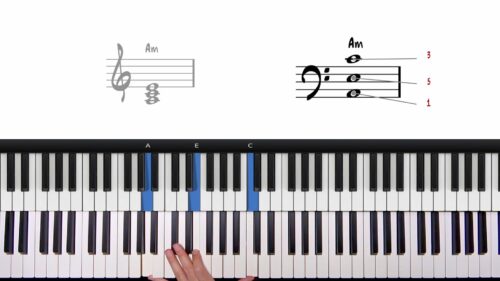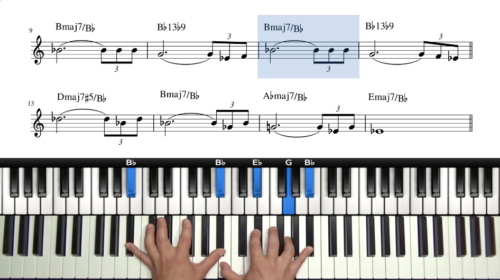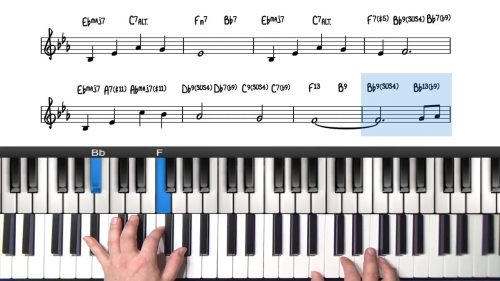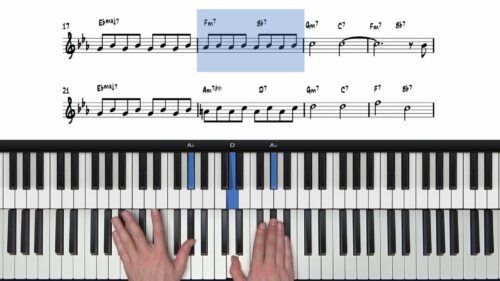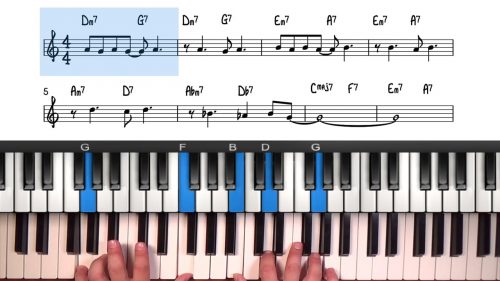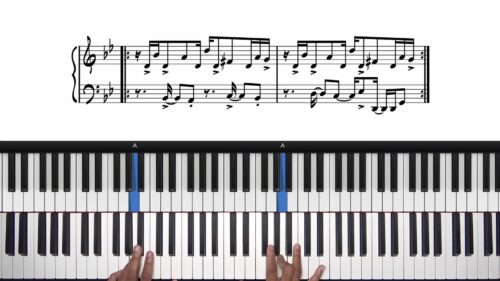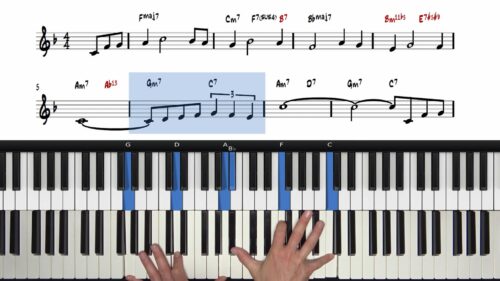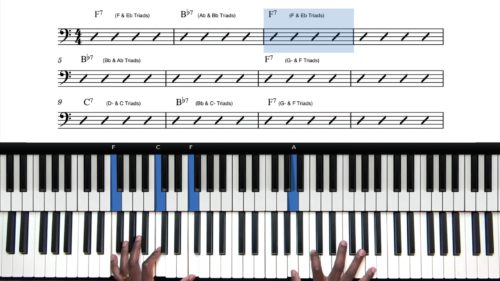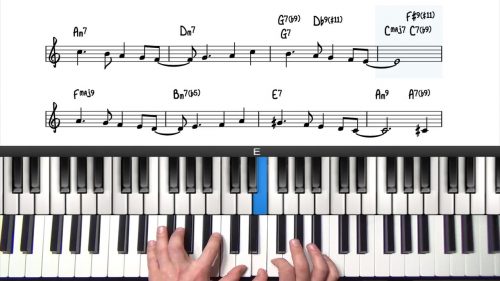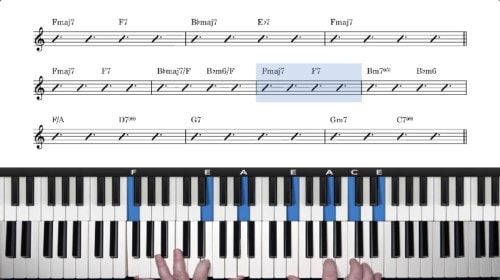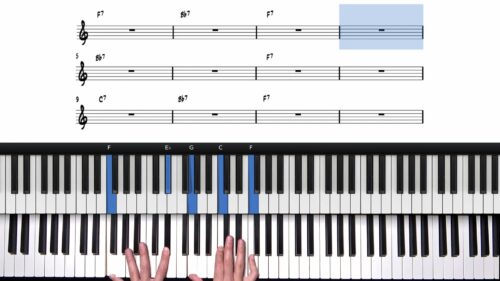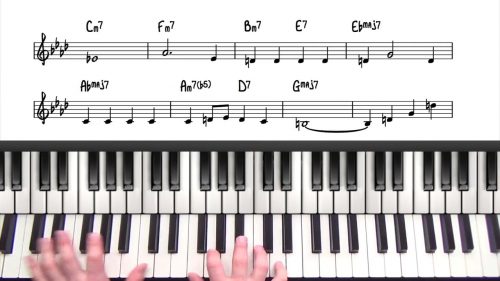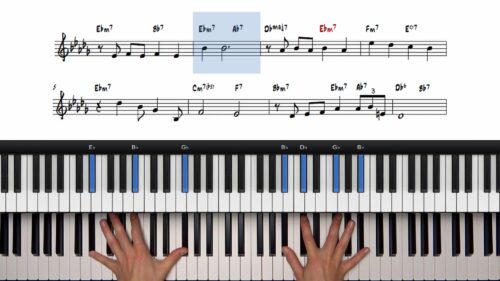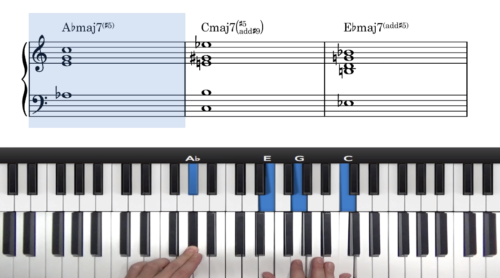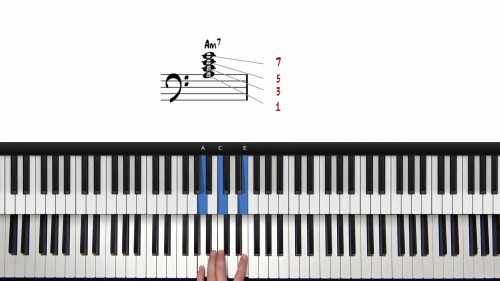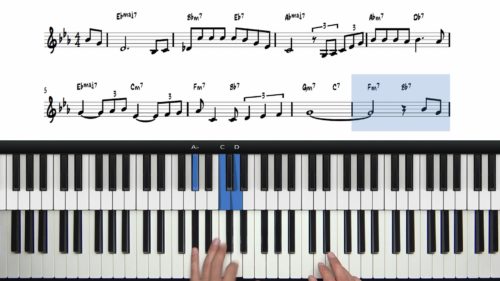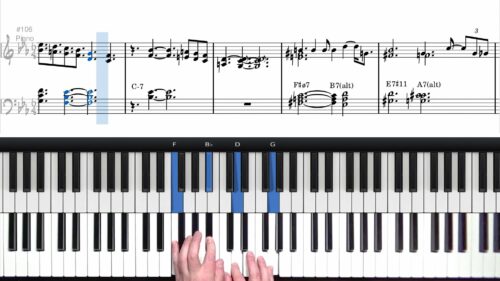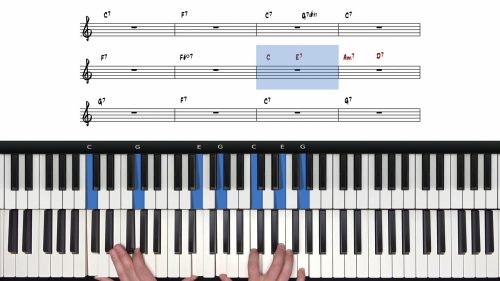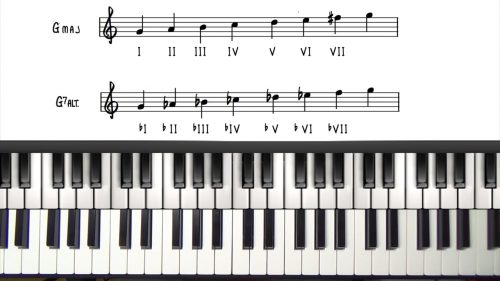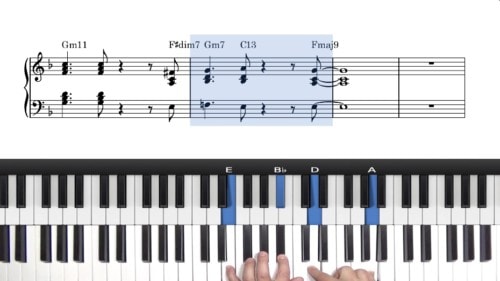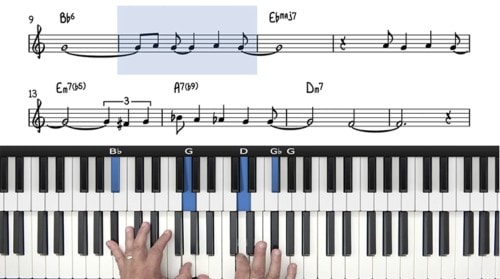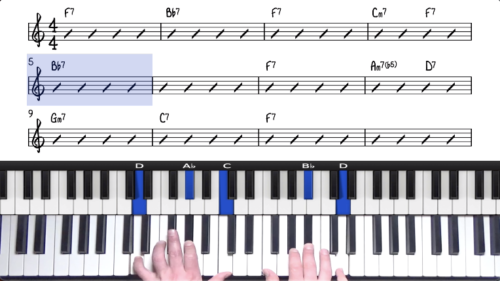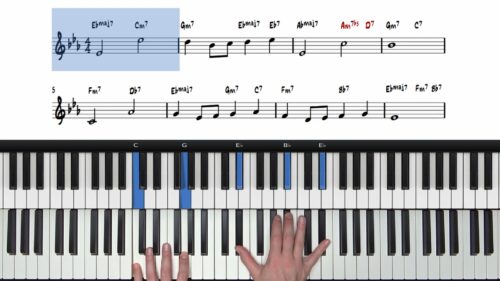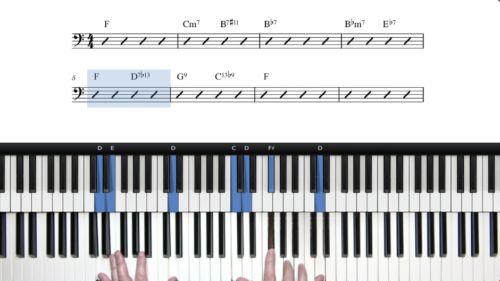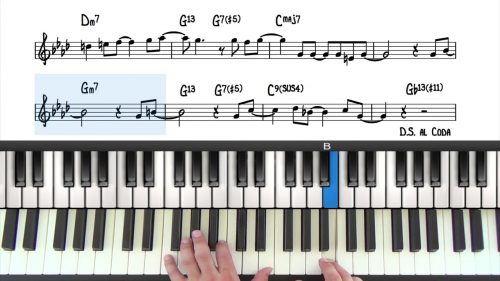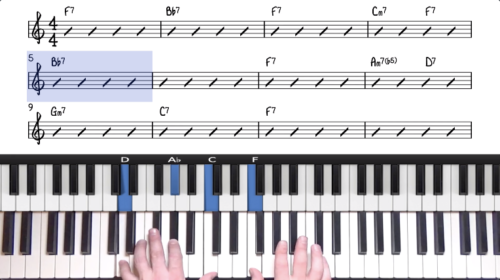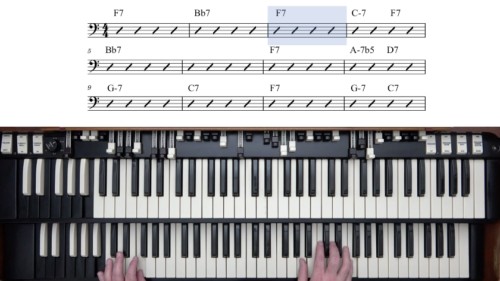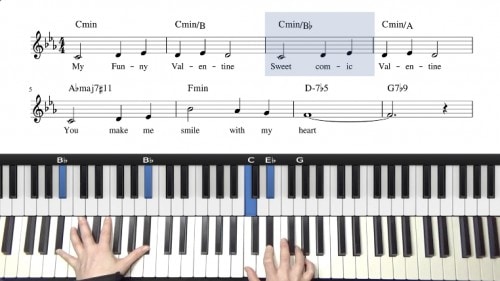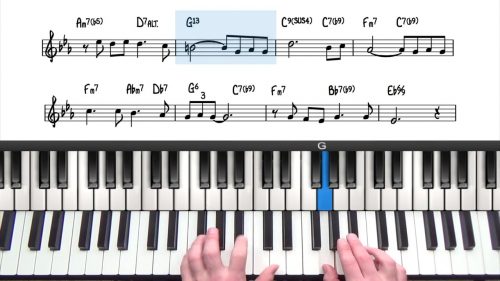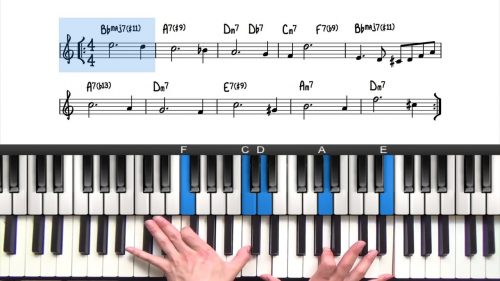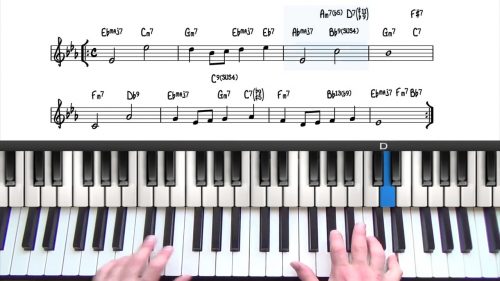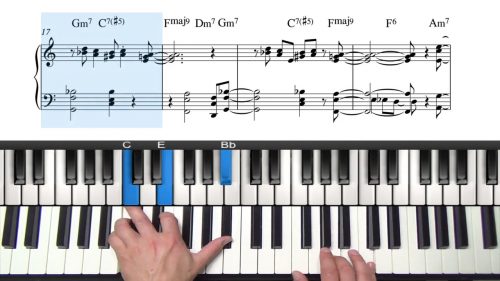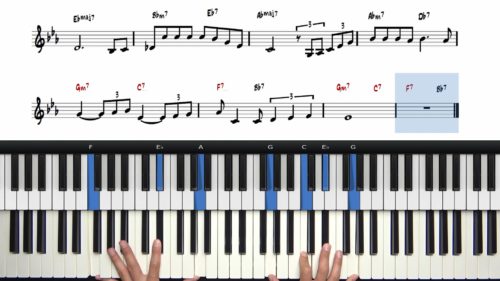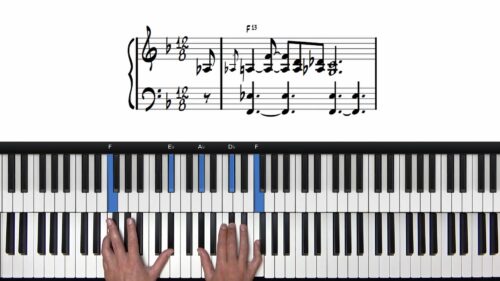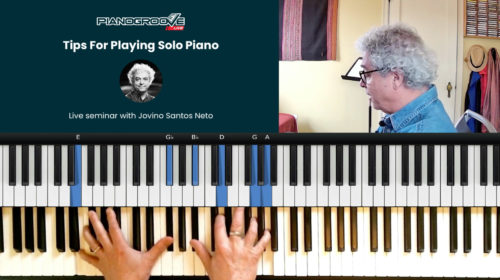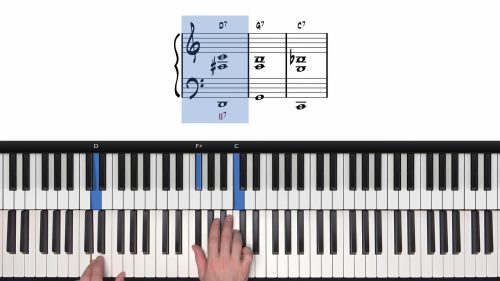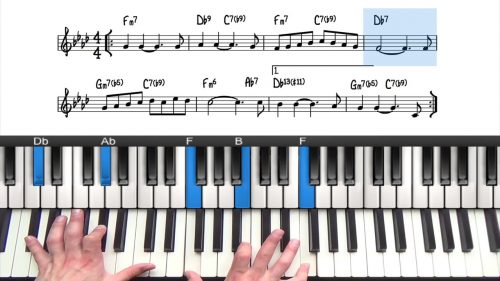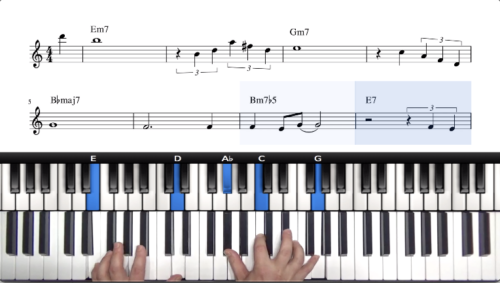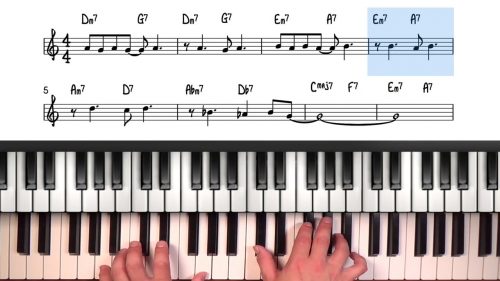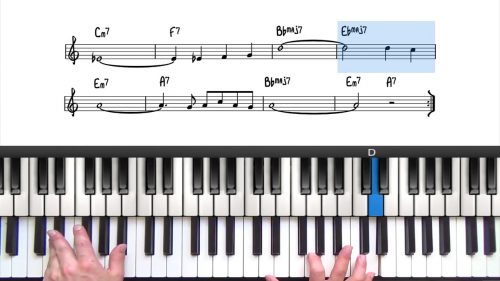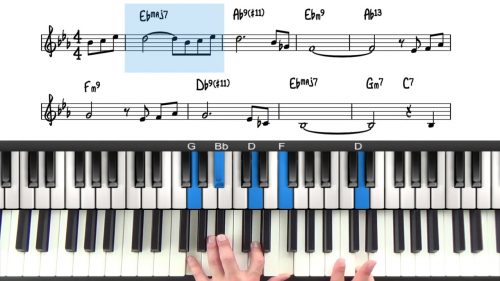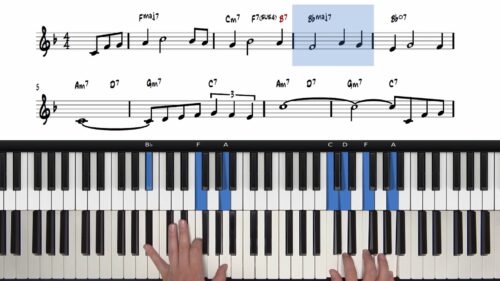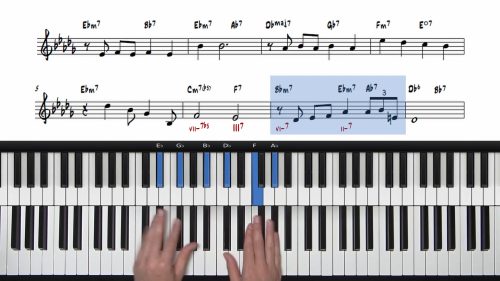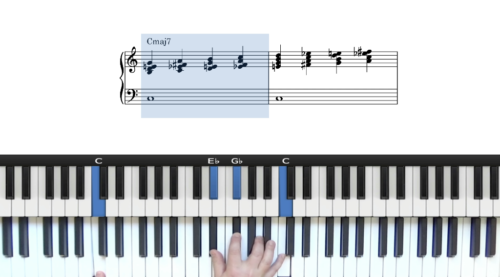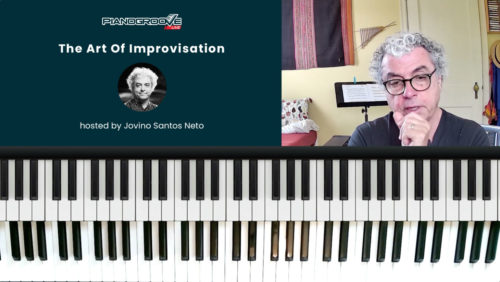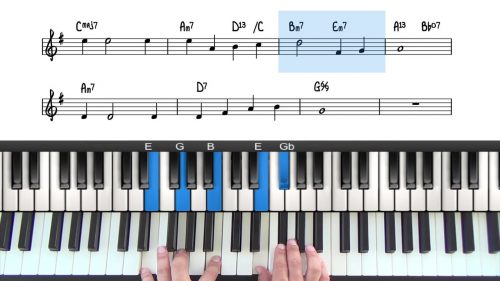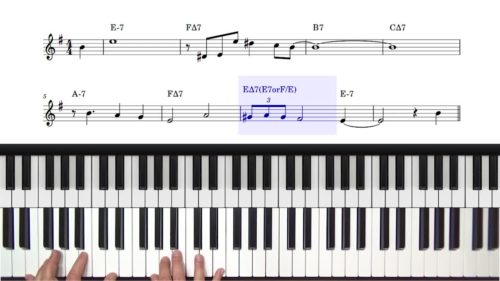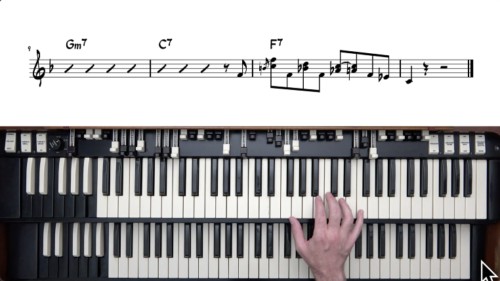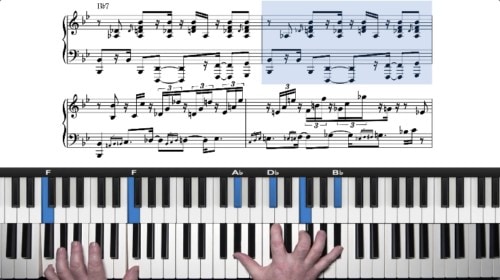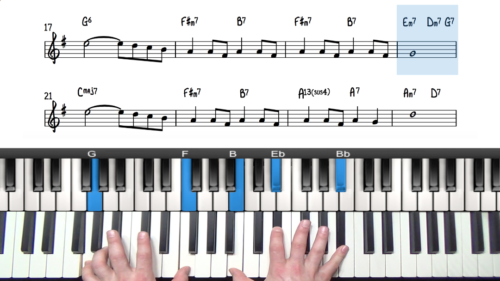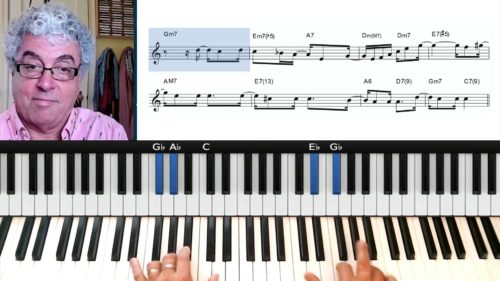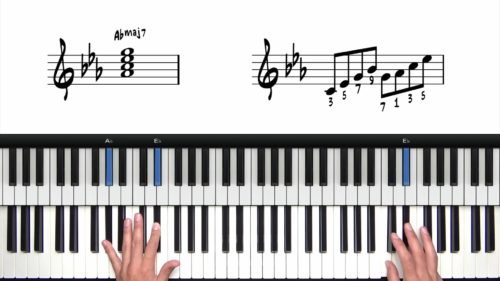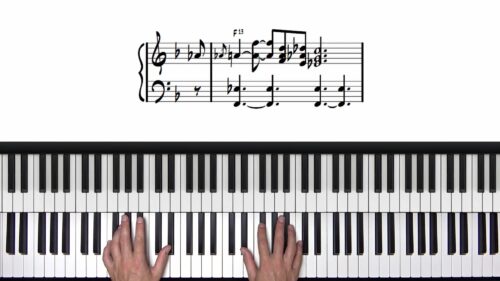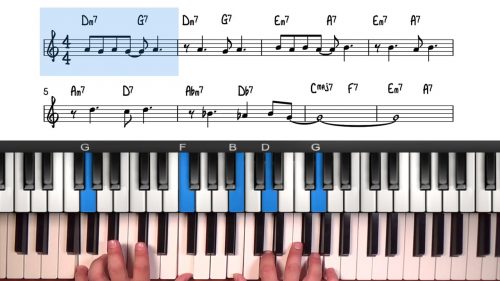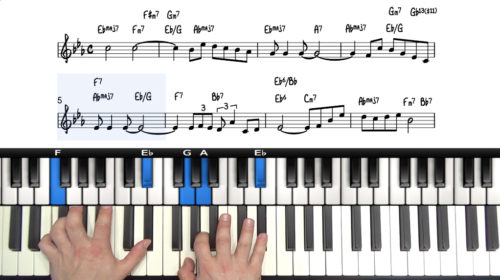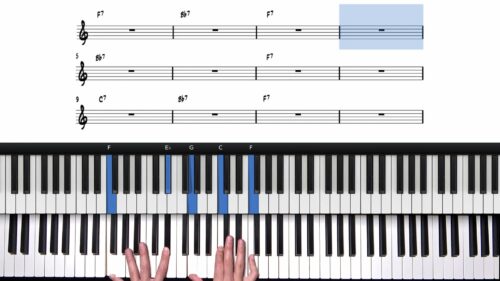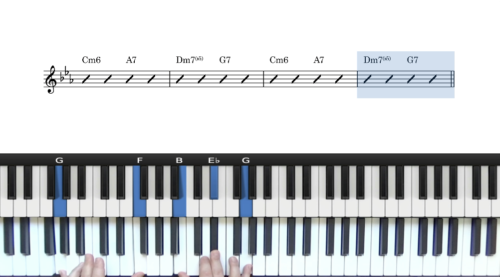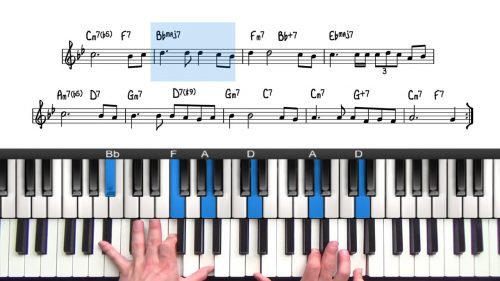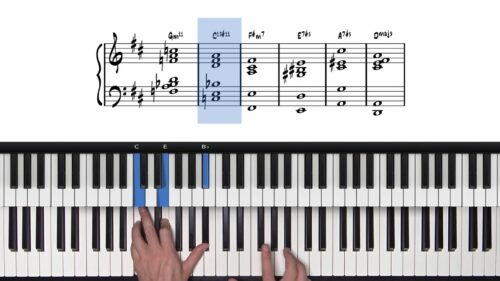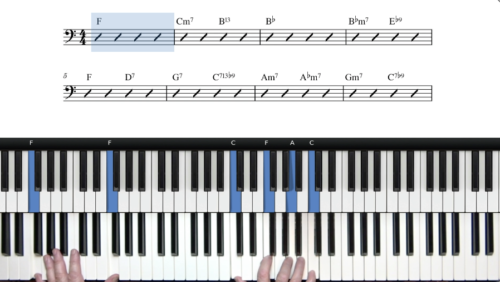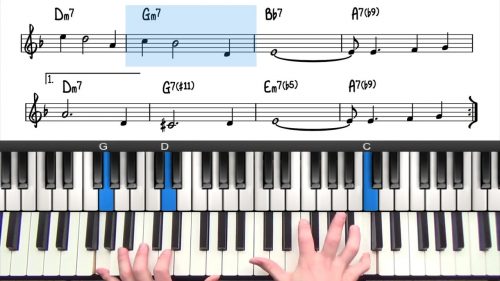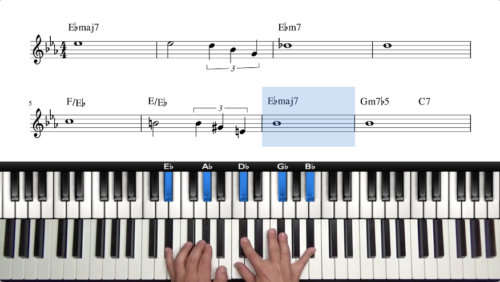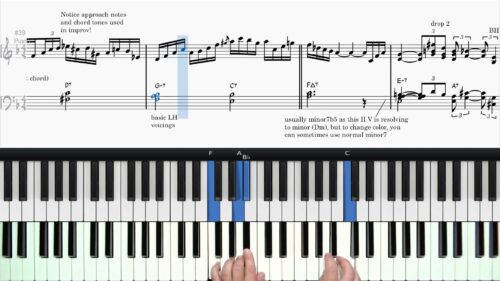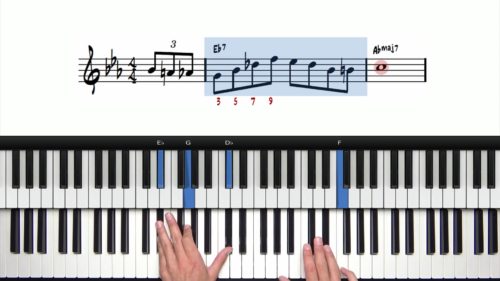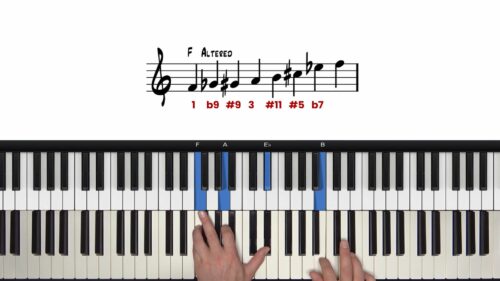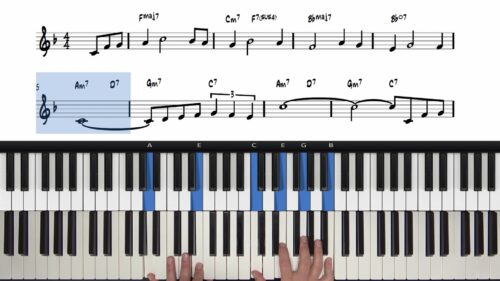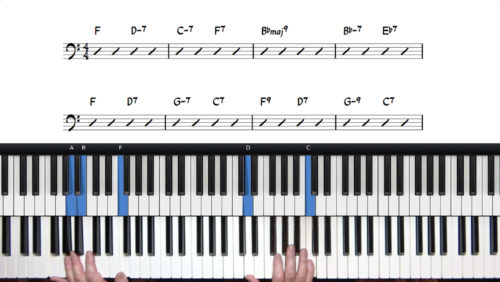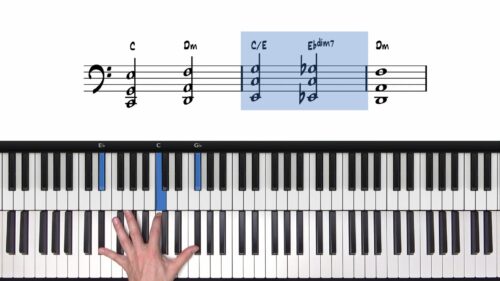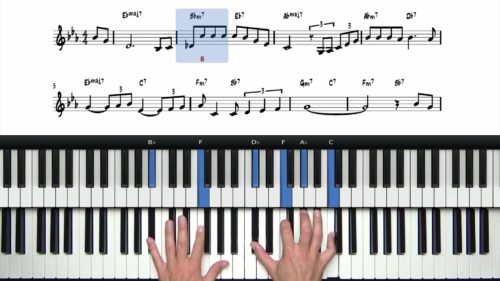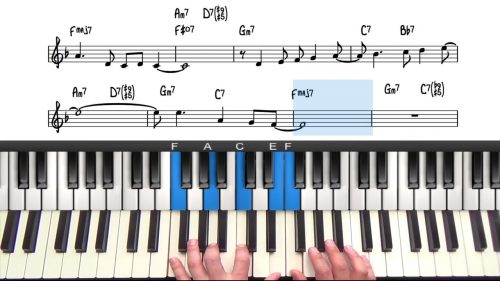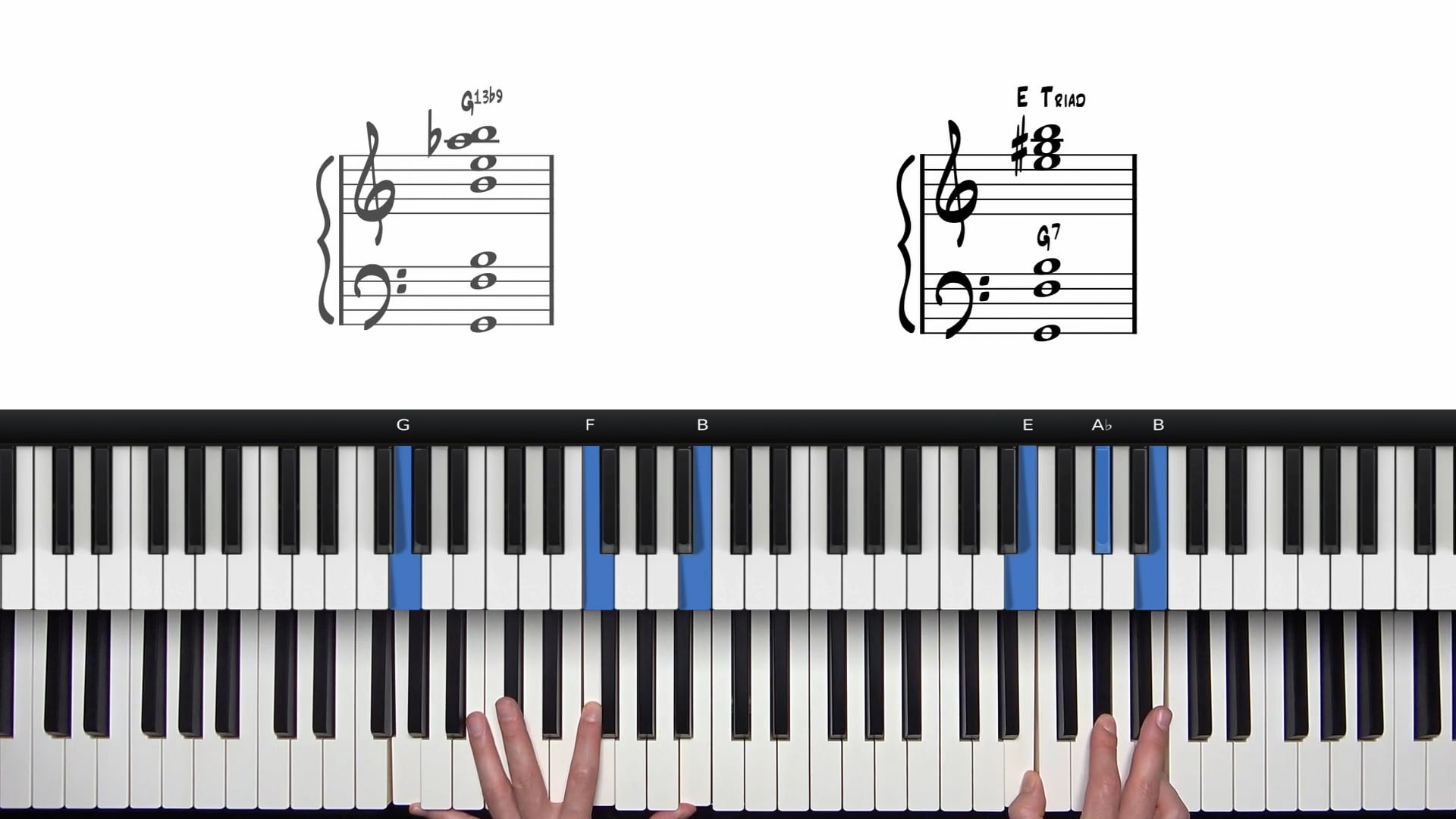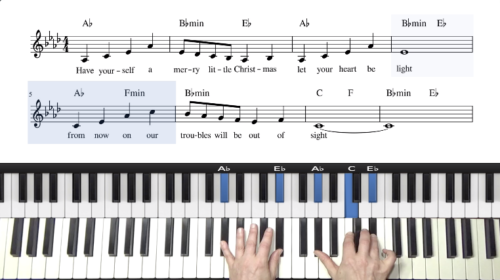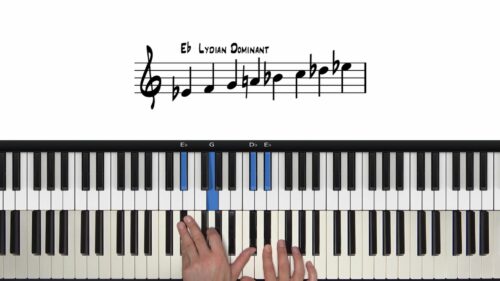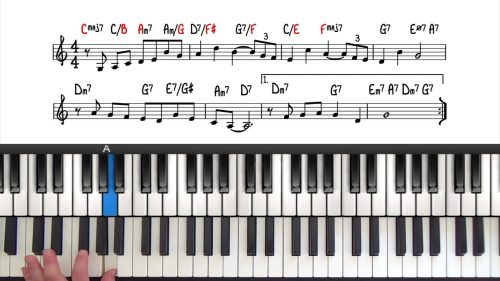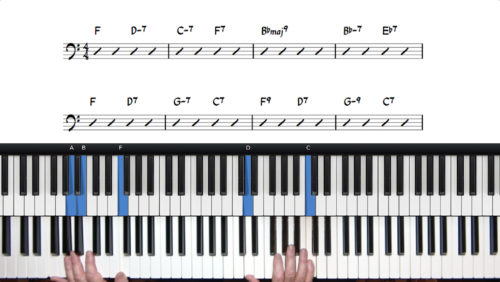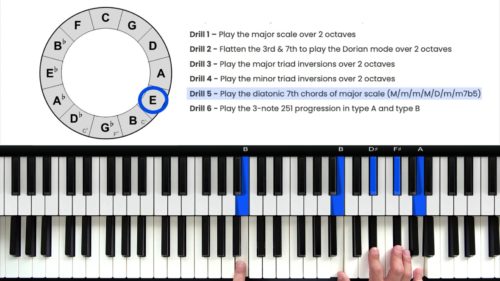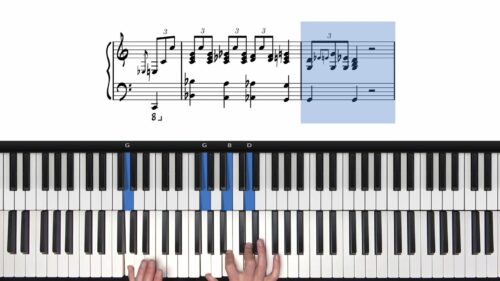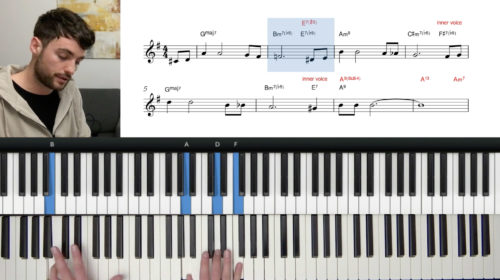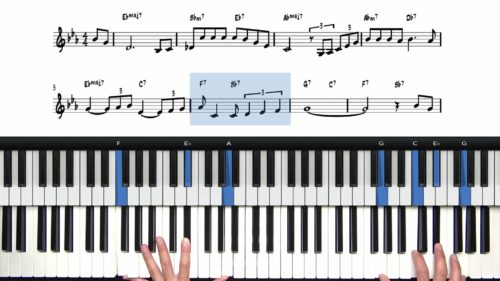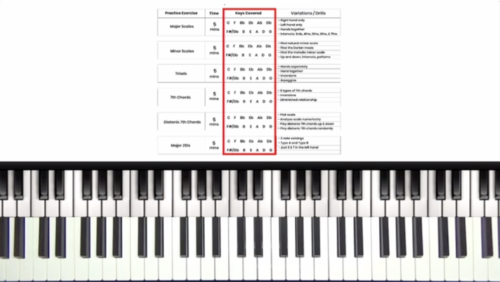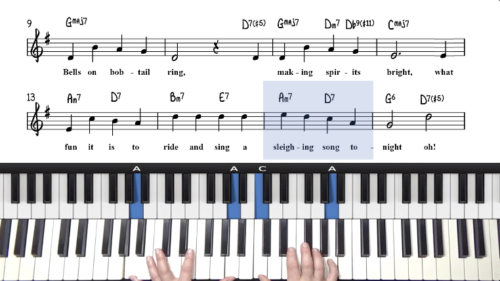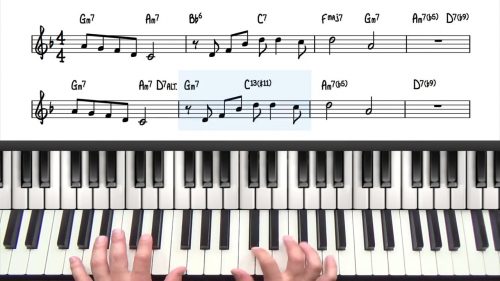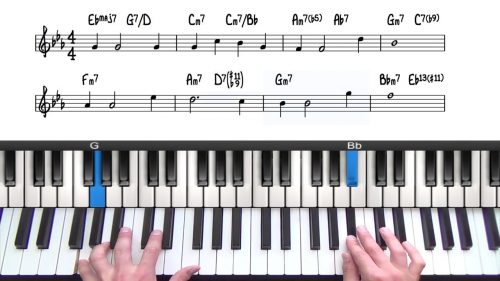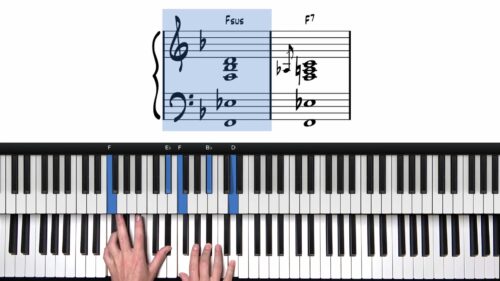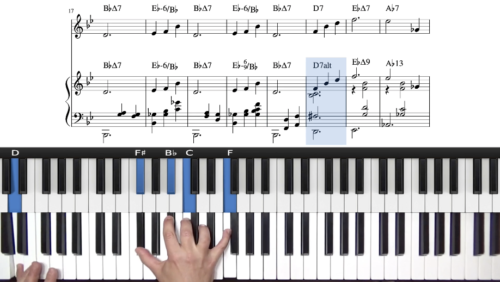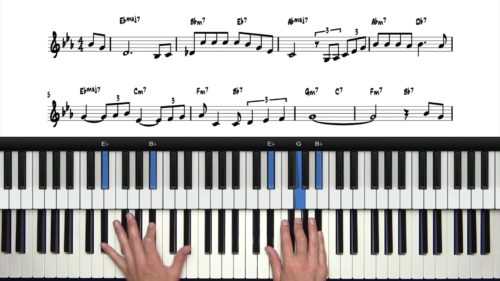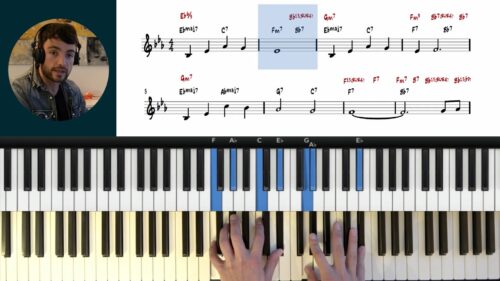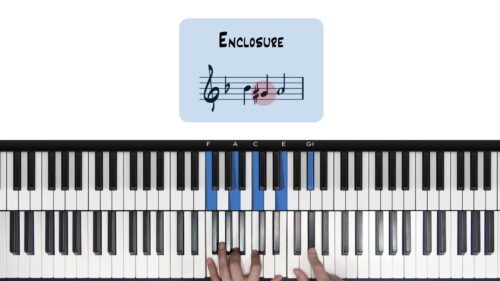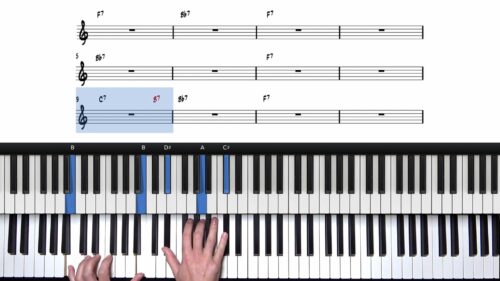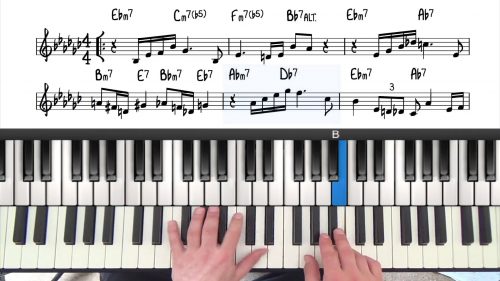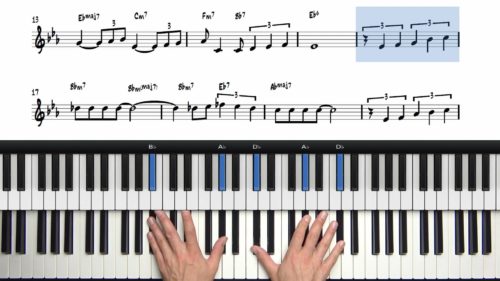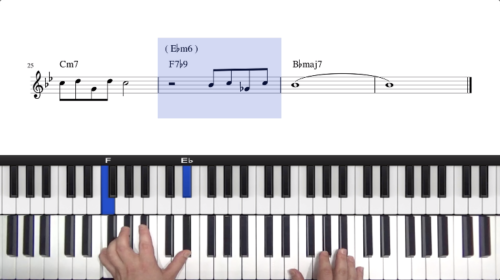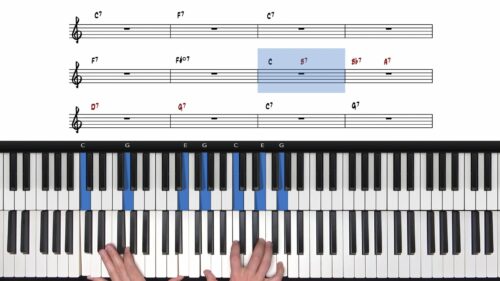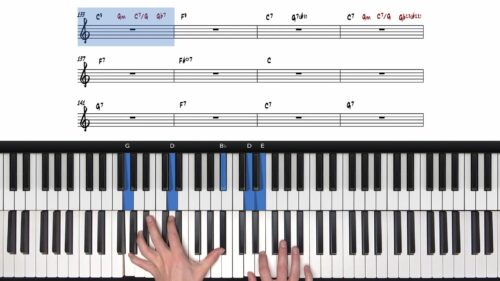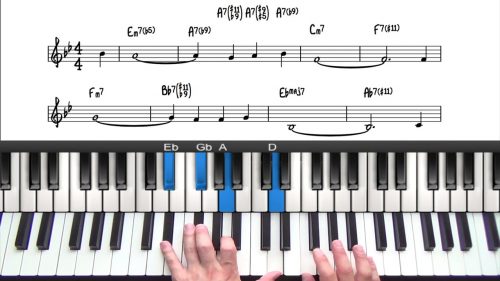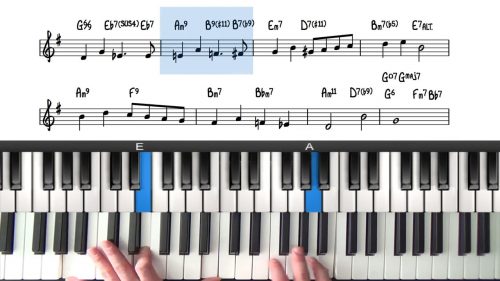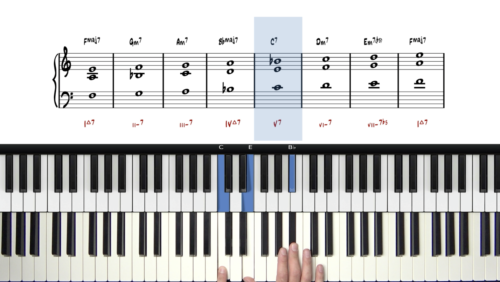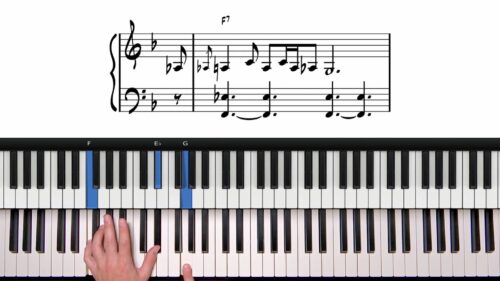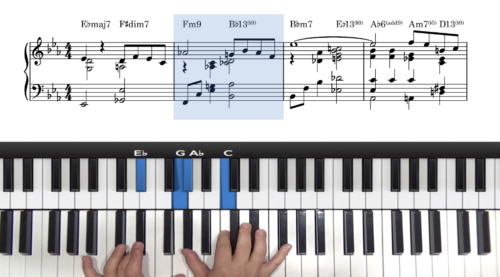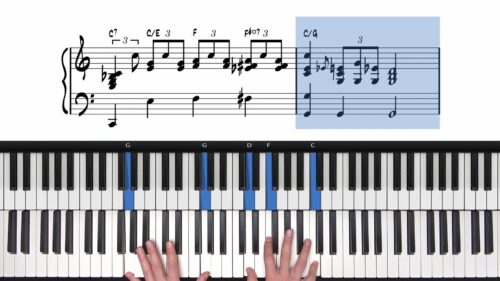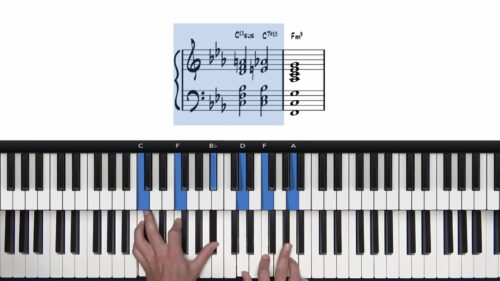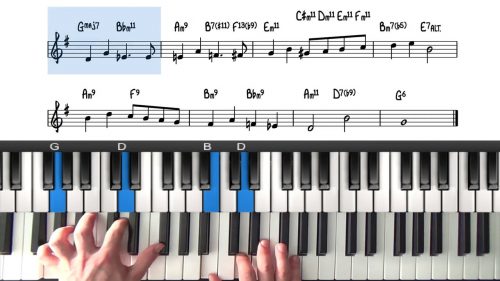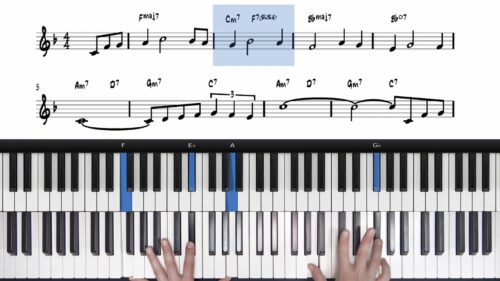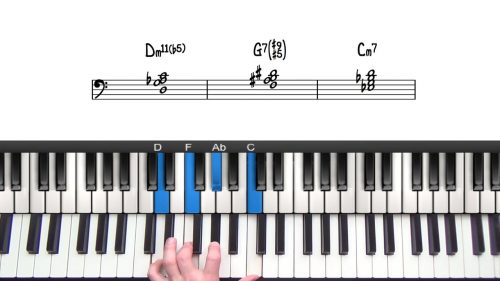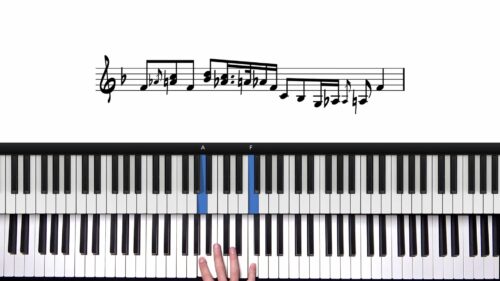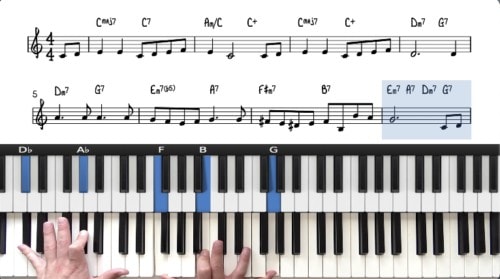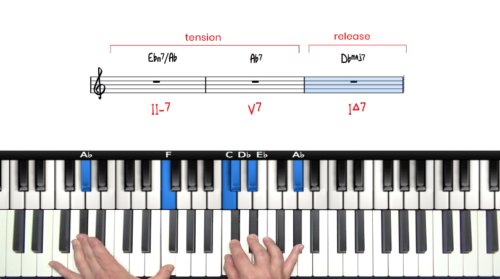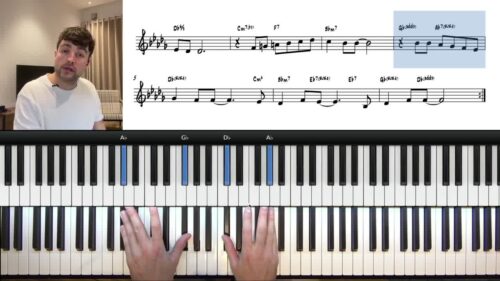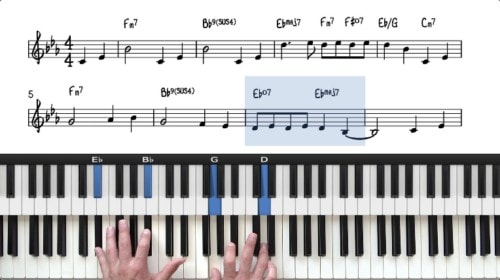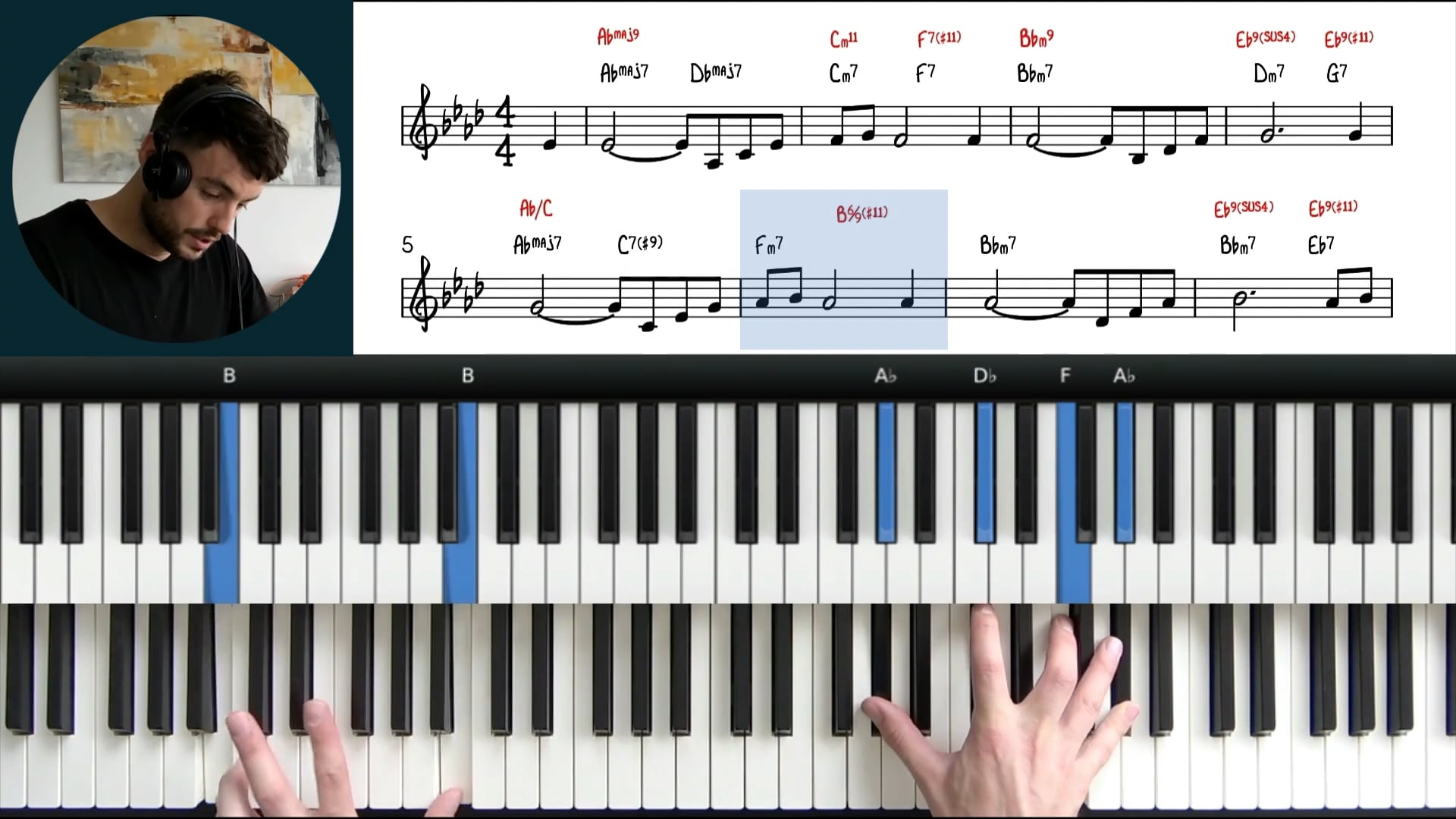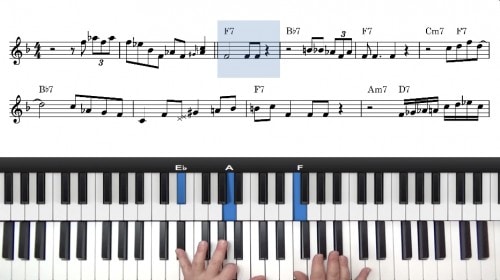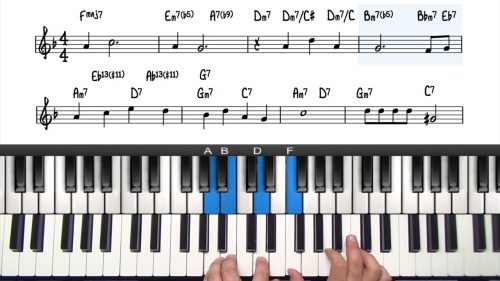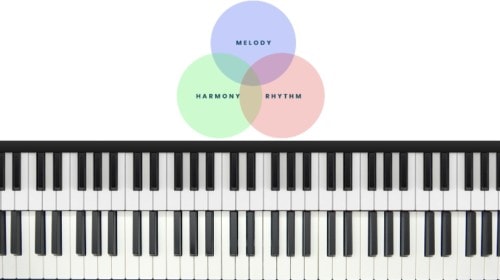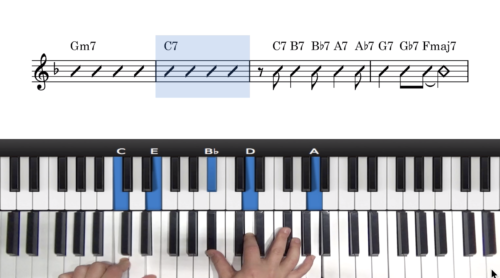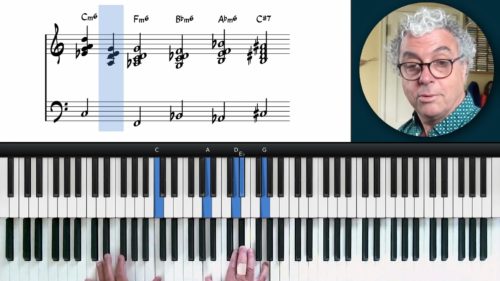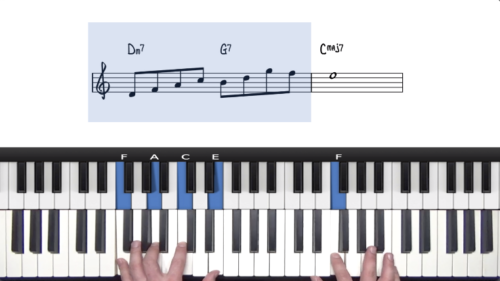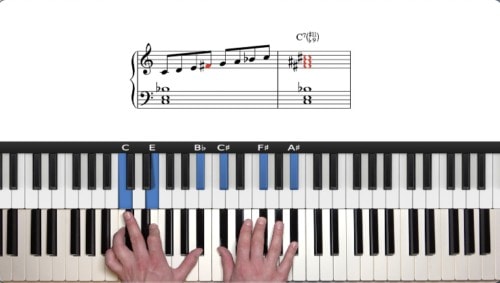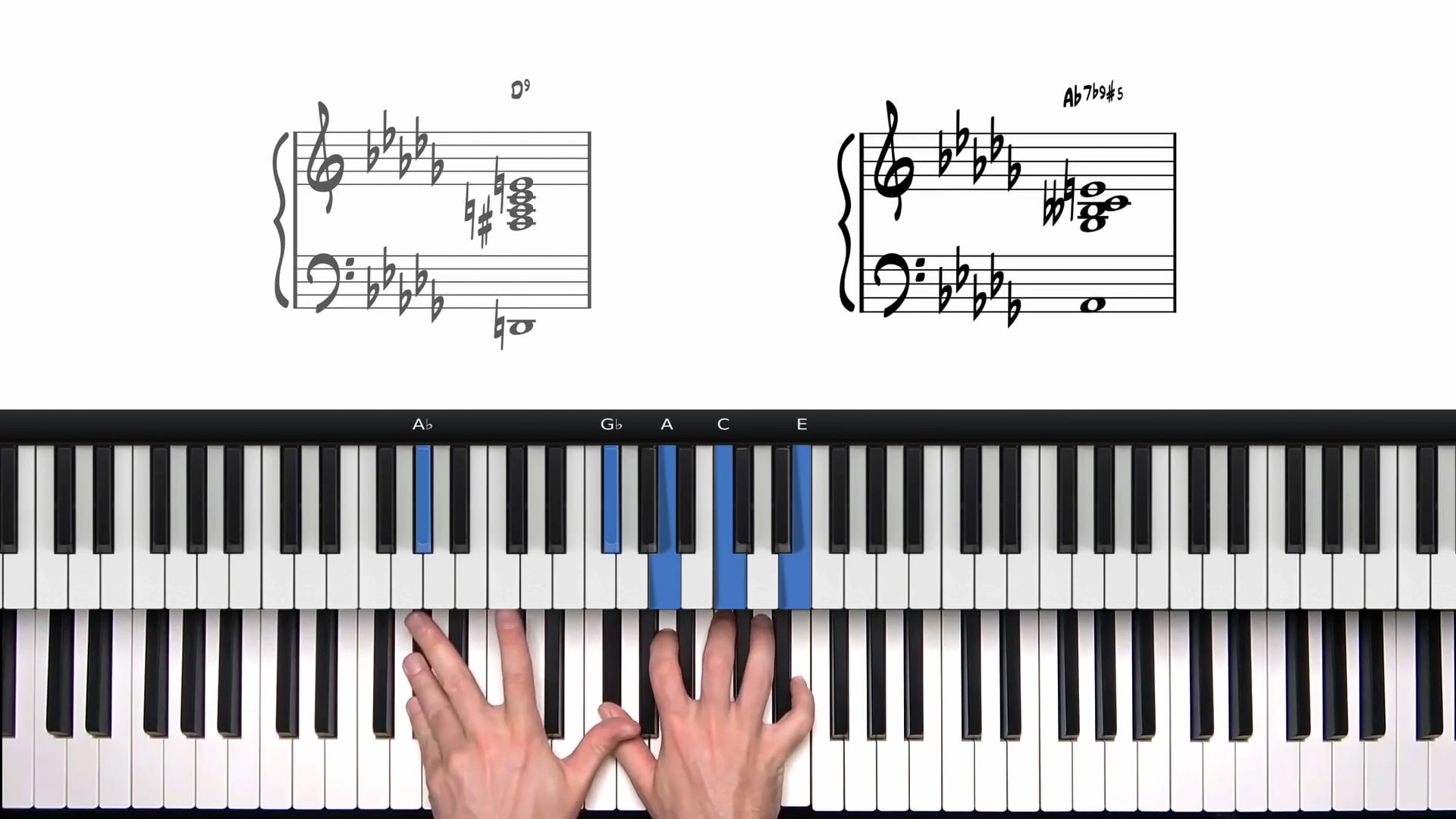Lesson Index
Filters
In this lesson, we will explore a simple Samba groove that will be effective for working with all kinds of Brazilian Samba and Bossa Nova tunes.
We explore the key of Eb Major including the diatonic 7th chords and the common chord progressions such as the 251 and 36251 progression.
Before we start to use the chosen melody as a tool for improvising, you must play through all 12 keys with simple voicings in your left hand.
In this lesson we create a simple vamp using the 251 and 2516 progression in the key of G Major using Brazilian rhythms.
In this lesson, we are going to learn about incorporating the voice into our playing, right from the beginning of learning a tune – Body & Soul.
In this lesson we will analyse a transcription from one of the most influential pianists in history of jazz music, Bill Evans.
In this lesson we provide an introduction and overview of New Orleans music in general as represented in its various piano styles.
We introduce the concept of whole-step 251 drills, and how they can be an interesting alternative to drills around the circle of fifths.
In this beginner lesson we explore the 3 different minor scales and how and why they are used in jazz harmony, and jazz improvisation.
We explore the voicing options for major chords under each note of the Lydian Mode which is a common scale to play over major chords.
Boogie-woogie is a distinct and significant branch of the Afro- American musical heritage which pretty much became American popular music.
We play the harmony over 2 hands and then we play both the bass and harmony in our left hand to create a basic left hand stride style.
In this lesson we explore the key of Bb Major including the major scale, diatonic 7th chords, and 251 progression in the key of Bb.
In this lesson we will explore the tune “Corcovado” by Antonio Carlos Jobim and analyse the introduction which is often missed in performance.
This type of passing chord is a dominant chord built a half step up. Dominant chords always have a strong pull to resolve a half step down.
In this lesson we explore the anatomy of the Hammond B3. We discuss the drawbars, presets, pedals, percussion, & chorus vibrato settings.
We delve into fundamental music theory, focusing on the C Major scale and the chords that we can create using the notes of the scale.
You will learn how to browse the PianoGroove course library using our course index page, the course genre pages, and the syllabus pages.
We will explore some of the more advanced applications, and how you can add this to your playing right now to sound like a jazz piano pro.
To play a rootless voicing we leave out the root of the chord and play one of the upper extensions to get a richer, more colourful sound.
Dive into Db major harmony in this jazz piano course. Learn the essential chords, progressions, and techniques to master “Body and Soul”.
Scales provide the basis for understanding harmony. Learning and memorising the 12 major scales is the first step in learning jazz piano.
In this lesson we explore gospel walk-ups and walk-downs and how to add chromatic passing chords to our chord progressions.
In terms of harmonic structure, Bossa Nova has a lot common with jazz music as both share a sophisticated use of seventh and extended chords.
Extended chords create a richer and more complex sound than triads and 7th chords and are used to create more interesting progressions.
Diminished scales and chords are a very important subject. Diminished harmony works as a ‘base’ or a ‘spine’ to all harmonic movement.
Tritone Substitution is a useful reharmonisation technique that can be used to add harmonic interest and variety to a chord progression.
The purpose of this lesson is to introduce the minor blues form and explore the differences to the standard 12 bar form.
In this lesson we explore general improv concepts such as: arpeggios, approach patterns, enclosures and turns and chord tone soloing.
The tune “Emily” is played in many different keys, but we will create this arrangement in the key of G, like several Bill Evans recordings.
We introduce the basic blues form in C and cover a series of drills to help you become familiar with triad and 7th chord inversions.
As a jazz pianist it’s important to understand the differences and similarities between keys and scales. This lesson explains all.
In this lesson we explore the applications of the rhythmic concept of the “fork”, as well as common chord progressions and voicings.
In this tutorial we create a solo arrangement for “Georgia On My Mind” applying the major blues scale with some soulful licks and riffs.
We can always play the last 4 or 8 bars of the tune as an intro. In this lesson, we will explore other ways to create introductions for any tune.
In a minor 251, the 5 chord will be an altered dominant chord. In this lesson we apply altered dominant chords to the major 251 progression.
In this lesson we are going to arrange the tune “The Nearness Of You” using simple voicings containing the roots, 3rds, and 7ths.
This lesson features 3 choruses of comping over the tune Autumn Leaves using a selection of voicing techniques and accompaniment principles.
In this course we’re going to focus around a post-war Chicago Blues style that applies to many other styles of blues and improvised music.
Block chords are used for harmonising a melody line by moving the notes of the chord in parallel, following the same rhythm as the melody.
In this lesson Jovino explains his composition “Samba at Purchase” which was composed in a student workshop at Purchase College in NYC.
In this course overview, we identify the 7th chords and then move into chord extensions, chord alterations, and stride left hand techniques.
We outline the expectations of you as an accompanist and provide tips on working with singers to help them achieve their best performance.
Lead sheets are a useful tool when starting out with jazz, but by learning tunes by memory, it will benefit your playing in a number of ways.
The 12 bar blues is the most common blues chord progression. In it’s most basic form, it contains just the I, the IV and the V chords of the given key.
In this lesson we introduce the tune Jingle Bells and explore the core pillars of the harmony before reharmonising and arranging the tune.
In this lesson we explore two of the most important and foundational elements of Cuban music which are the clave and the cascara.
In this lesson we introduce another simple line based on chord tones and arpeggios and play this over the minor 251 in all 12 keys.
This lesson provides an introduction to Jovino’s course where we explore Hermeto Pascoal’s unique approach to triad improvisation.
We start this course with a brief overview and history of Brazilian music and we distinguish the key differences between Samba & Bossa Nova.
We explore the basic 145 gospel blues progression using a blues shuffle feel. If you are new to gospel piano, this lesson is for you!
Learn how to play a blues shuffle for the 12 bar blues. We explore bass line examples and discuss the role of swing in our left hand shuffle patterns.
This is a short interview video with Jon where he shares his tips and insight for students who are new to jazz, blues, and funk music.
In this lesson we create a simple but beautiful arrangement of the well-known Christmas tune “I’ll Be Home For Christmas”.
Learn the iconic 8 bar blues based tune- “Tipitina”. We explore the playing styles of Professor Longhair, Dr John, and James Booker.
We play the Diatonic 7th Chords from the F Major Scale. In jazz piano we use 7th chords as the minimum to create jazzy sounding voicings.
Diminished 7th chords are not as common as major, minor and dominant chords and so you don’t see them as often in jazz standards.
Dive into the essential harmonic components of Eb Major: the major scale, diatonic 7th chords, and the common progressions 251 and 36251.
Intros can be useful to extend the length of your performance and also to establish the tonality or the key in which the tune is being played.
In this lesson, we explore the minor 25, and how to use our chosen melody over any minor 25 progressions and also the tune we are studying.
In this lesson we are going to start learning the tune “Georgia On My Mind” using 3-note spread voicings on the A Section of the tune.
In this lesson we explore some simple Bossa Nova and Samba grooves over the 251 progression and 2516 progression in the key of G Minor
In this lesson we build on the foundation we laid with the left hand by exploring right hand blues patterns. Jon talks us through the basics of the right hand and shows us some variations available for the 1, 4 and 5 chords.
In this lesson we build upon the 3-note voicings introducing 9ths and 13th to drill the 251 progression in whole steps around all 12 keys.
When playing “In A Sentimental Mood”, we must be aware that there is a modulation when we move from the 2nd A section to the B section.
The left-hand is the foundation of the driving rhythm, over which the right-hand can… well… dance! Let’s look at the characteristics of the style.
In this lesson we examine the harmony of the B section which is also known as the bridge. We cover 2 useful drills to memorise the harmony.
In this lesson we will take a look at one of the leading figures in the development of bebop and modern jazz, Bud Powell, and his solo on Sonny Side.
Welcome to this video where we will work on more advanced exercises for melding your singing and playing, learning Body and Soul, and advancing your connection to the piano.
In this lesson I explain what drop 2 voicings are, how to construct them and how to practice drop 2 so that you are familiar with them in all 12 keys.
In this lesson we learn the harmonic framework of the blues which is the I, the IV, & the V chord and we create 7th chord voicings.
We will explore the layout of the Pro Member Dashboard and how to track your progress through the lessons and courses on the website.
We explore the tune “Fotografia” and isolate the different components of performance including harmony, melody, comping, and improvisation.
Introduced by the pianist Bill Evans, the ‘So What’ chord is a minor 11th voicing that sounds great over minor chords with the 5th in the melody.
Rootless voicings sound more professional than root based 7th chords and they voice lead much more smoothly in a 251 progression.
251s feature heavily in Bossa Nova music and it’s a good idea to learn to play major and minor 251 progressions with a Bossa Nova groove.
we explore how we can enhance the form with inversions, passing chords, substitutions and a minor turnaround to take us back to the top.
In this lesson we explore the differences when playing the 12 bar blues solo piano, and when accompanying a singer or playing with a band.
In this lesson we continue our exploration of warm up drills and we voice the primary chords of the blues with the 9th chord extension.
We arrange the A section of the tune “Misty” with 3-note spread voicings which contain the root, 3rd, 7th, and sometimes the 5th.
In this lesson we explore the classic choro piece, Vou Vivendo by Pixinguinha.
The half-whole diminished scale is an 8 note symmetrical scale that’s used for improv. The scale alternates half and whole steps until it starts again.
We explore voicings for each note of the dorian mode. Watch this and never again get stuck on what to play for minor chords!
The chord changes are relatively simple and there’s lots of 25s and 251s to get us familiar with these very common progressions.
The So What chord voicing contains all 5 notes of the pentatonic scale. That’s why it works so well in so many different harmonic situations.
We have voiced minor 251 progressions with our left hand and so now it’s time to spread the notes across 2 hands to get bigger chords with more impact!
In this tutorial we will explore some useful formulas and techniques that can be used to create solo piano introductions in minor keys.
We first learn the note names, then intervals, and then we learn the triad which is the most basic building block of harmony.
In this lesson we explore the harmonic and rhythmic structure of the blues, how the blues is constructed, and how it is commonly played.
This tune was composed in 1979 when Jovino joined the band of Hermeto Pascoal. The tune is a Samba and also incorporates the Baião style.
In this lesson we’ll analyse the harmony of “There Will Never Be Another You” to help memorise & internalise the chord changes and song sturcture.
In this lesson we explore some alternate reharms for the A section of Jingle Bells using diatonic progressions and tritone substitutions.
We explore the key elements of an effective accompaniment. We will discuss your role in terms of the melody, the harmony, and the bass.
In this lesson we are going to learn how to memorise major scale fingerings and proper technique when playing scales in all 12 keys.
In this lesson, we’re going to explore an important tritone relationship to help you quickly access altered dominant chord voicings in all keys.
When we are learning to improvise, we must take lots of little ideas from our favourite recordings and then transpose around all 12 keys.
In this lesson Jovino explores triads that can be used over major, minor, dominant and diminished chords.
In this lesson we broaden the harmony of the 145 progression by introducing alternate chord changes, reharms, and passing chords.
We create a solo piano arrangement of the song Spartacus Love Theme – written by Alex North. The arrangement is in the style of Bill Evans.
First, we break down the anatomy of a swing line and we will talk about the variables and dynamics of swing that you can add to your playing today.
Learn to comp and improvise over the tune “The Days Of Wine & Roses”. Study 2 comping choruses and an improvised solo over 2 choruses.
We explore inner voice movement over major, minor, and dominant chords, and then we will apply this information to a well-known jazz standard.
We will start with left hand voicings to get a good grip of the melody and chord changes. We’ll then add in some bigger voicings and passing chords.
The basis of learning music and especially improvised music is to be able to recognise different intervals, melodies and harmonies.
Now that you understand the basic blues form, it’s time to create the more interesting and sophisticated jazz blues progression.
In this lesson we explore the 1625 turnaround to create a continuous stream of 3 jazz Christmas arrangements in the key of C Major.
In this lesson we focus on the first 8 bars of the tune “Misty”. We identify the 7th chords and then create 2-handed spread voicings.
We’re going to introduce an exercise that will not only get the 1625 changes in our hands, but make the notes clearer in our mind.
We are going to explore tritone substitution and apply the chosen melody over tritone sub 25s in the song “There Will Never Be Another You”.
In this lesson, we will create a solo piano arrangement of the well-known standard “Waltz For Debby” written by the great Bill Evans.
The Red Garland voicing has a distinctive ‘block chord’ sound, but compared to previous styles of block chords, it has a much brighter quality.
The 12/8 groove is associated with Fats Domino who was one of the most famous musicians to come out of New Orleans in the 20th century.
We create a stride left hand style for “Georgia” and we explore some useful beginner stride piano drills using the harmony of the tune.
We apply inner voice movement over the Imaj7 chord. This is a very useful inner voice to visualise and internalise in all 12 keys.
We analyse the C section of the tune to internalise the harmony. We cover 2 useful exercises to create a basic left hand stride.
The left-hand is the bass player and drummer in a band, both rolled into one. It keeps the beat, it plays the bass line, and it establishes the groove.
We explore the diatonic chords (triads and 7th chords) in Db Major. We practice two-handed spread voicings common chord progressions.
Walking bass is the most common type of bass that you will hear in jazz and jazz blues on the organ. In this lesson we explore the theory.
For this masterclass, we will be using closed position voicings, meaning that the notes of the chord are inside a single octave.
Explore the tune “Só Em Teus Braços” by Jobim. This lesser known tune displays all the characteristic elements of the Bossa Nova style.
In this lesson we take a look at one of the most copied pianists of all time, McCoy Tyner, and his solo on Passion Dance from the album The Real McCoy.
In this lesson we arrange the A Section of the tune “My Foolish Heart” using triads, 7th chords, and 2-handed spread voicings.
In this lesson we discuss some general improvisation concepts for This Masquerade and also any other jazz standards you are working on.
We will explore the layout of the lesson pages and discuss the lesson chapter interface, lesson downloads, and commenting section.
In this lesson we will explore different ways to create solo piano introductions which can be applied to jazz standards and church hymns.
We explore the unique left hand stride style of the New Orleans pianist James Booker using the famous tune “On The Sunny Side Of The Street”.
Unlock the beauty of “Body and Soul” in this jazz piano lesson. Learn the A section, understand 2-5-1 progressions, and master spread voicings.
Minor harmony is much more complex than major harmony and so the minor 251 progression takes much more time and patience to master.
The Herbie Hancock voicing is a rich-sounding, two-handed minor 11th chord. A perfect choice when the 9th is in the melody over minor chords.
You will learn how to count the blues in 12/8 and how to internalise the 12/8 pulse by completing the exercises demonstrated in the lesson.
There are three types of minor scale: the natural minor, harmonic minor, and melodic minor. Each one has a different use & application in jazz.
In this lesson we explore voicing options for the diatonic chords of C Major. We cover all chord types: major, minor, dominant and -7b5.
This is part 2 of the tutorial on dominant chord voicings. Here we explore voicing options for the natural 4th, #11, 5th, #5, 13th and the b7.
“Just Friends” is a great tune to improve your understanding of the 251 progression and the voice leading of b7ths dropping to 3rds.
Upper structure triads are complex sounding altered dominant chords. They will add texture and sophistication to your playing.
This lesson is a continuation of Jovino’s previous tutorial on the choro piece Vou Vivendo.
Learn a walking bass line practice drill for beginner blues piano players. This walking bass line is perfect to use on the 12 bar blues.
We explore various ways to add harmonic interest over dominant chords using tritones. We use the tunes ‘Body and Soul’ and ‘Misty’.
In this tutorial we explore Jovino’s composition “Alegria na Mata” which can be translated into English as “Happiness In The Woods”.
In this lesson we explore some common exercises that are useful for students who have never played Cuban piano styles or montunos.
In this lesson we explore the B section of the tune Jingle Bells and add reharmonisations and chord substitutions to our arrangement.
Welcome to this lesson on adding fills when accompanying singers. We will discuss the different accompaniment techniques when playing with singers.
In this lesson Hayden explored the altered tensions over dominant chords and how to resolve these tensions into the Imaj7 Chord.
We examine the components of both the right and left hand and explore the interplay between the drums, the bass lines, and harmony.
We have lots of creative freedom when creating our introductions and in this lesson we will explore some of the options available to us.
We examine some of the most common gospel chord progressions that are used for introductions in churches and for solo piano performance.
In this lesson we continue to explore the triad improvisation principle over the major 251 progression and the major 2516 progression.
In this 5 minute masterclass we will explore how we can use triads as a way to create improvised melodies and whole improvised solos.
In this lesson we explore the head melody, comping voicings and improvisation over the tune “There Will Never Be Another You”.
We create a solo piano arrangement using just triads and 7th chords. This is a beautiful tune to share with your friends and family.
A nice place to start out with walking bass lines is to create lines using just the root and 5th with either chromatic or whole step approach tones.
In this 5 minute masterclass we’re going talk about time, and how to improve you own time feel and detect your bad tendencies.
Welcome to our beginner’s course on how to read lead sheets. In this lesson we focus on the A section of the jazz standard “Moon River”.
In this lesson we play through the 1st and 2nd A sections of “Misty” and then explore the B section which is also referred to as ‘the bridge’.
This sounds like a complicated subject, but in fact, this is a concept which will help you simplify your view of piano intervals.
In this lesson, we will explore the diminished chord, and how it connects 4 different dominant 7th chords through the minor 3rd relationship.
This lesson is closely related to the ‘Pentatonic Improv’ lesson so if you haven’t already, I’d recommend you check that out first.
The Rhumba and Habanera grooves are an important element of the rhythmic toolbox of New Orleans Piano to make the music funky.
We take each bar of the A Section and apply licks, fills, and melodic ornamentation that we can use to create a soulful bluesy vibe.
In this lesson we explore the most common montuno patterns that you hear in Salsa and early Cuban music from the early 1940s.
In this lesson we will explore the tune “The Girl From Ipanema” which is one of Jobim’s most iconic and well-known songs.
We explore voicing options for the minor line cliché and also highlight the voice leading in the 251 progressions in D minor and F major.
Jon Cleary delves into the techniques that shape Cuban montunos and we explore the similarities between Cuban and New Orleans piano styles.
Jon demonstrates some signature right hand licks and phrases when playing the 12 bar blues. We discuss the theory and explore variations.
We analyze the A section of “Body & Soul” starting with the melody, then harmony, and finally spread voicings with the melody on top.
For jazz organists, walking bass is played primarily with the left hand on the lower manual, with some elements supported by the pedals.
In this lesson we will take a look at pianist and composer Thelonious Monk and several of his compositions and elements of his playing.
These handy video player tips and shortcuts will help you to watch and review the piano lessons more effectively and efficiently.
Learn the voicings and arrangement of the tune “Please Send Me Someone To Love” in the style of New Orleans piano legend James Booker.
After exploring the A section in our previous lesson, we now focus on the B section to solidify our knowledge of 2-handed spread voicings.
In this lesson we’re going to create a solo piano arrangement of the song “I Loves You, Porgy”, written by George and Ira Gershwin.
Coltrane changes, also known as the ‘Major Third Tonic relationship’ is a harmonic movement where instead of one tonic center, we have 3.
We play the roots in our left hand, the melody in our right hand, and focusing on the selection of the 3rds and 7ths somewhere in between.
The Kenny Barron voicing is an minor 11th chord voicing built from 5th intervals. The voicing is names after acclaimed jazz pianist Kenny Barron.
Dive deeper into the A section of the tune and explore ways to add variations to our playing during the repeating A sections.
When starting out playing Bossa Nova standards, it’s a good idea to separate and isolate the different elements that make up a Bossa Nova groove.
We build a triad a 4th up from each chord to create a suspended triad fill which smoothens the transitions between the chords in the blues.
In this lesson, we will introduce right hand improvising primarily using the notes of the minor pentatonic scale and the minor blues scale.
251 progressions are essential components of the jazz language and so taking the time to memorise them will greatly benefit your playing.
Explore the most common chord progressions in C Major including the 251 and the 36251 with many variations in voicings and alterations.
In this module we focus on the 12/8 pulse and common space fillers to create an engaging and interesting slow blues piano performance.
This is part 2 of the tutorial on dominant chord voicings. Here we explore voicing options for the natural 4th, #11, 5th, #5, 13th and the b7.
We introduce chord extensions into our voicings for the A Section of “Misty”. Chord extensions include the 9th, 11th, and 13th.
Learning and memorising all of the upper structure triads is a daunting task! This lesson introduces the upper structure cheat sheet.
In this lesson Jovino breaks down and demonstrates how to feel 2/4 time which is commonly played in Brazilian music and standards.
We explore how you can use So What voicings not only for minor chords, but also major chords by creating a quartal maj13 voicing.
In this lesson Jovino explains the creative process behind his composition “Carmel” which is a Baião in the key of Bb Major.
In this lesson we create a beginner focused arrangement of the tune “When Sunny Gets Blue” using roots, 3rds, 7ths, and the melody.
In this lesson we look at Jovino’s arrangement of Antonio Carlos Jobim’s choro Falando de Amor.
In this 5 minute masterclass we will look at how a pair of triads can define any mode and become a strong sound for improvising and comping.
In this lesson we will shift the focus onto our left hand and explore some useful left hand patterns, mainly focusing on the shuffle feel.
Chord tone soloing is the process of creating improvised lines predominantly or exclusively with the primary tones of the chord.
When jamming with other musicians, you will be required to perform different roles from playing solo piano. Most of your time will be spent “comping”.
An important point with sus chords is that we often resolve the suspended 4th to turn the chord into a regular dominant 7th voicing.
In this lesson, we discuss a number of important considerations when soloing with a singer. We then cover the most common ways of ending the tune.
In this lesson, we explore rhythms, voicings and comping patterns for common chord progressions in major keys such as the 25, 251, & 1625.
In this lesson we expand on the material covered in the previous video and look at the minor 251 and associated triad options.
We start by playing through with left hand voicings and then talk in length about the 1625 progression and how you can use it to develop introductions.
‘Someday My Prince will Come’ was a popular tune with the jazz musicians of the 20th century and is still played in jazz clubs, hotel lobbies and weddings.
In this 5-minute masterclass, we will walk thought a number of vocal exercises that can help you gain valuable information about your voice.
In this section of the tutorial we are going to explore how you should be developing your swing feel and also your ability to improvise in general.
This lesson is a quick analysis and performance of the left hand voicings in the tune “Alone Together” to preare you for the improv tutorials.
In this lesson, we will work through the entire song and discuss how to choose the most suitable voicings and adding melodic embellishments.
The roots of the Lyndian Concept can be traced back to Pythagoras who was a musician, mathematician, and philosopher.
In this lesson, Jovino answers some questions on triads and explores some ideas on how to create complex sonorities from a simple base.
In jazz, Rhythm Changes is a common form. It’s very popular in jam sessions and a crucial part of everyone’s piano repertoire.
In this lesson we explore how you can navigate over the minor line cliché using bass lines, two-handed chords and left hand voicings.
Tuomo shows us 3 different altered dominant 251 lines and then shows how we can create our own melodies over altered dominant chords.
Learn the unique improvisational techniques of James Booker including single melody line tricks, tremolos, rolls, licks, and turnarounds.
There are two different kinds of chromatic 25s, descending 25s, and ascending 25s. In this course, we are going to focus on the descending 25.
We explore how we can break up the 4 beats of a bar, place accents on the weaker beats, and introduce dissonance into our chord voicings.
In this lesson Jon takes us through some left hand variations on a 12 bar blues including walking bass lines and the New Orleans style tuba bass lines.
We explore right hand chordal techniques built from the 3rd, the 5th, and the 6th of each chord, and also how to create contrary motion.
“Stardust” by Hoagy Carmichael is 48 bars long including the 16 bar introduction. From bar 17 onwards, the tune then follows a standard ABAC form.
We introduce the b9 chord alteration into the whole step 251 drill by lowering the 2 middle voices in our right hand voicing shape.
We explore simple voicings for the B section. In the previous module we analysed the harmony, and now we will introduce 3 note spread voicings.
We will now introduce the melody in our right hand and explore some different techniques for outlining the harmony in our left hand.
We’ll learn some basic right-hand chord voicings and rhythms, and some specific riffs you can use in many places when playing boogie-woogie.
Understanding the foldback of the pitches on the lower manual is important to inform the melodic contours of your bass line.
In this lesson we will take a look at one of the greatest pianists and virtuosos of all time, Oscar Peterson, and his solo on C Jam Blues from the album Night Train.
In this lesson we focus on the C section which introduces different harmony and melody and distinguishes it from the A and B sections.
Each lesson page contains a “Bookmark This Lesson” option which is a handy feature to set goals, practice reminders, and track progress.
One of the most important things to remember is that “Comping” is shorthand for ‘accompanying.” It’s a subordinate role in the band.
As a jazz pianist, you need to have a solid understanding of intervals so that you can build extended chords quickly and improvise freely on the piano.
This tune follows a standard 32 bar AABA form and there is also a 24 bar introduction which we are going to include in the arrangement.
We explore chord voicing techniques for the C section of “Moon River” and consolidate the overall structure and form of the tune.
In this lesson, we shift our focus to the B section – also referred to as ‘the bridge – which introduces two significant key modulations.
A very important point is that it’s not absolutely necessary to play all of these elements concurrently throughout the performance.
In this lesson, we’re going to introduce some more interesting and exotic sounding scales we can use to solo over the minor blues form.
We can also achieve some really interesting sounds by applying upper structure triad theory to both major and minor chords.
In this lesson we explore some advanced applications of upper structure triads in context of jazz standards we have covered.
In this lesson we will learn to feel a 12/8 pulse for a tune written in 4/4. This is useful when improvising in a slow blues style.
In this lesson, we explore triad-based space fillers and how to combine our left and right hands whilst maintaining a steady 12/8 pulse.
In this lesson we will discuss the key principled for playing hymns and adding a blues, jazz, or gospel flavour to the accompaniment.
We add the B Section to “Georgia” so that we can play the whole tune in its entirety. We also discuss the modulation to the relative minor.
We discuss some important principles for creating a simple walking bass line and then apply the principles in the context of 251 progressions.
In this lesson we explore the functional harmony of the tune “Moon River” to gain a deeper understanding of the chords and progressions.
The stride left hand style drives forward the pulse of the tune and frees up our right hand for melodic embellishment and decoration.
We start the lesson by recapping the basic theory behind sus chords and then explore them in context of major and minor 251s
I’m going to cover a few ideas and concepts that will help you think of the piano as an orchestra and think of your solo jazz piano arrangements as an orchestration.
The concepts we’ll be focusing on are target notes, approach patterns and chromaticism. Understanding these principles will give you line structure.
This lesson follows on from Jovino’s previous lesson on Jobim’s Falando de Amor and looks at accompaniment and improvisation.
In this lesson we will combine quartals and upper structures to create some quartal upper structure voicings that are well suited to a comping setting.
The Christmas Song is also known as ‘Chesnuts Roasting On An Open Fire’ and this sentence is also the first line of the lyrics.
This lesson simplifies the complexity of the samba groove by breaking it down into 3 manageable parts – easy to follow for beginners.
In this lesson we will take our study of chord tone soloing a step further by incorporating triplets and swing 8th notes into our improvised lines.
Minor progressions often contain altered tones which can be used to add interesting colours to your progressions and groves.
In this lesson we will explore some useful voicings, patterns, and rhythmic ideas for right hand comping over the 12 bar blues.
In part 2 of this tutorial, we dive straight into the chord changes with two handed voicings and create an advanced ballad arrangement.
We study leading tones and how they are used to create smooth connections between chords and also to guide the vocalist or choir.
We explore comping voicings and improvisation for “Alone Together” which is a commonly called jazz standard written in a minor key.
This ballad is an absolute staple of any jazz setting. It’s well known and one that both singers and instrumentalist seem to universally love.
In this lesson we’re going to create a solo piano arrangement of an old song ‘Manhattan’, published 1925 and written by Rodgers And Hart.
In this course we will take a look at one of the most influential modern jazz pianists, Herbie Hancock, and his solo piano performance of “Someday My Prince Will Come”.
In this 5 minute masterclass Tuomo demonstrates 3 common blues lines that can be played over a 251 cadence in the key of F.
Welcome to part 2 of this lesson on the tune Stardust. In part 1 we explored the 16 bar introduction and now we’re going to move into the main tune.
In this 5 minute masterclass we will explore the key principles for creating elegant, efficient, & ergonomic chord voicings.
We identify areas where it’s appropriate to apply a left-hand stride and also areas where a simpler voicing configuration is more suitable.
Learn how to improvise over montunos that can be used when playing with a bass player and also when playing montunos in a solo piano context.
“Come On Into My House” is a good example of Booker’s so called “3-Hand Approach” as his playing sounds like it is being performed by 3 hands.
We’ll examine the right-hand riffs and licks that make the boogie-woogie style so infectious. We will also explore the blues and pentatonic scales.
In this lesson, we introduce a stride left hand style over the bridge of the tune “In A Sentimental Mood”.
Passing chords are temporary stepping stones between chords, adding variety and making your playing sound more interesting & dynamic.
This lesson aims to illustrate the thought process behind choosing voicings and making real-time decisions when playing from lead sheets.
The triad is the basic building block for many different types of chords. The 4 types of triads are major, minor, diminished and augmented.
Slash chords contain 2 bits of info, the 1st letter indicates what chord should be played & the 2nd letter specifies the bass note of the chord.
In this lesson we introduce chord extensions which include the tones 9, 11, and 13 and we apply 3 very useful minor extended voicings.
For the first lesson in this practice series, we will explore some useful drills and exercises for practicing major and minor 9th chords.
We introduce the “9th” chord extension and left-hand 10ths to create fuller sounding chord voicings with a strong harmonic foundation.
In our final lesson on ‘Body and Soul’ we play through the entire tune with insights on voicings, modulations, and performance techniques.
In Part 3 we will add ornamentation to the melody, creating much more melodic interest and a nice climax towards the end of the tune.
Learn to target the b9 chord alteration over the V7 with a descending inner voice. We apply to tunes and then drill around all 12 keys.
In this lesson, we will explore a number of different left-hand techniques and basslines to create interest in the lower registers of the piano.
The secondary dominant, or 5 of 5, is one of the fundamental extensions of the basic 2-5-1 progression in jazz harmony.
For this first lesson we will explore voicings and improv for the 1625 turnaround which is used to transition into the improvised solo.
Learn how to add a live seminar to your calendar, how to browse the archived seminars. and how to use the seminar chaptering system.
Typically, being placed on the last 2 bars of the form, the turnaround is used to lead smoothly and convincingly back to the first chord.
We’re now going to take the study a step further by adding scales into the walking bass lines and enhance the rhythm and swing feel of our lines.
We create a full solo piano arrangement of the tune “Moon River” incorporating interesting voicings, fills, and reharmonisations.
In this lesson we will explore how to add passing chords and additional 251 progressions into church hymns and songs found in gospel music.
Using the well-know tune “In A Sentimental Mood” we’ll explore the options available to harmonise step-wise melody lines.
In this lesson we are going to identify the chords within the 1625 and 3625 where we have the freedom to change the chord qualities.
We explore a fill technique using descending 4th intervals which is an alternative to the suspended triad fill that we explored previously.
In this lesson we create a beginner arrangement of the jazz piano classic “Body & Soul” using just roots, 3rds, and 7ths in our voicings.
We jump straight in with two-handed voicings, starting with simpler chords and then increasing the complexity of the voicings we choose to play.
Commonly associated with the film “Casablanca”, this classic is written in Eb Major and follows a standard 32 bar A-A-B-A form.
When learning a new jazz standard the first thing to do is listen to as many different recordings of the tune. Then listen and transcribe from them.
We are going to combine out knowledge of chord tone soloing with approach patterns, enclosures, and non-diatonic passing tones.
Using a simple 25 progression, we will demonstrate the key differences between improvising with a straight feel, and with a swing feel.
In this lesson we’re going to look at “A Rã” by João Donato, another simple but surprisingly intricate tune by this great composer.
Transposition is the process of taking a tune in a certain key such as Amin and transposing, or changing it to another key, such as Cmin.
In this lesson Jon breaks down the chord sequence for the tune “Port Street Blues” and discusses the reharmonisations and modulations.
This tutorial introduces the ‘locked hands’ technique. This style involves playing left hand voicings simultaneously with an improvised line.
In this lesson we explore comping voicings and improvisation principles over the tune “Beautiful Love” played in the key of D Minor.
In this lesson we discuss the importance of learning the melody to become more comfortable and confident with melodic improvisation.
We are going to take advantage of our practice time to build a set arrangement of voicings to support our singer throughout the performance.
In this lesson, we will delve into the jazz ballad “Tenderly” which follows an A-B-A-C form. This song is known for its spacious harmony.
Elsewhere in the world, the blues is generally heard in the 12 bar format. Here in New Orleans it is most often played in the 8 bar form.
In this lesson, Tuomo shows us 3 common reharmonisations of a 251 progression that we can play in our jazz standard arrangements.
In this 5 minute masterclass we’re going talk about bebop scales. Bebop scales are scales that derive from the bebop language, adding an extra chromatic note to a basic major, minor or dominant scale.
In these drills we isolate the #11 alteration which is a beautiful colour to add over dominant chords – one of my personal favourites!
My Funny Valentine is a difficult standard to learn. In this lesson we breakdown the complicated chord changes and build a solo arrangement.
When studying music, we often distinguish 3 core components which are rhythm, melody, and harmony. But how are these interrelated?
Left hand 10th intervals establish a strong foundation of the harmony and free up the right hand for melodic decoration and embellishment.
In this lesson we delve into extended chord theory and examine how extended chord voicings can be applied to our jazz piano arrangements.
We use lots of extended & altered harmony & also some interesting applications of inner voice movement, drop 2 and pentatonic voicings.
In this lesson we will explore right hand comping voicings and technique to accompany our own solos or a solo of someone else.
A seventh chord is a triad which has been extended to include the 7th degree of the scale. This creates a fuller sound than simple 3-note triads.
This is a nice simple Christmas ballad with a repetitive melody and straight forward changes. The tune follows an ABAC Form and is written in C Major.
In this lesson we will be exploring the major 251s with b9 and #5/b13 alterations. This will help you visualise alterations in all 12 keys.
We’re going to stack the chord tones sequentially in thirds, playing the 7th chord in our left hand, and the 9, #11, and 13 in our right hand.
We apply chord alterations to the dominant chords in ‘Body & Soul’. We also touch upon the concept of upper structure triads voicings.
Widely quoted as one of Gershwin’s finest compositions, the harmony and melody is challenging with unusual changes and large leaps in the melody.
We examine the slight variations on the A Sections and we will then learn how to connect the A & B Sections together using turnarounds.
In this lesson we will apply the theory from the walking bass lessons and also introduce rhythmic comping and other stylistic elements of walking bass.
We will work on our recognition of major 9th, minor 9th, & dominant 13th rootless voicings using a left hand stride drill.
You will learn how to embellish the turnaround section of the 12 bar blues with blues scale licks using both the major and minor blues.
‘How Insensitive’ is a well-known tune written by Antonio Jobim who was one of the main exponents of the Bossa Nova movement in 1950s Brazil.
In this lesson Jon shows us some passing chords and substitutions, outlining ways to add some elements of surprise into the 12 bar blues.
When writing “Desafinado”, Jobim and Mendonça decided to write a tune with many of these unusual scale degree choices in the melody.
In this tutorial we explore improvisation over “Jingle Bells” using blues scales, blues licks, and other bluesy melodic ornamentation.
Cluster voicings are tightly spaced groups of 3 or more notes that act as a chord. They don’t usually contain both ‘essential chord tones which are 3 & 7.
We create a bigger and more powerful sounding arrangement by playing the right hand melody in octaves above a stride left hand style.
In this lesson we will learn how to add fills between chords by using the triads built on the 1st and 2nd degree of the corresponding scale.
These principles can be applied to any tune. Always remember to look at melody and chords for inspiration when introducing a tune.
Now you have an understanding of a basic improvised line, we will now take it a step further with non diatonic passing tones and chromaticism.
In this lesson we focus on enriching our right hand to add more sophistication and expression when playing the tune “Moon River”.
In this lesson we will create a solo piano arrangement of “How High the Moon” written by Nancy Hamilton and Morgan Lewis.
“Summertime” is a favorite song amongst both singers and players. The form is nice and simple, and the lyrics are fantastic… particularly the 2nd verse.
This lesson on licks and riffs will inspire you to build your own vocabulary that you can use to improvise when playing the 12 bar blues.
In this lesson we will look at a composition by the great guitarist Baden Powell called “Consolação” with lyrics by Vinicius de Moraes.
In this lesson Jon Cleary explores chord substitutions using the iconic New Orleans piano song “Tipitina.”
We will explore the pentatonic scale from a jazz improvisation standpoint applying the scale to different chord types and common progressions.
In this lesson we learn the 7th chords and spread voicings for the B section of the tune “Tenderly” which spans from bar 9 to bar 16.
We start off playing the tune very freely in a rubato manner and the second time through we will firmly establish the rhythm and timing.
With New Orleans music it’s easy to concentrate on the rhythmic aspects but the way we structure our chord progressions is also important.
You can use this bass line or any bass line for playing solo piano, learning different rhythm changes heads, and for practicing solos.
“Power Chords”, or “Chord tone triads” do not contain the 3rd. Instead we have R-4-5 or R-2-5 which can be used to build quartal harmony & voicings.
We play the original melody of the tune in octaves to command a bigger range of the piano and add interest to repeating sections.
In this course we’re going talk about playing outside the changes and I will show few perspectives how you can start to approach the subject.
In this lesson Tuomo demonstrates comping voicings and improvisation over the tune “Billie’s Bounce” which is a blues in the key of F.
In this lesson we explore the Cha-Cha-Cha and the Mambo grooves for solo piano performance and when playing with a bass player.
Using “Boogie-Woogie Prayer” we’ll put together all of the boogie-woogie elements: basslines, licks, slurs, trills, slide-offs, and turnarounds.
The title is interesting as it combines the word “Samba” and “Bolero”. “Sambolero” is a term that was used in Brazil back in the 1950s.
It’s important to understand that ‘improvising using triad shapes’ doesn’t mean that we have to exclusively play the notes of the triad.
Transcription is one of the most time effective ways to learn jazz and you should incorporate transcription into your daily practice routine.
Michel Legrand’s ‘What are you doing the rest of your life’ is a challenging tune to learn and contains some difficult-to-navigate chord changes.
Explore the playing style of New Orleans piano legend Dr John including his voicings, bass lines, blues licks, turnarounds, and endings.
You can use these comping exercises and drills to strengthen your right hand comping on Hammond organ as well as on the traditional piano.
Understanding the relationship between relative major and minor keys is important for analysing the harmony and structure of jazz standards.
The minor 251 progression in the final measures of the bridge is a nice place to add some altered voicings and upper structure triads.
We will explore a number of drills to familiarise ourselves with the sound, colour, and texture of the #11 chord alteration.
In this lesson we will be exploring the common intros, endings, and turnarounds that are found in the Chicago blues piano style.
We have explored major, minor, and dominant chords, now it’s time to put them all together in the most common progression in jazz; the 251 progression.
Mr. PC is a composition by John Coltrane, arguably the greatest jazz saxophone player of all time. We will apply everything from the Minor Blues Course.
In part 2 of this tutorial on “Embraceable You”, we focus on the second half of the form. We create bigger voicings to add a sense of climax and finale.
In part 2, we are going to enhance the melody and add some rhythmic devices into our left hand to introduce the Bossa Nova feel and groove.
In this lesson we will explore a simple way to approach the tune “Autumn Leaves” with a walking bass outlining just the root and 5th of the chord.
In this lesson Jon explores on the turnaround chord progression found at the end of the blues form and shows us ways to expand and embellish it.
In this lesson we will create the major 251 progression with a left hand stride and rootless voicings exercise and drill.
The minor line cliché is a key harmonic feature in the A section of “In a Sentimental Mood”. In the first 2 bars we moving through D-, D-maj7, D-7, and D-6.
It was first recorded in 1931 by Ozzie Nelson and his Orchestra, it was written by Fabian Andre and Wilbur Schwandt, with lyrics by Gus Kahn.
We explore techniques to transition from the 2nd A section into the Bridge and voicing options for the B Section harmony.
Chromatic passing chords add tension, colour, and strengthen the sense of resolution when changing chords in the 12-bar blues progression.
In this lesson we apply the I-VI-II-V progression to the turnaround section using a selection of meaty New Orleans style chord voicings.
In this lesson we will explore some useful devices to add soulful melodic decoration including grace notes, space fillers, and accents.
The tune is most commonly played in the key of C. We reharmonise the changes to create a rich and harmonically complex arrangement.
We build upon what we have covered in the previous tutorials by introducing upper structure triads, sus chords and a stride style.
With your knowledge of chord tone soloing, the blues scale is now just another dimension that you can add to your solo, instead of the whole solo!
The A Section of the tune repeats 3 times and so we can use passing chords to add interest to otherwise identical harmonic passages.
The first jazz standard lesson in this course is “Corcovado” written by the great Antonio Carlos Jobim and lyrics by Vinicius de Moraes.
In part 2 of this tutorial, we will introduce extended and altered chord voicings to create a richer and more sophisticated accompaniment.
In this lesson we will look at another João Donato composition with lyrics by Gilberto Gil called “Bananeira”.
In this lesson we will create a solo piano arrangement of “What Is This Thing Called Love”, written by Cole Porter in 1929.
In this lesson, we explore the time signatures 3/4, 6/8, 4/4, & 12/8 for the same gospel church song “What A Friend We Have In Jesus”.
In this lesson we explore 2 useful features of the Transcribe Software that will help you with transcribing chords and improvised lines.
In this lesson we’re going to create a solo jazz piano arrangement of the beautiful jazz standard ‘If I Should Lose You’.
We explore the gospel stride style using the tune “Down By The River Side”. We cover bass notes, voicings, and right hand melodies.
“True” is a tune composed by Paul Gayton. We break down the famous rendition played by the James Booker at the Montreux Jazz Festival.
While the C section shares some similarities with the B section, it features a distinct ending which is used to bring the song to a close.
In a previous lesson we added passing chords into the harmony, and now we take it a step further with chord substitution & reharmonisation.
We introduce the major modes, explaining what they are and where they come from. These 7 modes play a fundamental role in improvisation.
In this lessons we will explore some important right hand principles and techniques to create that authentic New Orlean piano sound.
Instead of playing everything as a single linear rhythmic pattern, we will demonstrate of combination of subdivisions of quarter note.
In this 5 minute masterclass we will break down 3 bebop lines over a basic 251 progression in the key of Bb Major.
We reharmonise the A section of the song, incorporating Bill Evans style voicing techniques such as quartal harmony and drop two voicings.
We will examine the minor line cliche in the A Sections and then discuss the use of suspended chords in the bridge of the tune.
We explore ways that we can add variety by utilising the different registers of the piano. We’ll also add in some interesting chord reharmonisations.
In this masterclass we’re going create a walking bass line over the tune “Softly As In A Morning Sunrise”. Download the PDF bass line file.
In this lesson we introduce the melodic minor flavour into our improvised lines and phrases. We target the #11 colour tone.
We start with simple two-handed voicings and then create interest by adding in upper structure triads, block chords & chord substitutions.
Spend some time to work these chords and progressions, and once you feel comfortable you can move onto the main 32 bar form of the tune.
Steve’s own composition; The Duwamish River empties into the Puget Sound – the birthplace of the city of Seattle – a city that Steve dearly loves.
In this lesson we highlight the importance of identifying and recognising 2-5-1 progressions which are the cornerstone of jazz harmony.
In this lesson we will explore the tune “Agua De Beber” written by Antonio Carlos Jobim and the lyrics written by Vinicius de Moraes.
In this lesson we explore comping and improvisation over the Bb Blues including drop 2 Voicings, blues licks, and bebop vocabulary.
Most jazz standards that you come across will contain a 251 progression in some form so it is essential that you know how to construct the 251.
After completing the brief harmonic analysis in the previous lesson, we now start arranging the tune “Autumn Leaves” with basic chord voicings.
Most often played as a ballad, this is a great tune to incorporate bluesy licks and riffs. It’s written in the key of Eb Major and has an AABA form.
When we play a minor 251 progression, the 5th, the 13th and 9th will usually be altered by moving them either up or down a half step.
Henry Butler was a master of jazz and blues and in this lesson we will examine his unique “Stride Funk” approach to New Orleans Piano.
We start with the diatonic 7th chords found in the G Major scale and then discuss the different variations of the 251 progression.
We explore Guajira which is a slow tempo form of Tumbao, and the Guaracha which is a fast groove similar to the Son montuno pattern.
My Romance follows a 32 measure A-B-A-C form and the tonality is primarily major. The tune is played as a ballad or medium swing feel.
Learning chord voicings is an important skill for the jazz pianist. In this lesson we cover a 5 step process for learning any chord voicing.
In this series of lessons you will learn the essential skills needed to play stride piano confidently and creatively.
In this section of the tutorial, we will play all of the elements of Bossa Nova which is the bass line, syncopated chords, and finally the melody on top.
Usually played in the key of G Minor, the tune follows a 32 measure AABC form and contains both major and minor 251 progressions.
In part 2 we will now work on our 7th chords and fills and talk about simple ways to make this tune jazzier like the Ella version.
In this lesson we will learn how to embellish the turnaround sections with extensions, echoing, inner voices, USTs, arpeggios, & Sus chords.
Walk-ups add fluidity and complexity to our playing, making the transitions between chords smoother and more harmonically interesting.
One of the intricacies of minor harmony is the variety of colours and tensions we can add to the chords in the minor 251 progression.
Enhance “Sentimental Mood” with grace notes and melodic embellishments. Perfect for jazz pianists looking to add expression to their playing.
In this lesson Jon summarises all of the elements he has covered in the previous lessons and incorporates them into a fully fleshed out 12 bar blues.
Let’s use the notes of the minor blues scale, the major blues scale and the extended blues scale to create different types of blues licks of riffs.
One of the best ways to learn a piece of music is to first learn how to accompany it. This tutorial demonstrates using the tune “Corcovado”.
In this lesson we focus on a III-vi-II-V Gospel turnaround and it’s variations that are well suited to turnaround section of the blues.
In this lesson we will look at a tune by one of the exponents of the Bossa Nova movement – Carlos Lyra – called “Você e Eu”.
In this lesson we’re going to look at another composition by Carlos Lyra called “Lobo Bobo”.
We explore the different gospel playing styles of the same hymn “Pass Me Not O Gentle Saviour”. We discuss meters and accompanying a soloist.
We take a basic 1625 progression and transform the diatonic 7th chords with soulful blues piano voicings and embellishments.
We apply left hand voicings, 2 handed voicings, and improvise over the chord changes of “Sandu” with useful blues licks and vocabulary.
In this lesson we will learn how to develop your own melodic ideas for soloing and improvisation in blues, jazz, and gospel music.
Passing chords are effective when added into common chord progressions such as 251s and 3625s which feature heavily in the tune.
In part 3 of “What Are You Doing The Rest Of Your Life” we will explore some alternative ways that we can play through the A section.
The melodic minor is an exotic sounding scale and the modes of the melodic minor are used extensively in jazz improvisation.
In this short masterclass we look at three lines that you can use over the 1, or tonic chord in a 251 and other common chord progressions.
James Booker’s left-hand 10th voicings combined with his rhythmic right-hand techniques characterise his unique style of piano playing.
In this lesson we introduce the colours and flavours of the harmonic minor scale into our right hand improvised melodies.
In this lesson Jovino presents a beautiful solo piano arrangement and applies some interesting chord voicings and harmonic principles.
In this part of the tutorial we will study the construction of improvised introductions and endings using common jazz chord progressions.
The tune follows a standard 32 bar AABA form and there is also a 24 bar introduction which we are going to include in the arrangement.
We will now play through the 2nd half of “Fly Me To The Moon” and create wider 2-handed spread voicings that incorporate lower bass notes.
We will cover with some useful drawbar registrations that are commonly used in jazz organ for right-hand soloing and improvisation.
In the previous lesson we mastered the two A sections and we now shift our focus and explore the 8-bar B section of “Autumn Leaves”.
This whole step 251 drill will ensure that you are comfortable with the 251 progression in all keys using simple root, 3rd, and 7th voicings.
We start this lesson by applying a stride style in the left hand with some bluesy licks and riffs in the right hand.
In this lesson we drill UST 2 and UST 6 around all 12 keys. Both USTs contain a natural 13 which makes them related & interchangeable.
First we discuss how the melody is phrased when playing with a medium swing. We also look at the placement and syncopation of the chords.
In part 2 we create a full solo piano arrangement incorporating big 2 handed voicings, suspended chords, altered dominant chords and USTs.
Welcome to this lesson where we will explore various approaches to playing the melody of a jazz standard over a stride left hand style.
When we look at the written score, we see music moving from left to right. This is a very linear way of perceiving music.
This song is sooo sweet and so old. Written in 1930 by Hoagy Carmichael and Stuart Gorrell. There are endless versions and interpretations.
In this masterclass we’re going to create a bass line over the song Take The A Train, by Billy Strayhorn.
Practice accompanying Lyndol on the tune “Autumn Leaves”. The track has 3 repeats giving you an opportunity to solo over the chord changes.
“Spann’s Stomp” follows the 12 bar form which we explored in the earlier lessons. We are going to play the tune in the key of C.
Unlock the secrets of the B section of “In a Sentimental Mood” by mastering modulation techniques and the 1625 chord progression.
In this lesson we will create a solo piano arrangement of “All of Me”, written by Gerald Marks and Seymour Simons.
Jobim and his musical partner Vinícius de Moraes wrote this song about a beautiful girl who walked past them on her way to the beach every day.
The Brazilian singer, songwriter and guitarist – Joao Gilberto – created a Bossa Nova interpretation of Estaté which made the song famous worldwide.
We create a beautiful ballad arrangement and then we apply upper structure triads and some interesting applications of drop 2 harmony.
In this lesson we will look at a composition by Antonio Carlos Jobim called “Brigas Nunca Mais” with lyrics by Vinicius de Moraes.
In this lesson we delve into the jazz standard “Over the Rainbow” and learn how to arrange the song for beginner jazz piano players.
Bill Evans was a true innovator. He revolutionised the sound of the jazz trio and influenced jazz pianists that came both before and after him.
For a ballad, the tune has quite an up-beat and bouncy vibe which can also be played at faster tempos with the same chord voicings.
Unstable rhythmic patterns and structures are used in modern Cuban music to create a sense of unpredictability, tension, and excitement.
In this lesson we will explore soloing over the blues with 251 progressions which are implied before the core chord changes.
We further develop the idea of harmonising the melody using 3rd intervals, triads, and passing chord progressions based on 251s.
We apply all of the concepts that we have covered so far in the course including bass lines, voicings, melodic decoration, and turnarounds.
We explore the classic Brazilian tune ‘Corcovado’ in a style suitable for both beginner jazz pianists and those new to the Brazilian style.
In this lesson we will learn some techniques for creating improvised solos and we will explore how we can build our melodic improvisations.
We will start of by creating a ballad arrangement and add in some interesting reharmonisations and passing chords. In part 2 we create an up-tempo version.
When we play 10th intervals in our left hand it creates a strong foundation which frees up the right hand for melodic decoration.
Misty is one of the most popular jazz ballads and the distinctive melody is immediately recognisable amongst jazz musicians.
In this lesson Jon gives us an introduction to the 8 bar blues, including the form, left and right hand patterns, and the feel.
Before attempting to improvise over a jazz standard or lead sheet, it’s a good idea to identify which chord scales will work in the progression.
Having previously explored the A and B sections of ‘Autumn Leaves’, we now focus on the final 8-bar section of the song: the C section.
In this masterclass we look at using chord tones rather than scales as the basis for creating improvised lines.
‘The Shadow Of Your Smile’ follows a 32 measure AB form. In this lesson we are going to play it as a ballad to learn the chords and changes.
In this final part of the My Romance tutorial, we explore how to create an improvised introduction using parts of the melody for inspiration.
Duke Ellington’s ‘In A Sentimental Mood’ is one of the most recognisable jazz ballads. The tune is very accessible and a great for beginners.
We explore various rootless voicing options that incorporate chord extensions and chord alterations using the tune Body & Soul.
This lesson departs from our previous focus on chord voicings and we now examine the key of the song and analyse the numerical harmony.
In addition to a full arrangement, we also cover the 4 bar introduction which is heard in the famous Nat King Cole recording of this tune.
Chord tones are ideal ‘landing places’ to finish our improvised phrases and are useful ‘resting points’ to allow our improvisations to breath.
Welcome to this 2nd lesson of “Georgia on my Mind”, for the accompanying pianist, or the singing pianist.
This play-a-long track is sung “freely” without a steady tempo. This exercise trains us to follow the lead of the singer and support the vocals.
In this lesson we explore the b9/#11 and #5#9 upper structures. We apply to major 251s and in context of 2 well-known jazz standards.
In this lesson we look at the samba tune by Marcos and Paulo Sergio Valle Os Grilos.
You will immediately notice that this tune does not follow the standard 12 bar blues form that we have covered earlier in this course.
Discover how to integrate smooth modulation transitions, grace notes, and timing nuances into your rendition of “In A Sentimental Mood”.
We now switch our focus and attention to bars 7 and 8 of the 12 bar blues and we introduce some rich gospel-style chord changes.
We discuss blues in jazz, looking at the jazz blues, 8 & 16 bar blues, the blues with a bridge, the Parker blues, and the minor blues.
Winter Wonderland follows an AABA Form and is a beautiful tune to get into the festive mood. Enjoy this fantastic ballad arrangement!
“Straight no Chaser” is most often played in the key of F. Its very closely related to the standard jazz blues so learn that progression first.
“Wave” is a song that Jobim composed whilst in the USA. According to Jobim, the song was written as a ‘love letter’ to his hometown of Rio de Janiero.
We create a slow 12 bar blues progression in the key of F and explore ways to ornament and reharmonise the basic 12 bar blues chord changes.
We start by outlining the basic harmony of tune and exploring different voicing options. We then accompany the tune with a Samba groove.
Play along with Lyndol voice over the tune “Summertime”. This is a slow version with a ballad feel where Lyndol sings the tune at 80bpm.
In this lesson we learn the basic shout music movements in gospel. We also look at rumble cadences which can be played under the preacher.
Left hand 10th intervals create a stronger harmonic foundation simply by restructuring or ‘re-voicing’ the notes of simple triad shapes.
To get a deeper understanding of this lesson, check out the lessons on the melodic minor modes and the introduction to transcription tutorial.
The song first appeared on the album Giant Steps, which I recommend to check out as it is one of the most influential albums of all time.
Much of the tune is made up of the 1625 progression. We will explore how we can use this progression to create an improvised introduction.
In this lesson you will discover the harmony for the B section of “Over the Rainbow” with two-handed spread voicings and 2-5-1 progressions.
We’re introduce some bigger voicings and cover some interesting examples of altered harmony and upper structure triads.
We touch upon the advanced grooves in Cuban music and explore a couple of advanced forms of montunos starting with a groovy form of Changüí.
We explore an interesting reharmonisation for the 4th bar of the A section and a common tritone subs for the repeating 3625 progressions.
Welcome to this vocal piano tutorial on “My Funny Valentine” – a very popular standard, not only in the jazz world, but all genres.
Written in the key of Eb Major, Tenderly follows a 32 measure A – B1 – A – B2 form and has an impressionistic character similar to early Debussy.
In this lesson we explore soloing and improvisation over the 12 bar blues using major and minor triad patterns and triad pairs.
In part 2 of this tutorial we up the tempo and play the tune with a swing feel. We further explore passing chords and the 4 way close.
We arrange the blues tune in the key of F and we explore a wide range of common passing chords, substitutions, and reharmonisations.
We smoothen out the transitions between the I, IV, and V chords with chromatic passing chords, walk-ups, and by utilising leading tones.
All The Things You Are has been widely recorded so it’s definitely worth listening to as many versions as you can to get some creative ideas and inspiration.
In this lesson we apply everything that we have learn so far to emulate Beegie Adair’s solo piano arrangement of the tune ‘Body & Soul’.
Augmented chords and scales have become great tools for jazz piano improvisation allowing us to add interesting colours to basic harmonies.
In this lesson lesson we provide an introduction on how to read lead sheets for jazz piano using the delightful jazz waltz “Moon River”.
We create diatonic & chromatic approach patterns to help us to visualise the 7th as a strong landing point when improvising.
In this tutorial we explore modal comping possibilities and modal improvisation techniques over the iconic jazz standard ‘Footprints’.
In part 2 we create a full solo piano arrangement incorporating chord extensions, suspended chords and altered dominant chords.
The gospel walk-down sequence can be applied in bar 8 of the 12 bar blues and serves as an alternative to the 1-3-6-2 progression.
In this lesson Jon expands on the basics of the 8 bar blues and shows a range of chord substitutions for the first 4 bars of the form.
The altered contains every possible altered chord tone and is a great scale choice to improvise over altered dominant chords.
In this short masterclass I’m going to show 3 simple ideas for comping over a major 251 that you can practice, modify and add to your own playing.
In this lesson we create an arrangement for the tune “Insensatez” by Antonio Carlos Jobim. This tune is also known as “How Insensitive”.
In this lesson we are going to explore the Wynton Kelly recording of the tune “Sassy” which is a 12 bar blues in the key of F.
Identify places in the form where the melody rests. As the accompanist, it’s our role to fill in this space with harmonic & melodic support.
In this lesson we will learn how to accompany a gospel singer for a vocal solo using the well-known church hymn “Precious Lord”.
In this lesson you’ll complete your rendition of “Over the Rainbow” with dynamic expression, melodic embellishment, and a full performance.
In this lesson we explore further chord substitutions and reharmonisation for the second half of the 8 bar blues form.
We apply left hand voicings, two handed voicings and look at ways we can voice the vamp for the intro and outro to the tune.
Preciously, we have just explored swing 8th-notes and triplets. In this part of the solo, we explore Wynton Kelly’s use of 16th-note lines.
In this lesson we’ll look at the structure of 12-bar blues and explore some of the embellishments we can apply to the chord progression.
In this lesson we explore the verse of the tune “My Funny Valentine” for the singing pianist, or the pianist accompanying a singer.
We explore Jon’s composition “Moonburn”. For this arrangement we play the piano in the same way that we would play a clavinet in a funk band.
‘I Fall in Love To Easily’ has a very short form at just 16 measures. It’s a great tune for applying altered and suspended harmony.
Learn to play “Triste” for solo piano performance. We explore chord voicings, accompaniment, reharmonisations, and improvisation.
The catchy melodic motives, complex chord progressions and unusual key changes make Body & Soul a favourite amongst most jazz musicians.
Blue in Green is an unusual tune. The 10-measure form is much shorter than most jazz standards and so it’s repeated numerous times in a performance.
‘Somewhere Over The Rainbow’ has also been played by many great jazz musicians over the years. In this lesson we create a solo ballad arrangement.
In this lesson we explore a selection of comping voicings and improvised solo ideas for the famous tune ‘On Green Dolphin Street’.
This jazzy Christmas song tutorial is based on the chords and changes from the Bill Evans arrangement… check that out if you haven’t already!
We explore how we can simply rearrange and rephrase the notes of the melody to create a structure and framework around which we improvise.
Learn how to arrange lead sheets using spread voicings and create a stride style in our left hand for the tune “Georgia On My Mind”.
In this lesson we explore a technique that can be used to fill in space in the slow blues using descending fourth intervals.
Jovino breaks down a number of tips and principles for playing solo piano. Jovino shares theory explanation and solo piano demonstrations.
We continue our exploration of gospel-style chord changes with a focus on chord substitutions for the final line of the 12 bar blues.
In this short masterclass I’m going to show 3 simple ideas for comping over a minor 251 that you can practice, modify and add to your own playing.
‘You Don’t Know What Love Is’ follows an A1 – A2 – B – A2 form and the tonality is primarily minor throughout which gives the tune a dark and melancholy vibe.
Welcome to this tutorial on the jazz-fusion song “500 Miles High” by Chick Corea. We will create a solo jazz piano arrangement.
We start by playing through the form with left hand voicings and then create some bigger 2 handed voicings for the 2nd time through.
In this lesson lesson we provide an introduction on how to read lead sheets for jazz piano using the jazz standard “Tune Up”.
This lesson applies upper structure triads to the tune Tenderly and also discuss ways to add fills and runs in between the chords of this great tune.
We explore arpeggio runs and fills to tastefully fill in the space when the melody rests and to connect the melody played in different octaves.
In this lesson, we explore extended and altered harmony, upper structure triads, and some interesting applications of diminished chords & harmony.
The B section of ‘Body & Soul’ is particularly interesting due to the modulations which differentiate it from the A sections of the tune.
The tune follows an AABA form with a 16 bar B section which makes the tune 36 bars long. It’s often played a fast tempos with a syncopated swingin’ feel.
We dig deeper into Barry Harris voicings. If you’re not familiar with the subject, check out the other lessons on Barry Harris voicings.
In this lesson where we explore some more advanced harmonic variations for the final line of the blues including the 1625 progression.
In this lesson we practice improvisation over 2 chord vamps and discuss the most important principles when constructing improvised lines,
Here’s That Rainy Day is a jazz ballad composed by Jimmy Van Heusen. Written in the key of G Major, the tune follows a 32 measure A-B form.
We create a solo arrangement of the tune “Nardis” which is a good example of a modal tune that also contains sections of tonal harmony.
We start this lesson by discussing the tune’s form and then we highlight the repeated 1625 progression that appears throughout the chord changes.
We incorporate all of the theory and material covered in the prior lessons in this course and then analyse each aspect of the performance.
Professor Longhair’s “Go To The Mardi Gras” is a perennial carnival tune and on Mardi Gras day the song is played all over New Orleans.
Blue in Green by Miles Davis contains a lot of upper extensions and alterations in the melody which makes it a perfect tune for applying upper structure triads.
We start with simple voicings and then add in extensions, alterations & embellishments to add interest to the repetitive chord changes & melody.
Learn some important improvisation principles over the tune “Triste” and listen to iconic Elis Regina recording with Jobim on piano.
In this lesson we will explore how you can develop your ability to add fills and other melodic decoration to the tunes you are playing.
We will combine arpeggios runs and arpeggio patterns with chord tones and approach patterns that we have explored in the previous lessons.
We explore a variation on the 4th interval fill. We now take a root position 6th chord and all 3 notes descend chromatically.
You should now be familiar with the form, the melody and the chord changes. We will now explore the stylistic aspects of how the tune is commonly played.
Written in Eb, Skylark follows a 32 measure A-A-B-A form. We’ll start the tune with some simple voicings, and then add subs and reharms.
In this lesson we will use third intervals to create patterns and improvised fills over all of the chords in the 12 bar blues.
Learn how to play shell voicings which contain just the root, 3rd, and 7th of the chord. We take the beautiful tune “The Nearness Of You”.
In this lesson we explore how to create introductions for tunes and jazz standards written in minor keys.
One of Americas greatest ballads… the most famous version of My Foolish Heart is undoubtedly the Bill Evans trio version.
Cole Porter’s Easy to Love is a very accessible jazz standard for beginners as you will be familiar with most of the chords and progressions in the tune.
Discover the B section of “Body and Soul” with extended and altered voicings. Create richer progressions and creative chord choices.
In this lesson Jon looks at the role of the left hand in 8 bar blues and shows how to add interest and movement to the chord progression.
Beautiful Love is commonly played as both a ballad and as a medium to up-tempo tune. In this lesson we create an arrangement for both of these styles.
In this lesson we explore the 1625 progression and it’s variations to create and intro and outro for the tune “Blue Moon” by Richard Rodgers.
In this lesson we will explore the interesting colours & textures that can be accessed over dominant chords using upper structure triads.
In this lesson we explore the harmony and melody of the tune “Samba de Verão” also known as “Summer Samba” written by the great Marcos Valle.
In this lesson, we’re going to create a solo piano arrangement of the well-known standard ‘On Green Dolphin Street’, written by Bronislau Kaper.
In this lesson we explore ballad performances in a trio format for the classic tune “Georgia On My Mind” written by the great Ray Charles.
We start with single alterations, then double alterations, then we will explore a versatile altered arpeggio run to use on dominant chords.
In this lesson we identify and target individual alterations over dominant chords to tastefully fill in the space when the melody is static.
In this lesson we’ll analyse 2 solos over “The Days Of Wine & Roses”. We deconstruct these solos to gain insight into improvisation.
The tune is written in ¾ so it’s played with a waltz feel. We interpret some of the tune quite freely, in particular in the introduction and the ending.
We focus on the #5 tension and the variety of ways that this can be applied such as a passing chords, inner voices, and improvised fills.
In this 5-minute masterclass we talk about the 4 minor chord and its role in jazz harmony, as well as classical and pop music.
When playing the blues we can use rhythm to contrast some of the sweeter and more sophisticated harmonic devices that we are using.
Sophisticated Lady is a challenging tune for the beginner. The descending sets of dominant chords in the A section are tricky to navigate at first.
Discover how to use diatonic walkups in slow blues progressions. Unlock chord theory, improvisation techniques, and bass line options.
Lyndol teaches you how to arrange “Santa Claus Is Comin’ To Town” for a singalong setting with your friends & family over the holidays.
In this lesson we create interesting colours and tensions in our improvisations by targeting isolating the individual chord alterations.
This tune has been recorded by many great jazz musicians such as Art Tatum, Hank Jones, Kenny Barron, and Chet Baker.
We will now expand on the B Section by incorporating a two-handed stride technique that brings richness and depth to the arrangement.
In this lesson we create a full solo piano arrangement incorporating chord substitutions and reharmonisations and advanced jazz theory.
This song was written by Hugh Martin and Ralph Blane and was first introduced by Judy Garland in the movie “Meet Me In St Louis”.
Beegie Adair’s playing is one of my main inspirations for ballad. Her fills are tasteful and beautiful, but also very simple at the same time.
In part 2 of this tutorial, we are going to explore the bridge of the tune and then add some melodic interest for the final A section.
My One & Only Love is a jazz ballad written by Guy Wood. The tune follows a 32 measure AABA form and is usually played in the key of C major.
We explore the different levels of funk that we can apply to the 8 bar and show the contrast between very straight, and very syncopated.
This is a simplified foundations practice guide which focuses on the most important theory areas needed to progress onto the next courses.
We explore passing chord options when playing slow blues piano. We focus on the transition from the I to the IV chord in the 12 bar blues.
This song is played in many different keys, but we’re going to cover it in the original key which is Eb, also adding the verse into the arrangement.
Discover the power of chromatic dominants in blues piano. We cover chromatic progressions, tritone subs, and melodic fills for slow blues.
In this lesson we explore the A Section of the tune “But Beautiful” as arranged by Beegie Adair in her solo piano recording of the tune.
We explore 2 chromatic lines that work beautifully over the 3625 progression. Apply this technique to any tune that you are working on.
The benefit of splitting your practice time into small chunks, is that in just 1 sitting, you can cover a wide selection of different theory topics.
In this masterclass we will explore how you can jump quickly into any Christmas Tune from the Christmas RealBook.
Written in the key of F Major, Autumn in New York is most often played as a ballad and it follows a 32 measure A1-B-A2-C form.
Like Someone In Love is one of the great jazz standards. The tune is written in the key of Eb Major and follows a 32 measure A1 – B1 – A2 – B2 form.
This lesson is designed to deepen your understanding on the application of sus chords (suspended chords) to the 12 bar blues in the key of F.
In this tutorial we will create a solo piano arrangement of “A Child is Born”, written by Thad Jones in 1969 with lyrics added later by Alec Wilder.
Learn how to get an authentic bluesy sound by using crushed notes, walk-ups, chromaticism, and New Orleans style licks and voicings.
In this lesson we explore a secret ingredient to Beegie Adair’s captivating solo piano performances; the use of sus chords.
Similar to our course on cocktail piano improvisation, we start this module with chord tone drills and exercises targeting 3rds and 7ths.
In this lesson we introduce left hand techniques such as ruffs and rolls to enhance the sound of our blues bass lines and passing chords.
Thelonious Monk’s Round Midnight contains lots of interesting chord changes. Written in the key of Eb Minor, there are 6 flats to watch out for!
In part 2 of this tutorial we look at some interesting passing chords using altered dominants & approaching the target chord from a half step above.
We learn techniques for creating melodies over the minor line cliché, and how to create melodic interest over a single static chord type.
In this lesson we create a solo piano arrangement of a beautiful ballad ‘Never Let Me Go’, written by Jay Livingston and Ray Evans.
Discover the backdoor 2-5-1 progression, a powerful chord substitution option. We explore its role in jazz standards and the 12 bar blues.
Master advanced 251 progressions and slash chords in blues. Learn to incorporate 9th chords and UST voicings to enrich your playing.
Stella by Starlight is one of the most famous songs in the jazz repertoire and any serious jazz musician will know the chord changes to this important tune.
In this lesson we create a solo piano arrangement of a
the ballad ‘You Must Believe In Spring’, written by Michel Legrand.
In this lesson we introduce the other primary chord tones by connecting the 3rds and 7ths with the basic arpeggios of each chord.
Time Remembered is unusual tune as is doesn’t contain any dominant 7th or diminished chords. It is a modal composition with interesting changes.
In Part 1 we run through the first half of the tune. We start with simple voicings and then create a more modern sound using chords built from 4ths.
We take the diatonic 7th chords and change the chord qualities to dominant which allows us to access more interesting colours & textures.
In this lesson we are going to intentionally play the wrong notes or the notes that are deemed to be a bad fit with the harmony.
In this blues improvisation lesson we cover a series of drills and exercises to help you develop improvised melodic ideas using triads.
Stella by Starlight is one of the most famous songs in the jazz repertoire and any serious jazz musician will know the chord changes to this important tune.
In this lesson we will create a solo piano arrangement of “Smoke Gets in Your Eyes” written by Jerome Kern and Otto Harbach.
In this lesson you will discover essential blues turnarounds for piano, from simple C7 transitions to sophisticated G7#5 variations.
In this lesson we introduce the 6th and 7th chord tones to build upon the triad foundation and create more interesting melodic pathways.
In this lesson we explore the 4736251 formula as a framework for creating jazz chord progressions in the key of Eb Major.
In part 2 of this jazz standard tutorial we explore some interesting quartal voicings for 251s and also apply pentatonic harmony to the chord changes.
There are 2 beautiful colour tones that we can add into our diminished voicings and also target in our melodies, fills, and improvisations.
We use this final practice slot to drill around all 12 minor 251 voicings with the b9#11 and the #5#9 upper structure triads.
Joe Zawinul’s ‘Midnight Mood’ is a 24 measure A-B tune. The form is repetitive which creates the opportunity to and add some interesting chord substitutions.
We introduce altered tensions into our improvisation by targeting single alterations and using full upper structure triad based lines.
In this lesson we are going to look at some alternative ways to voice minor 251s with our left hand. We introduce the -11b5 chord and its inversions.
This lesson provides a deep understanding and practical application of the iconic ‘Famous Lick’ – widely used in blues improvisation.
In this lesson, we introduce blues scale improvisation and aim to consolidate all of the ideas and concepts covered in this course.
There are some important considerations when choosing which blue scale to use such as to analyse where the harmony is moving.
For the first time through the form we play simple voicings and for the 2nd chorus we add some interesting fills and reharmonisation.
We start by talking about a specific way to view and hear harmony. We simplify a few harmonic concepts that you might have found complicated.
‘Yesterday’ Beegie Adair Style
In this lesson we create a beginner-focused arrangement of the tune “Pure Imagination” from Willy Wonka & The Chocolate Factory.
An analysis of chord voicings and arrangement techniques used in “My Foolish Heart” performed by legendary jazz pianist Beegie Adair.
There are 2 ways to log into the website, you can request a login link to your email address or alternatively enter your email and password.
We explore Wynton Kelly’s bluesy yet modern approach with his solo on ‘Pfrancing’ from the Miles Davis album ‘Someday My Prince Will Come’.
You can use the specific bassline demonstrated for playing solo piano, learning different blues heads, and for practising improvised solos.
We explore the classic Brazilian tune ‘Corcovado’ in a style suitable for both beginner jazz pianists and those new to the Brazilian style.
This lesson provides an introduction to choro music. We explore the core rhythmic & harmonic elements and the genres’ history and development.
Using the tune “Georgia” – we will also explore the concept of the major blues scale and how to apply this to major 251 progressions.
The 3 essential components of composing music are melody, harmony, and rhythm. A good composition will contain all three of these elements.
In a situation like a jam session or a gig where we haven’t decided how the tune will end, it’s good to know few common ways to end the tune.
These tips on chord voicings can be used by musicians and songwriters to create beautiful sounding chords progressions in all genres of music.
For practice slot 4, we will take a simple chord tone line around all 12 rootless major 251s. Follow this process to learn to improvise.
Upper structure triads are complex altered dominant chord voicings that are widely used in solo jazz piano performance.
Learn slow blues piano using the basic 12 bar blues in the key of F. We explore counting, voicings, and simple fills and melodies.
Explore different fill techniques using suspended chords to create movement and harmonic interest in the jazz ballad ‘Body & Soul’.
In this lesson, we explore how to use tritone substitution to create interesting fills and melodic embellishments in ‘Body & Soul’.
Community Resources
About PianoGroove
Contacts
UK & Europe: +44 808 196 2012
US & Canada: +1 888 616 5371


